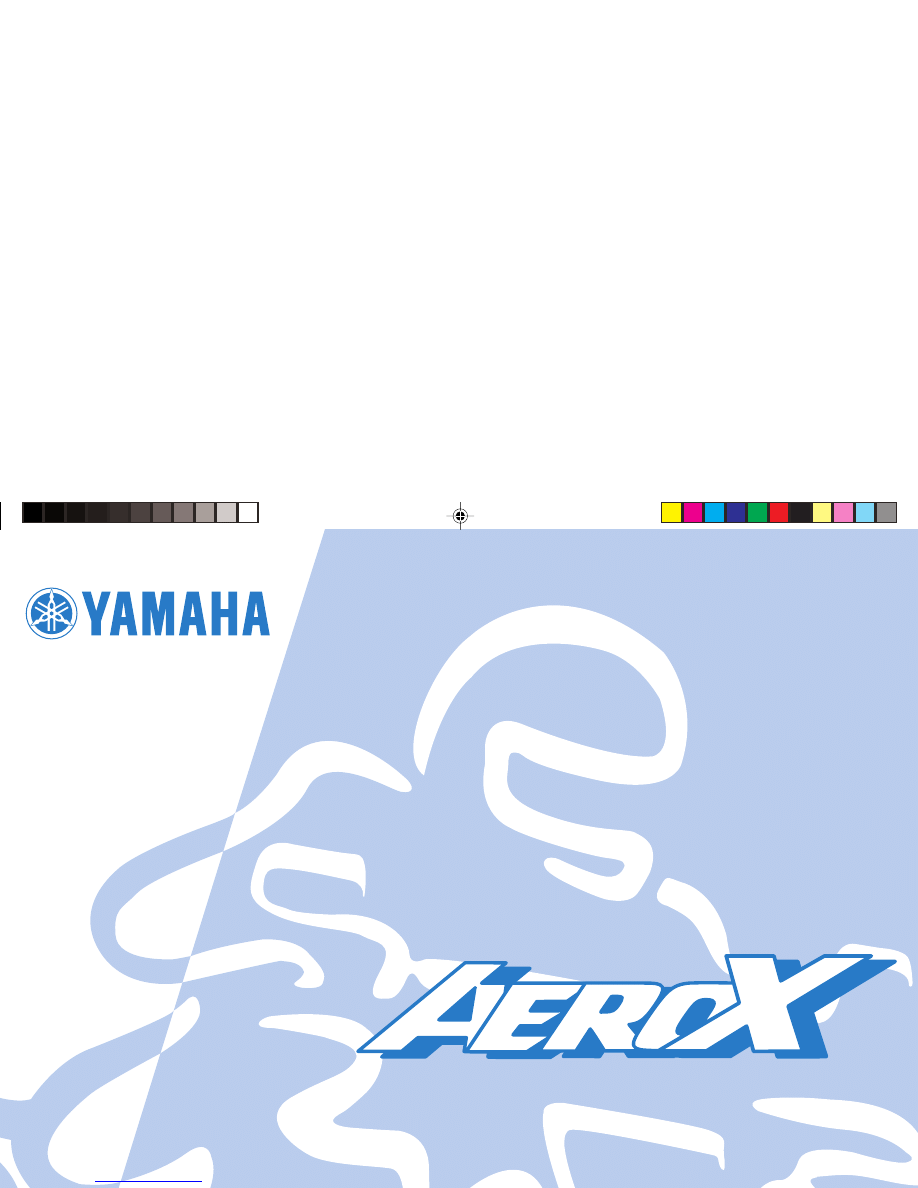
OWNER’S MANUAL
YQ50 / YQ50L
5WJ-F8199-E0
Ofrecido por www.electromanuales.com
manuals search engine

EAU04576
INTRODUCTION
Welcome to the Yamaha world of motorcycling!
As the owner of the YQ50 or YQ50L, you are benefiting from Yamaha's vast experience and newest technology regarding
the design and manufacture of high-quality products, which have earned Yamaha a reputation for dependability.
Please take the time to read this manual thoroughly, so as to enjoy all advantages of your YQ50 or YQ50L. The owner's
manual does not only instruct you in how to operate, inspect and maintain your scooter, but also in how to safeguard
yourself and others from trouble and injury.
In addition, the many tips given in this manual will help keep your scooter in the best possible condition. If you have any
further questions, do not hesitate to contact your Yamaha dealer.
The Yamaha team wishes you many safe and pleasant rides. So, remember to put safety first!
Ofrecido por www.electromanuales.com
manuals search engine
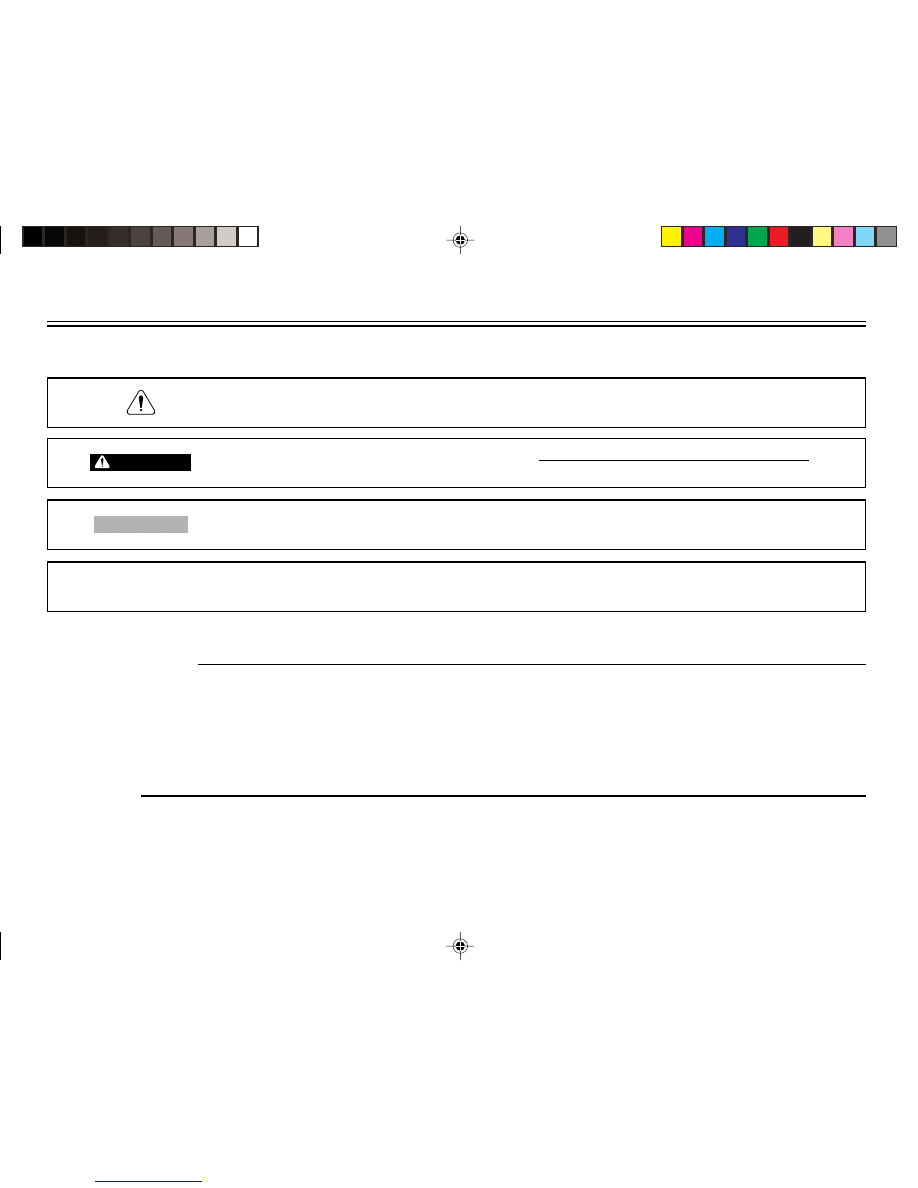
EAU00005
IMPORTANT MANUAL INFORMATION
Particularly important information is distinguished in this manual by the following notations:
The Safety Alert Symbol means ATTENTION! BECOME ALERT! YOUR SAFETY IS
INVOLVED!
Failure to follow WARNING instructions could result in severe injury or death to the
scooter operator, a bystander, or a person inspecting or repairing the scooter.
A CAUTION indicates special precautions that must be taken to avoid damage to the
scooter.
NOTE :
A NOTE provides key information to make procedures easier or clearer.
WARNING
CAUTION:
NOTE :
•
This manual should be considered a permanent part of this scooter and should remain with it even if the
scooter is subsequently sold.
•
Yamaha continually seeks advancements in product design and quality. Therefore, while this manual
contains the most current product information available at the time of printing, there may be minor
discrepancies between your scooter and this manual. If you have any questions concerning this manual,
please consult your Yamaha dealer.
Ofrecido por www.electromanuales.com
manuals search engine
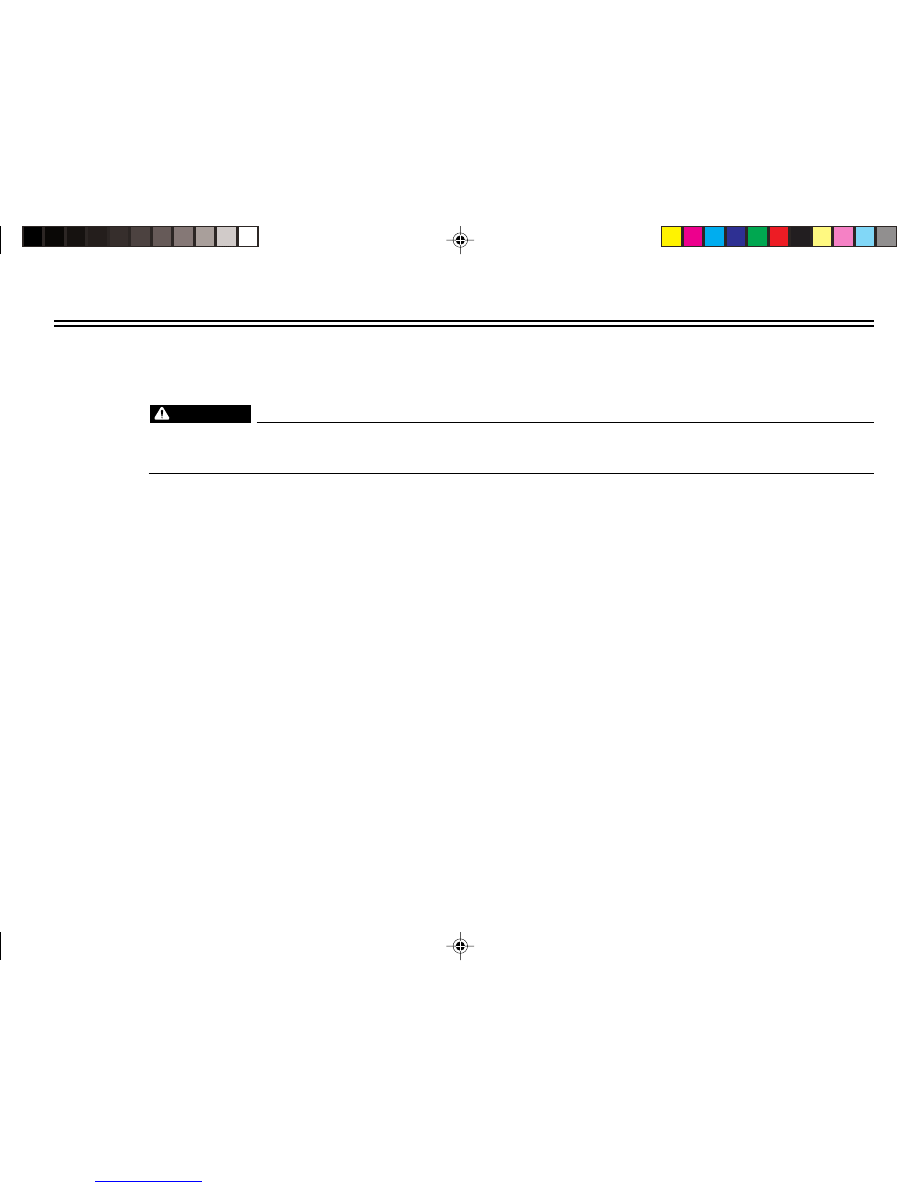
EW000002
PLEASE READ THIS MANUAL CAREFULLY AND COMPLETELY BEFORE OPERATING THIS
SCOOTER.
WARNING
IMPORTANT MANUAL INFORMATION
Ofrecido por www.electromanuales.com
manuals search engine
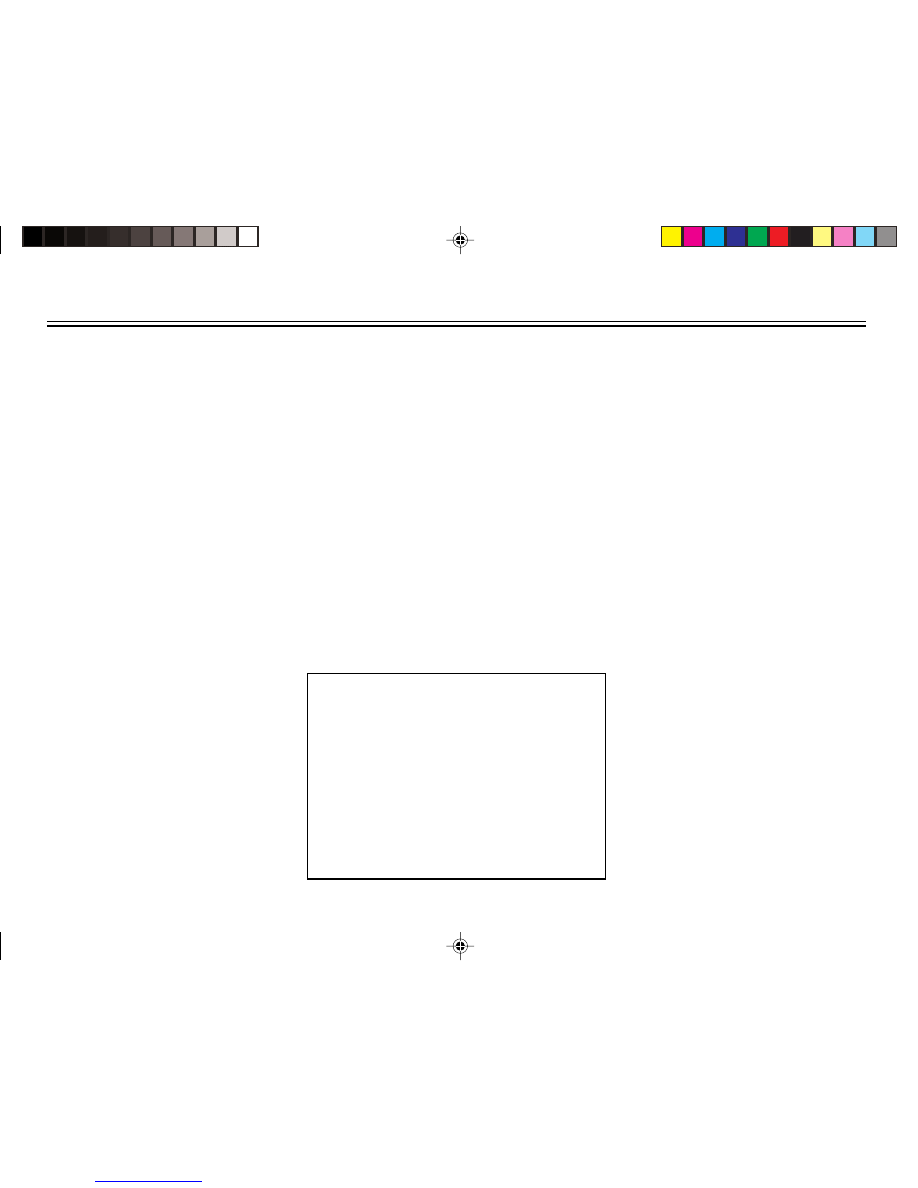
EAUM0023
YQ50 or YQ50L
OWNER'S MANUAL
© 2002 by MBK INDUSTRIE
1st Edition, July 2002
All rights reserved
Any reprinting or unauthorized use
without the written permission of
MBK INDUSTRIE
is expressly prohibited.
Printed in France.
Ofrecido por www.electromanuales.com
manuals search engine
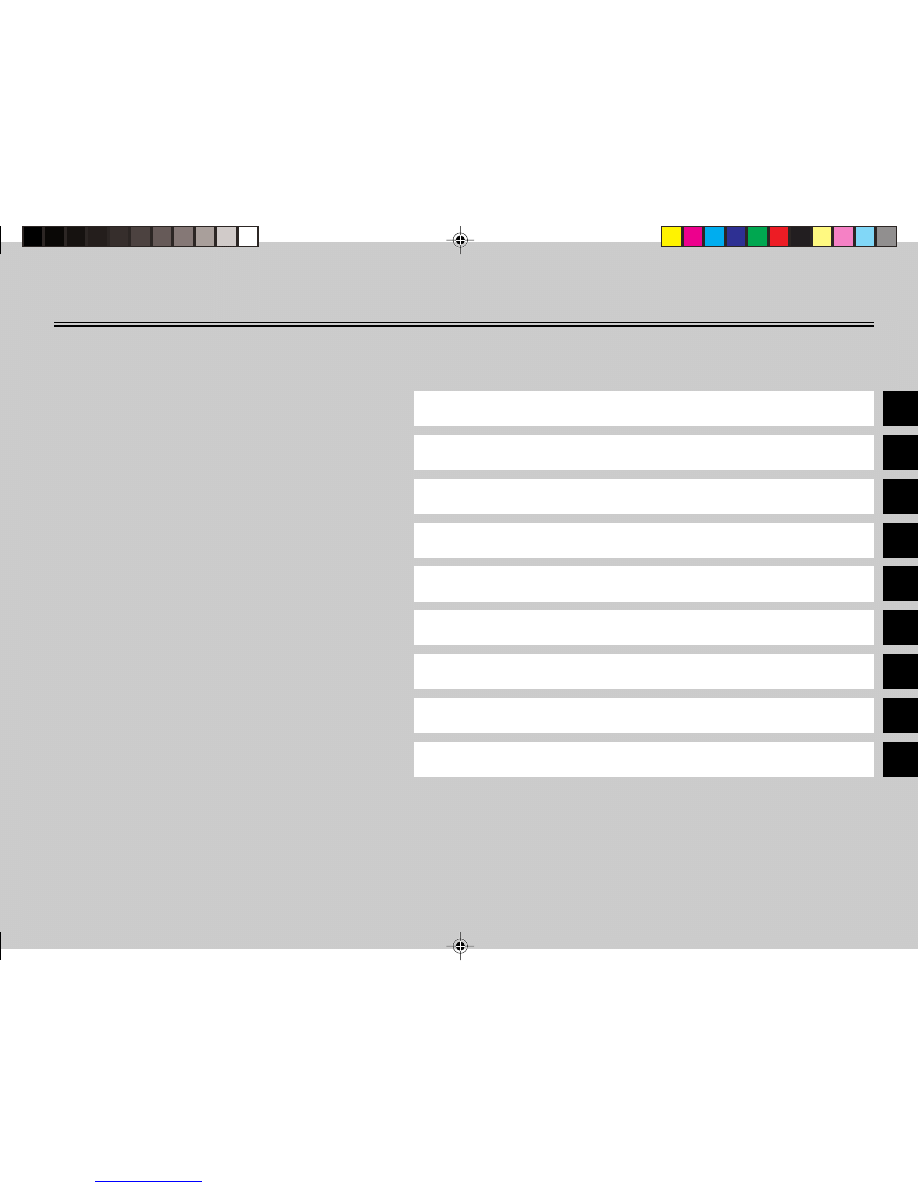
1
1
GIVE SAFETY THE RIGHT OF WAY
2
DESCRIPTION
3
INSTRUMENT AND CONTROL FUNCTIONS
4
PRE-OPERATION CHECKS
5
OPERATION AND IMPORTANT RIDING POINTS
6
PERIODIC MAINTENANCE AND MINOR REPAIR
7
SCOOTER CARE AND STORAGE
8
SPECIFICATIONS
9CONSUMER INFORMATION
EAU00009
TABLE OF CONTENTS
2
3
4
5
6
7
8
9
Ofrecido por www.electromanuales.com
manuals search engine
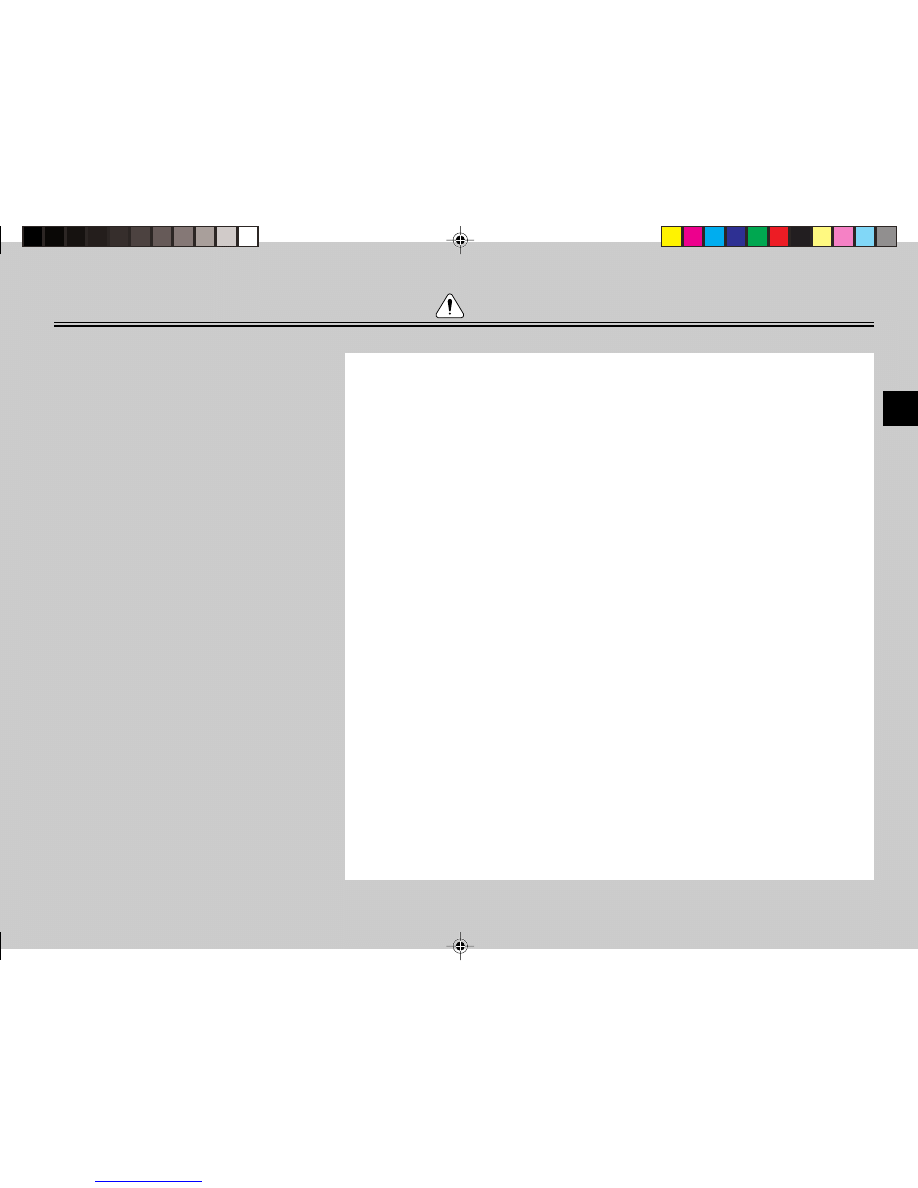
GIVE SAFETY THE RIGHT OF WAY .................................................. 1-1
Further safe-riding points .................................................................... 1-2
EAU00021
EW000015
GIVE SAFETY THE RIGHT OF WAY
1
Ofrecido por www.electromanuales.com
manuals search engine
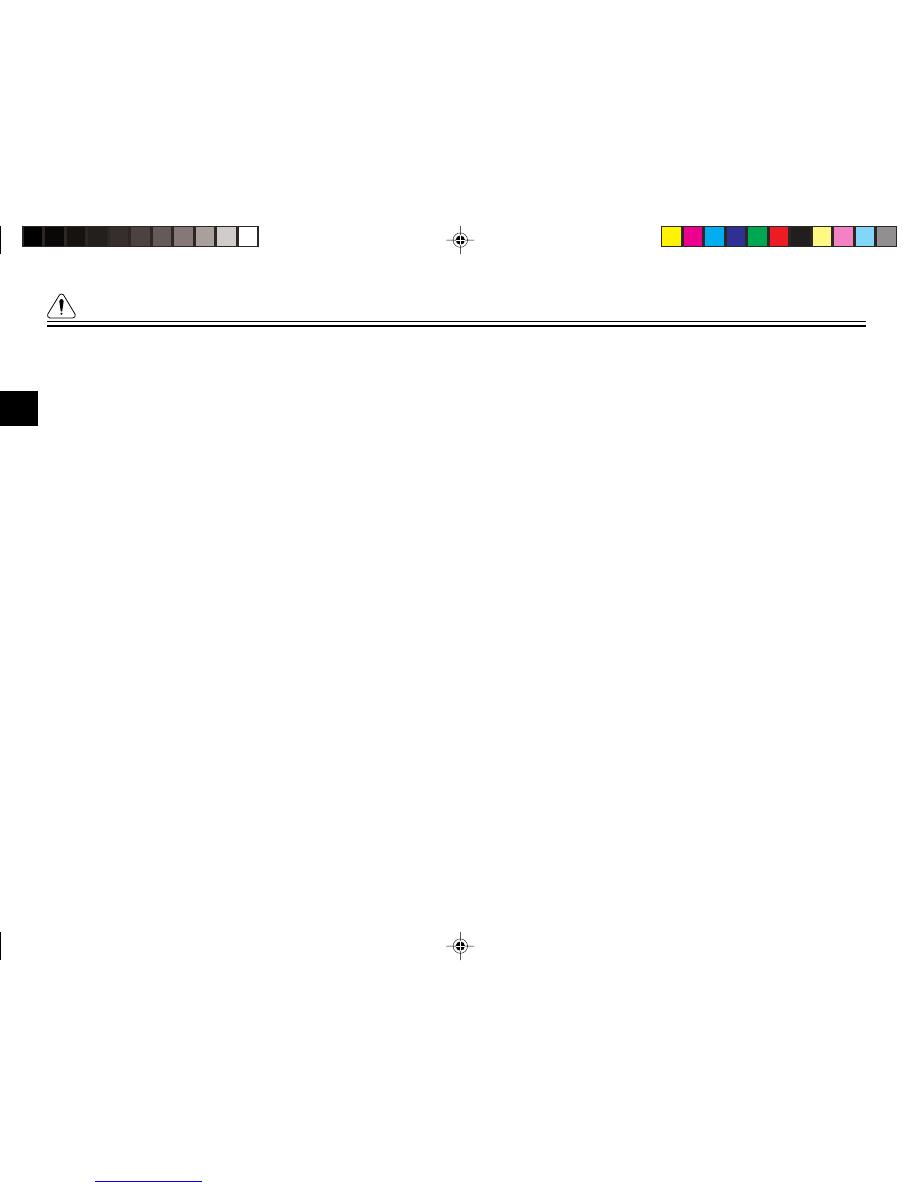
GIVE SAFETY THE RIGHT OF WAY
1
Scooters are fascinating vehicles, which can give you an unsurpassed feeling of power and freedom. However,
they also impose certain limits, which you must accept; even the best scooter does not ignore the laws of
physics.
Regular care and maintenance are essential for preserving value and operating condition of your scooter.
Moreover, what is true for the scooter is also true for the rider: good performance depends on being in good
shape. Riding under the influence of medication, drugs and alcohol is, of course, out of the question. Scooter
riders—more than car drivers—must always be at their mental and physical best. Under the influence of
even small amounts of alcohol, there is a tendency to take dangerous risks.
Protective clothing is as essential for the scooter rider as seat belts are for car drivers and passengers.
Always wear a complete scooter suit (whether made of leather or tear-resistant synthetic materials with
protectors), sturdy boots, scooter gloves and a properly fitting helmet. Optimum protective wear, however,
should not encourage carelessness. Although full-coverage helmets and suits, in particular, create an illu-
sion of total safety and protection, motorcyclists will always be vulnerable. Riders who lack critical self-
control run the risk of going too fast and are apt to take chances. This is even more dangerous in wet weather.
The good motorcyclist rides safely, predictably and defensively — avoiding all dangers, including those
caused by others.
Enjoy your ride!
1-1
Ofrecido por www.electromanuales.com
manuals search engine
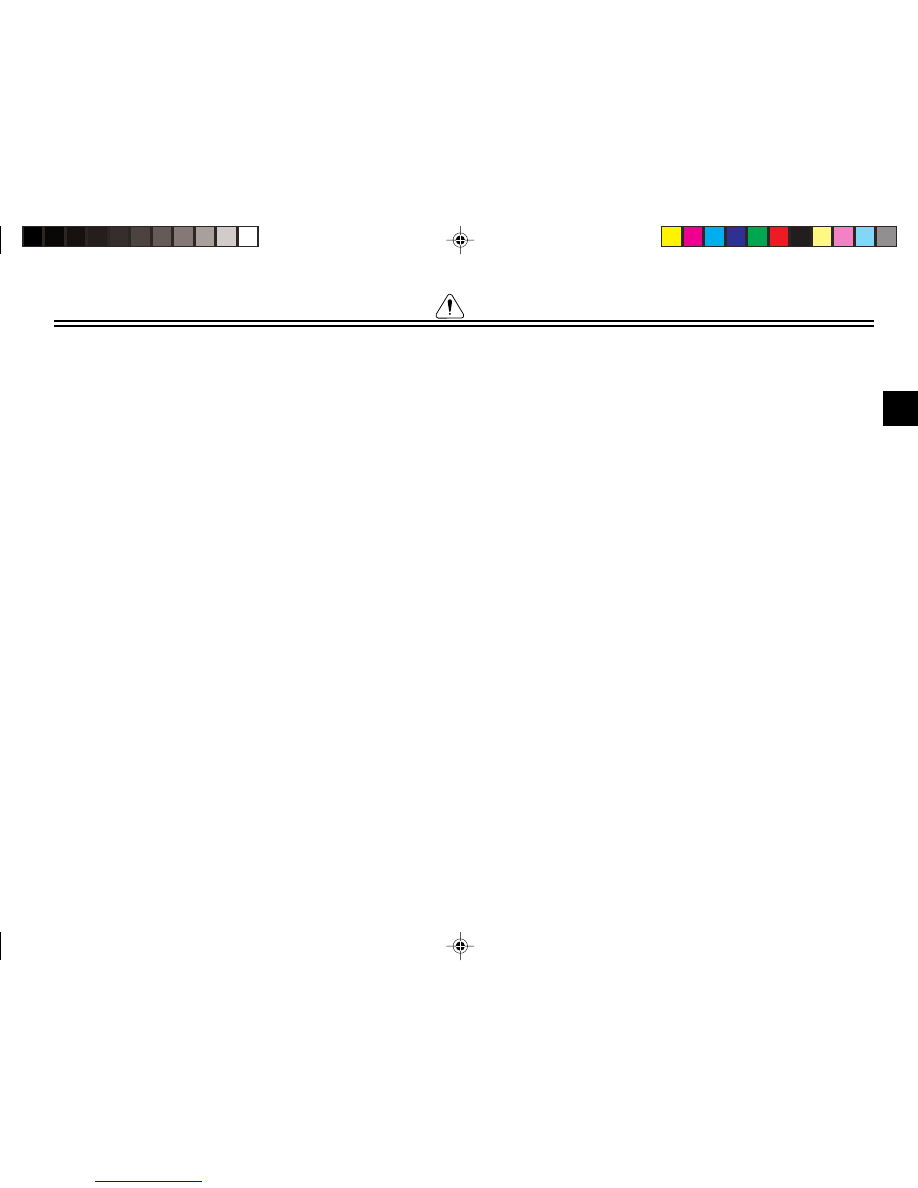
GIVE SAFETY THE RIGHT OF WAY
1
EAU03099
Further safe-riding points
•
Be sure to signal clearly when making turns.
•
Braking can be extremely difficult on a wet road. Avoid hard braking, because the scooter could slide.
Apply the brakes slowly when stopping on a wet surface.
•
Slow down as you approach a corner or turn. Once you have completed a turn, accelerate slowly.
•
Be careful when passing parked cars. A driver might not see you and open a door in your path.
•
Railroad crossings, streetcar rails, iron plates on road construction sites, and manhole covers become
extremely slippery when wet. Slow down and cross them with caution. Keep the scooter upright, otherwise
it could slide out from under you.
•
The brake pads could get wet when you wash the scooter. After washing the scooter, check the brakes
before riding.
•
Always wear a helmet, gloves, trousers (tapered around the cuff and ankle so they do not flap), and a
bright colored jacket.
•
Do not carry too much luggage on the scooter. An overloaded scooter is unstable.
1-2
Ofrecido por www.electromanuales.com
manuals search engine
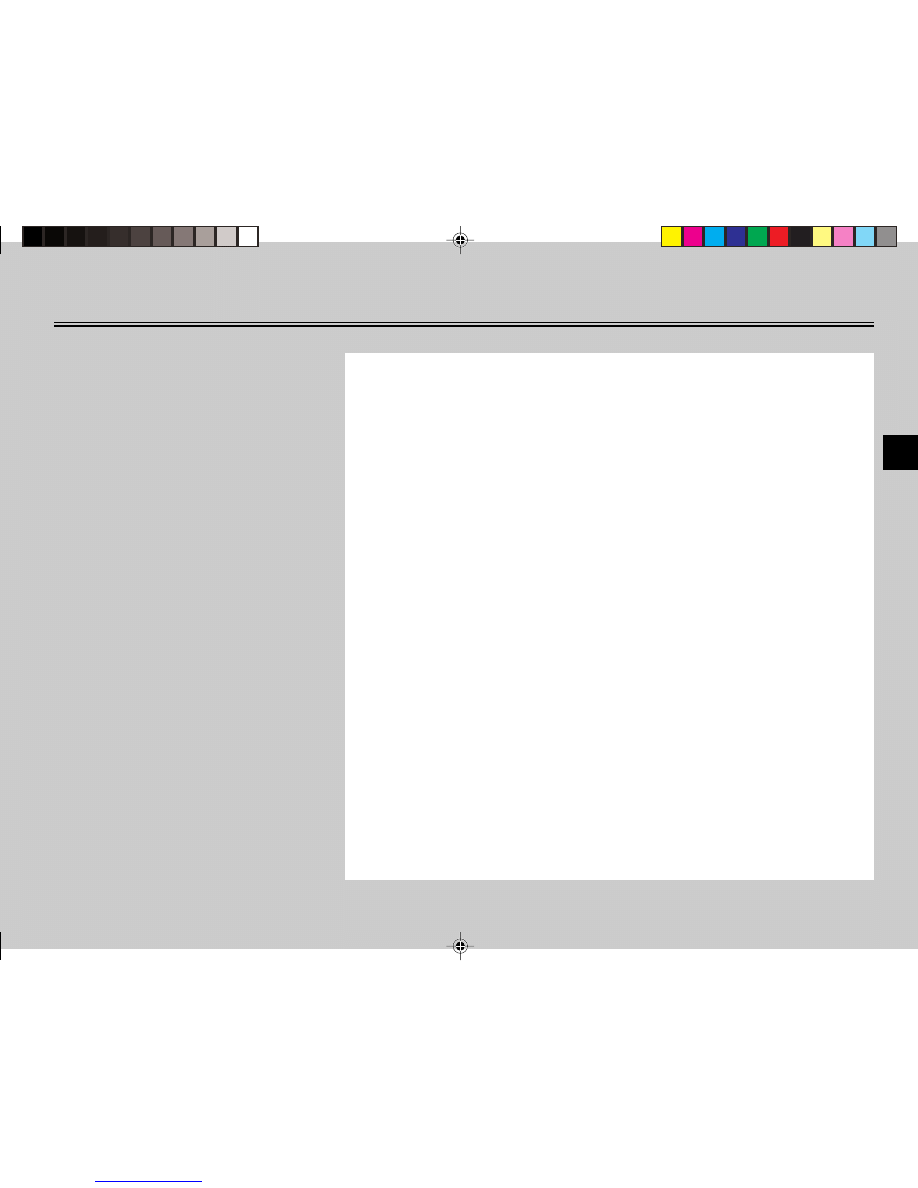
EAU01161
DESCRIPTION
Left view .............................................................................................. 2-1
Right view ............................................................................................ 2-2
2
Ofrecido por www.electromanuales.com
manuals search engine
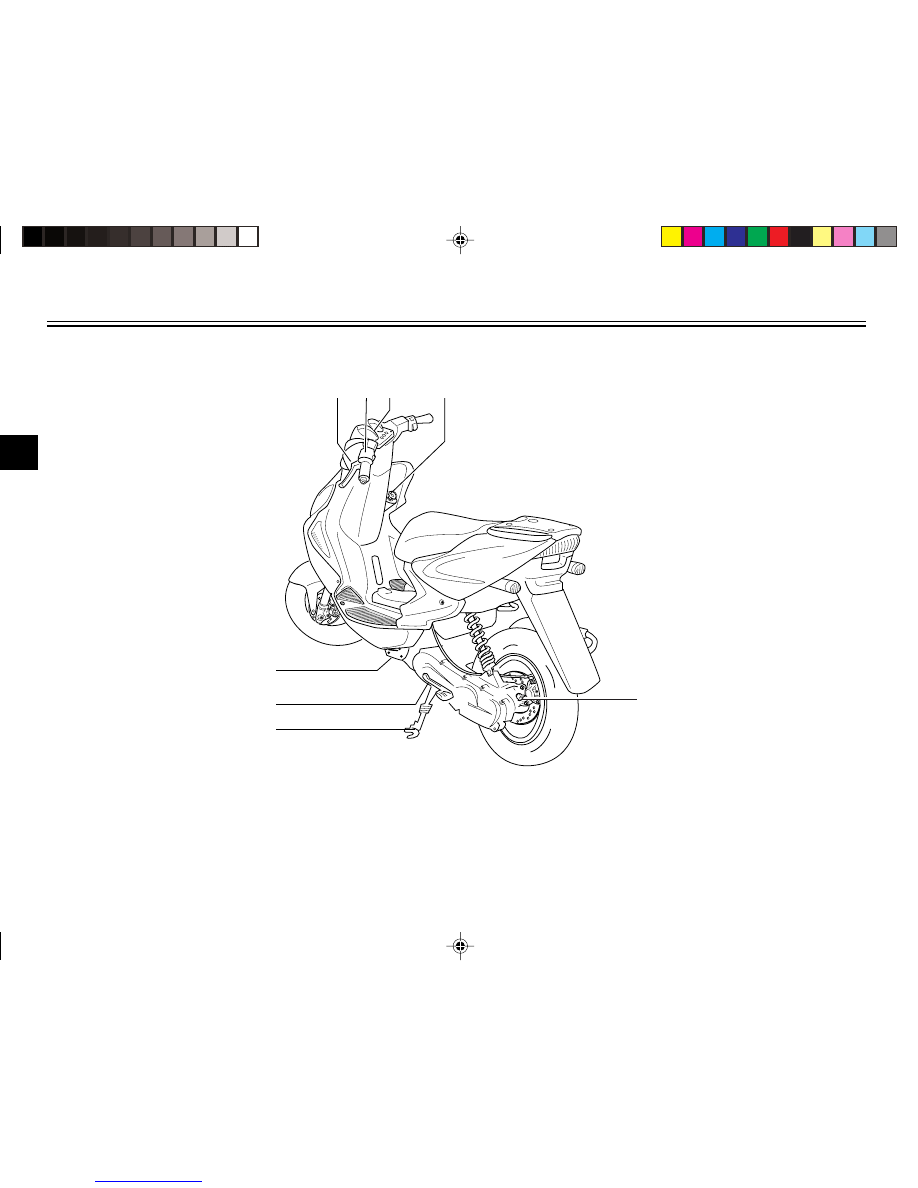
2
DESCRIPTION
Left view
1. Rear brake lever
(page 3-5, 6-13, 6-16)
2. Left handlebar switches
(page 3-4)
3. Speedometer
(page 3-3)
4. Main switch/steering lock
(page 3-1, 3-9)
2-1
1
2 3
4
6
8
7
5
5. Final transmission oil filler cap
(page 6-7)
6. Centerstand
(page 6-16)
7. Kick starter
(page 3-7)
8. Air filter
(page 6-9)
Ofrecido por www.electromanuales.com
manuals search engine
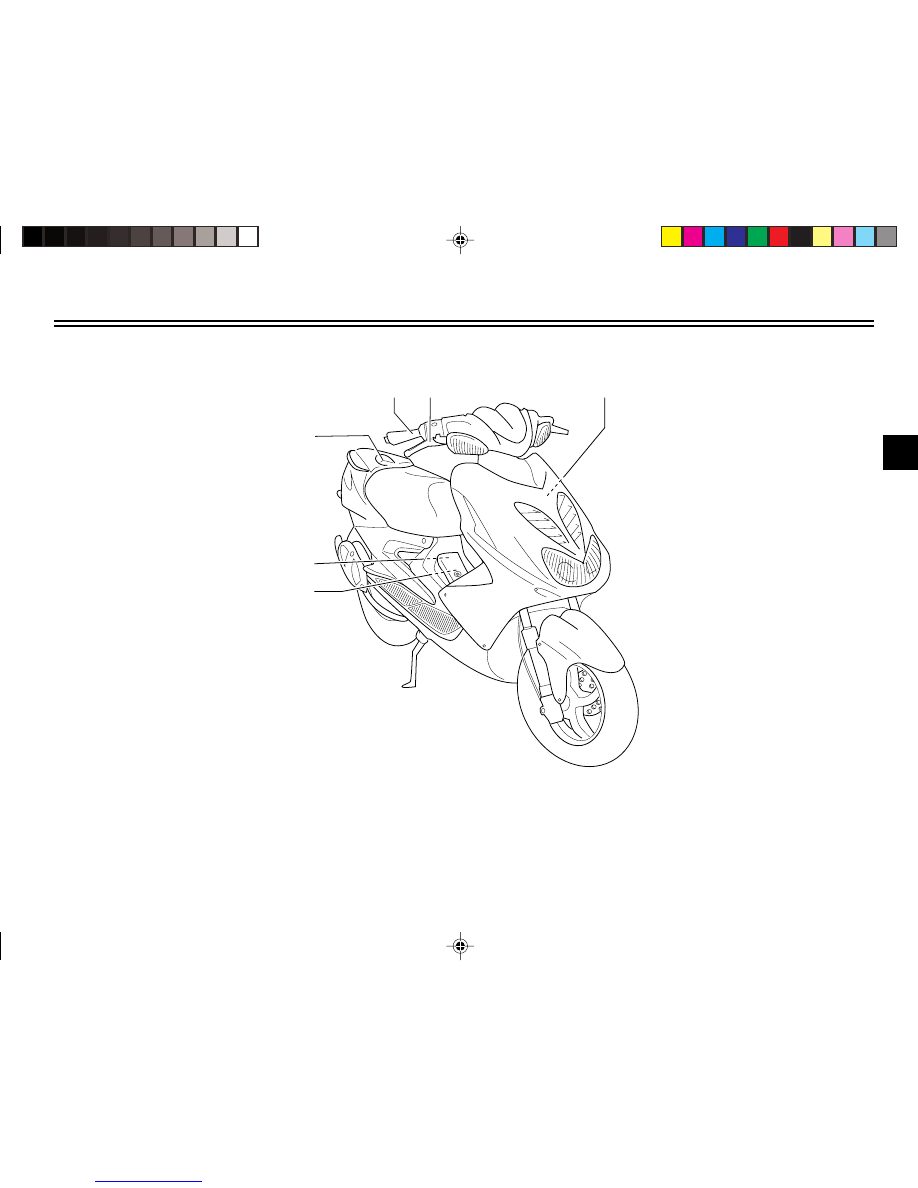
2
DESCRIPTION
Right view
9
10
14
11
12
13
9. Throttle grip
(page 6-11)
10. Front brake lever
(page 3-5, 6-13, 6-16)
11. Coolant tank location
(page 6-8)
12. Battery/fuse
(page 6-18 - 6-20)
2-2
13. Oil tank cap location
(page 3-8)
14. Fuel tank cap
(page 3-5)
Ofrecido por www.electromanuales.com
manuals search engine
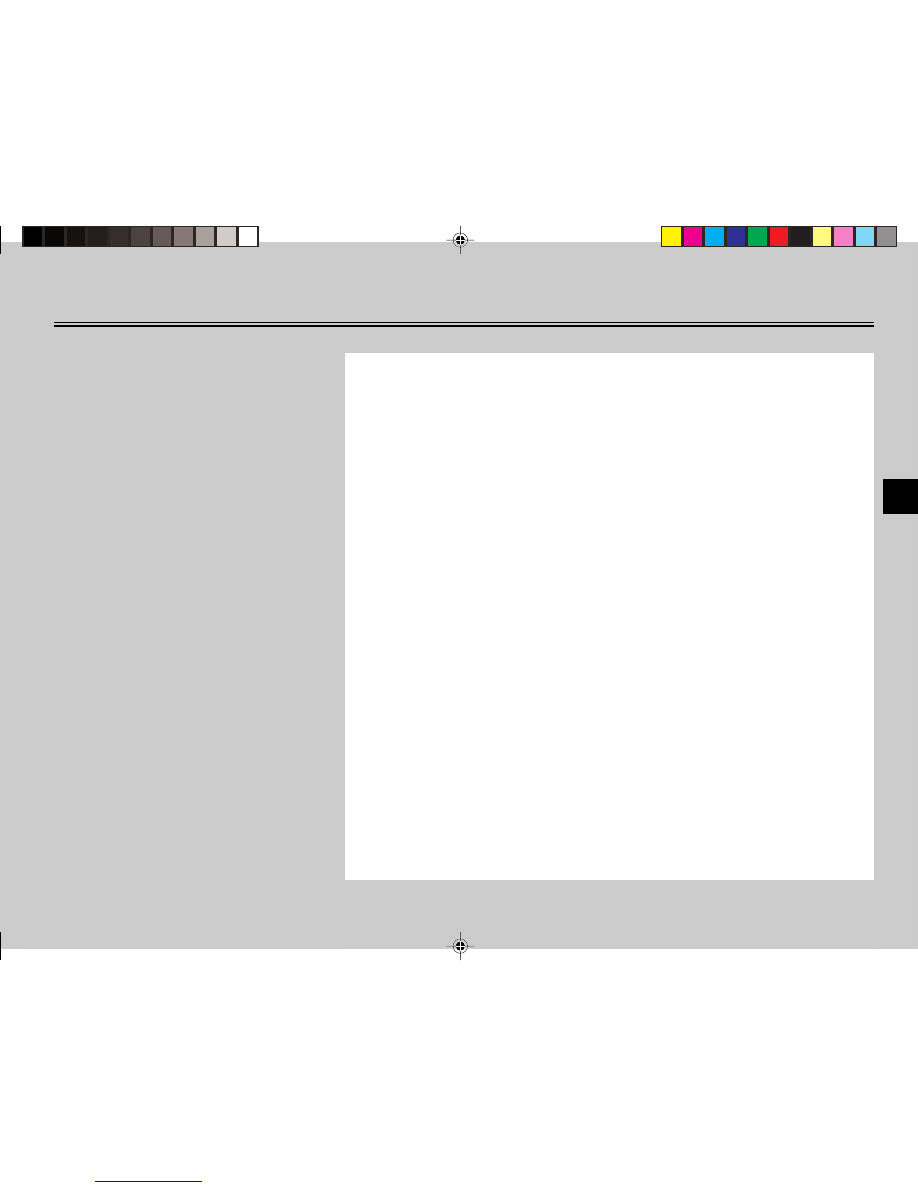
EAU00027
INSTRUMENT AND CONTROL FUNCTIONS
Main switch / steering lock .................................................................. 3-1
Indicator and warning lights ................................................................ 3-2
Coolant temperature warning light ...................................................... 3-2
Speedometer unit ................................................................................ 3-3
Tachometer (depends on model) ........................................................ 3-3
Fuel gauge .......................................................................................... 3-3
Handlebar switches ............................................................................. 3-4
Front brake lever ................................................................................. 3-5
Rear brake lever .................................................................................. 3-5
Fuel tank cap ...................................................................................... 3-5
Fuel ..................................................................................................... 3-6
Catalytic converter .............................................................................. 3-7
Kick starter .......................................................................................... 3-7
2-stroke engine oil tank cap ................................................................ 3-8
2-stroke engine oil ............................................................................... 3-8
Starter (choke) lever ............................................................................ 3-9
Rider seat ............................................................................................ 3-9
Storage compartment A .................................................................... 3-10
Storage compartment B .................................................................... 3-11
Adjusting the shock absorber assembly (depends on model) ........... 3-11
3
Ofrecido por www.electromanuales.com
manuals search engine
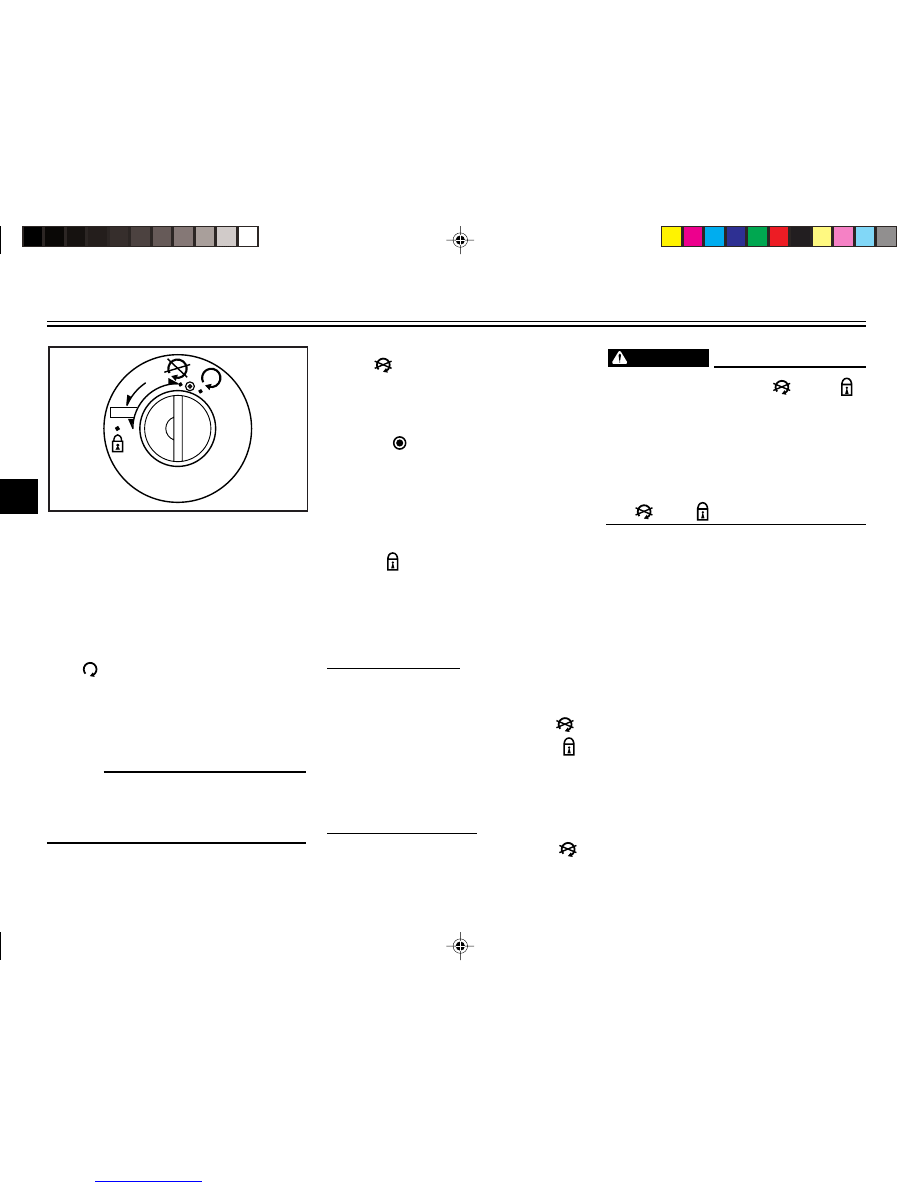
3
INSTRUMENT AND CONTROL FUNCTIONS
EAU00029
Main switch/steering lock
The main switch/steering lock controls
the ignition and lighting systems, and
is used to lock the steering. The various
positions are described below.
PUSH
OPEN
ZAUM0253
EAU00038
OFF “
”
All electrical systems are off. The key
can be removed.
EAU04470
CHECK “
”
The 2-stroke engine oil level warning
light should come on. See page 3-2 for
an explanation of the engine oil level
warning light.
EAU00040
LOCK “ ”
The steering is locked, and all electrical
systems are off. The key can be
removed.
To lock the steering
1. Turn the handlebars all the way to
the left.
2. Push the key in from the “
”
position, and then turn it to “
”
while still pushing it.
3. Remove the key.
To unlock the steering
Push the key in, and then turn it to “
”
while still pushing it.
EW000016
Never turn the key to “
” or “ ”
while the scooter is moving, otherwise
the electrical systems will be switched
off, which may result in loss of control
or an accident. Make sure that the scoo-
ter is stopped before turning the key
to “
” or “ ”.
WARNING
3-1
EAU00037
ON “
”
All electrical circuits are supplied with
power, and the engine can be started.
The key cannot be removed.
NOTE :
The headlight, meter lighting and
taillight come on automatically when the
engine is started.
Ofrecido por www.electromanuales.com
manuals search engine
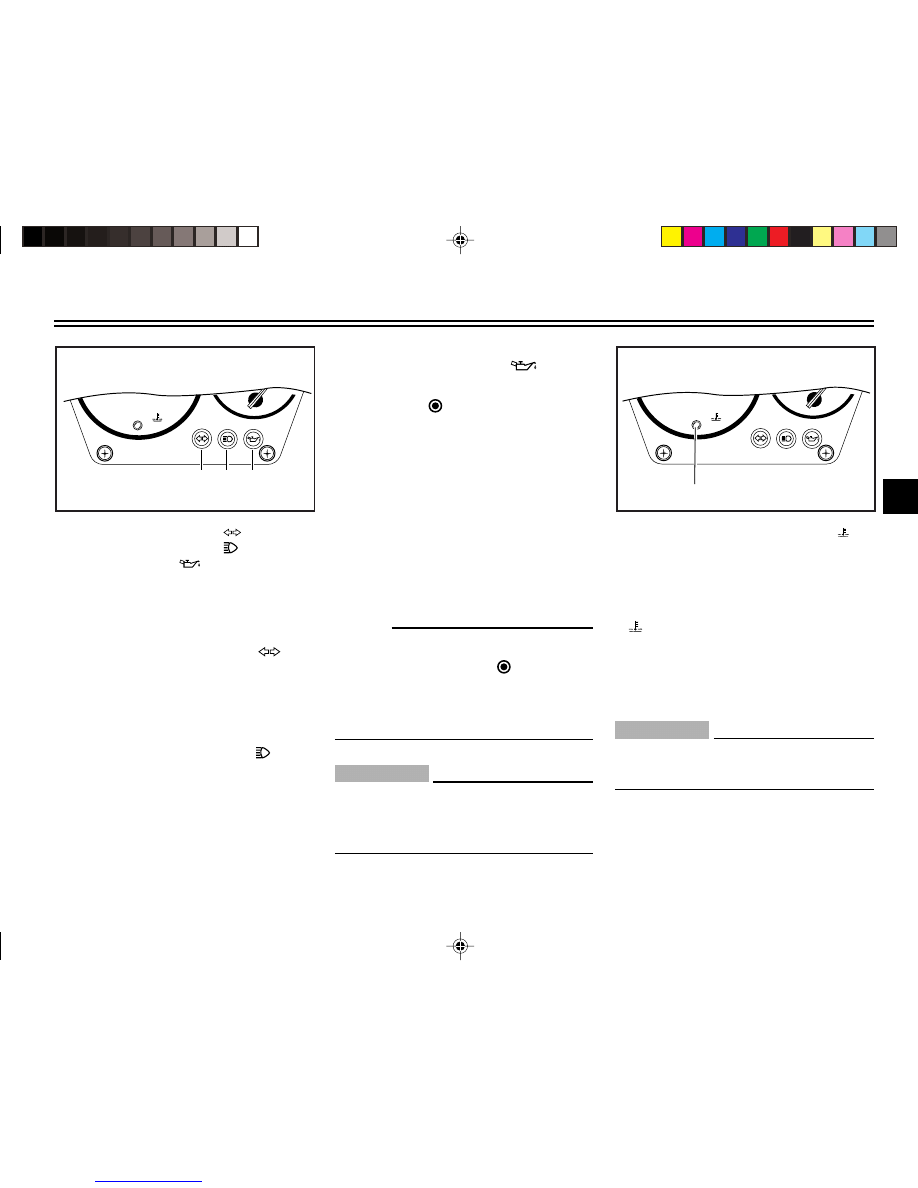
INSTRUMENT AND CONTROL FUNCTIONS
3
EAU03034
Indicator and warning lights
TEMP
1
2
3
ZAUM0254
1. Turn signal indicator light “
”
2. High beam indicator light “
”
3. Oil indicator light “
”
EAU00057
Turn signal indicator light “
”
This indicator light flashes when the
turn signal switch is pushed to the left
or right.
EAU00063
High beam indicator light “
”
This indicator light comes on when the
high beam of the headlight is switched
on.
EAU02958
Oil level warning light “
”
This warning light comes on when the
key is in the “
” position or when the
oil level in the 2-stroke engine oil tank
is low during operation. If the warning
light comes on during operation, stop
immediately and fill the oil tank with
Yamalube 2 or equivalent 2-stroke
engine oil of either JASO grade "FC"
or ISO grades "EG-C" or "EG-D". The
warning light should go off after the 2-
stroke engine oil tank has been refilled.
NOTE :
If the warning light does not come on
when the key is in the “
” position or
does not go off after the 2-stroke engine
oil tank has been refilled, have a Yamaha
dealer check the electrical circuit.
EC000000
Do not operate the scooter until you
know that the engine oil level is
sufficient.
CAUTION:
EAU01716
Coolant temperature warning light
“
”
This warning light comes on when the
engine overheats. When this occurs,
stop the engine immediately and allow
the engine to cool.
EC000002
Do not operate the engine if it is
overheated.
CAUTION:
TEMP
1
ZAUM0255
1. Coolant temperature warning light “
”
3-2
Ofrecido por www.electromanuales.com
manuals search engine
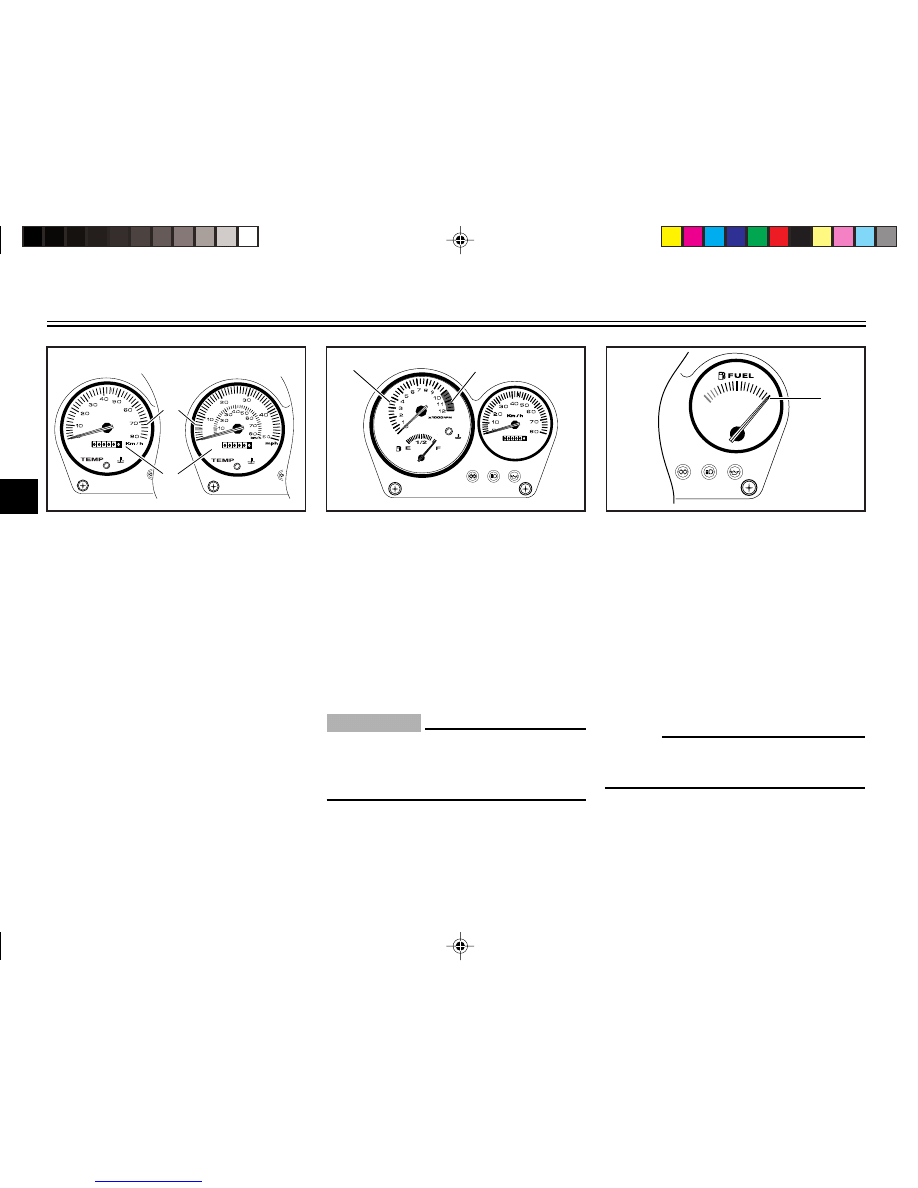
3
INSTRUMENT AND CONTROL FUNCTIONS
EAU00098
Speedometer unit
The speedometer unit is equipped with
a speedometer and an odometer. The
speedometer shows riding speed. The
odometer shows the total distance
traveled.
EAU00113
Fuel gauge
The fuel gauge indicates the amount of
fuel in the fuel tank. The needle moves
towards "E" (Empty) as the fuel level
decreases. When the needle reaches
"E", refuel as soon as possible.
NOTE :
Do not allow the fuel tank to empty itself
completely.
E
1/2
F
1
ZAUM0257
1. Speedometer
2. Odometer
1. Fuel gauge
3-3
1
2
ZAUM0292M
1. Tachometer
2. Red zone
EAU00101
Tachometer
(Depends on model)
The electric tachometer allows the ri-
der to monitor the engine speed and
keep it within the ideal power range.
EC000003
Do not operate the engine in the
tachometer red zone.
Red zone: 10.000 r/min and above
CAUTION:
2
1
ZAUM0291M
UK ONLY
Ofrecido por www.electromanuales.com
manuals search engine
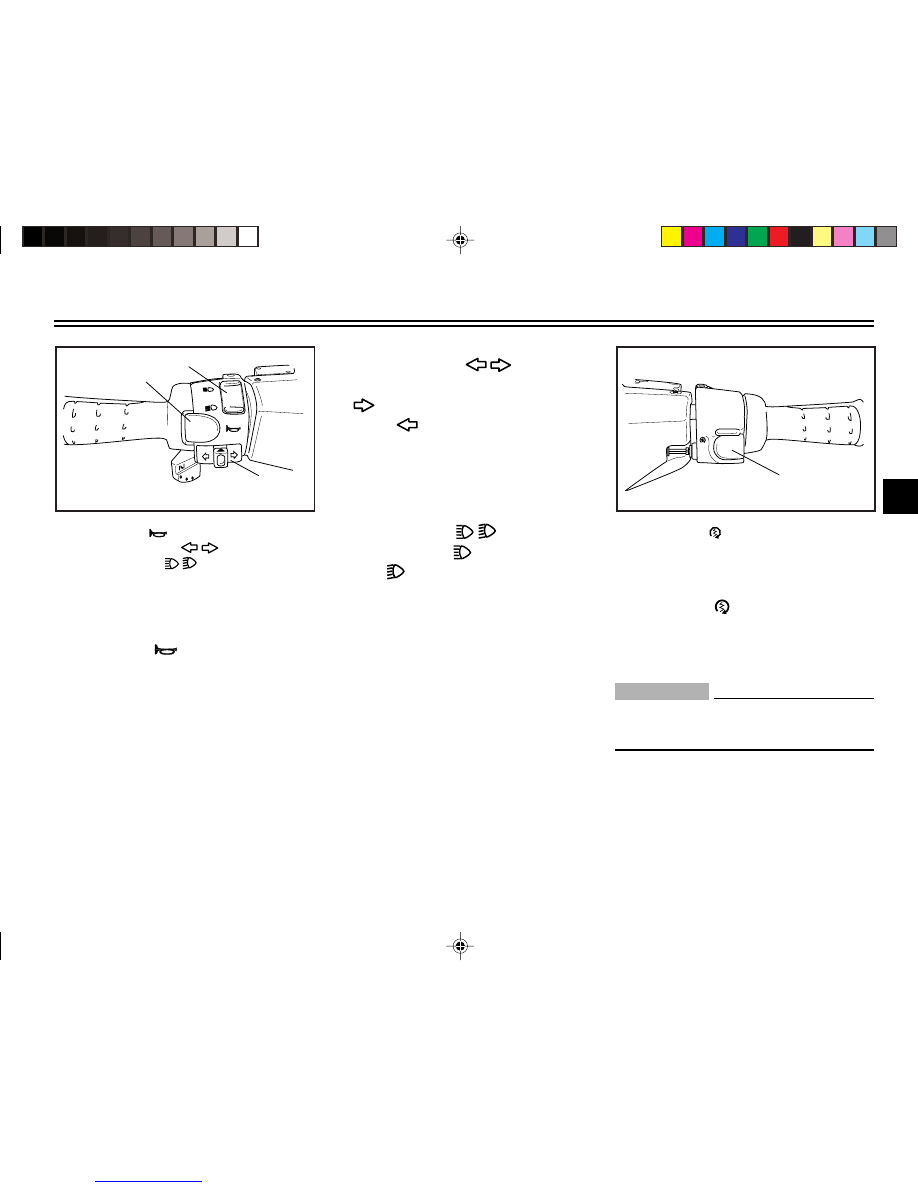
INSTRUMENT AND CONTROL FUNCTIONS
3
EAU00118
Handlebar switches
EAU03888
Dimmer switch “
/
”
Set this switch to “
” for the high beam
and to “
” for the low beam.
EAU03889
Turn signal switch “
/
”
To signal a right-hand turn, push this switch
to “
”. To signal a left-hand turn, push this
switch to “
”. When released, the switch
returns to the center position. To cancel the
turn signal lights, push the switch in after it
has returned to the center position.
EAU00129
Horn switch “
”
Press this switch to sound the horn.
EAUM0063
Start switch “
”
Push this switch while applying the front
or rear brake to crank the engine with
the starter.
EC000005
See page 5-2 for starting instruc-
tions prior to starting the engine.
1
2
3
ZAUM0258
1
ZAUM0261
1. Horn switch “
”
2. Turn signal switch “
/
”
3. Dimmer switch “
/
”
CAUTION:
1. Start switch “
”
3-4
Ofrecido por www.electromanuales.com
manuals search engine
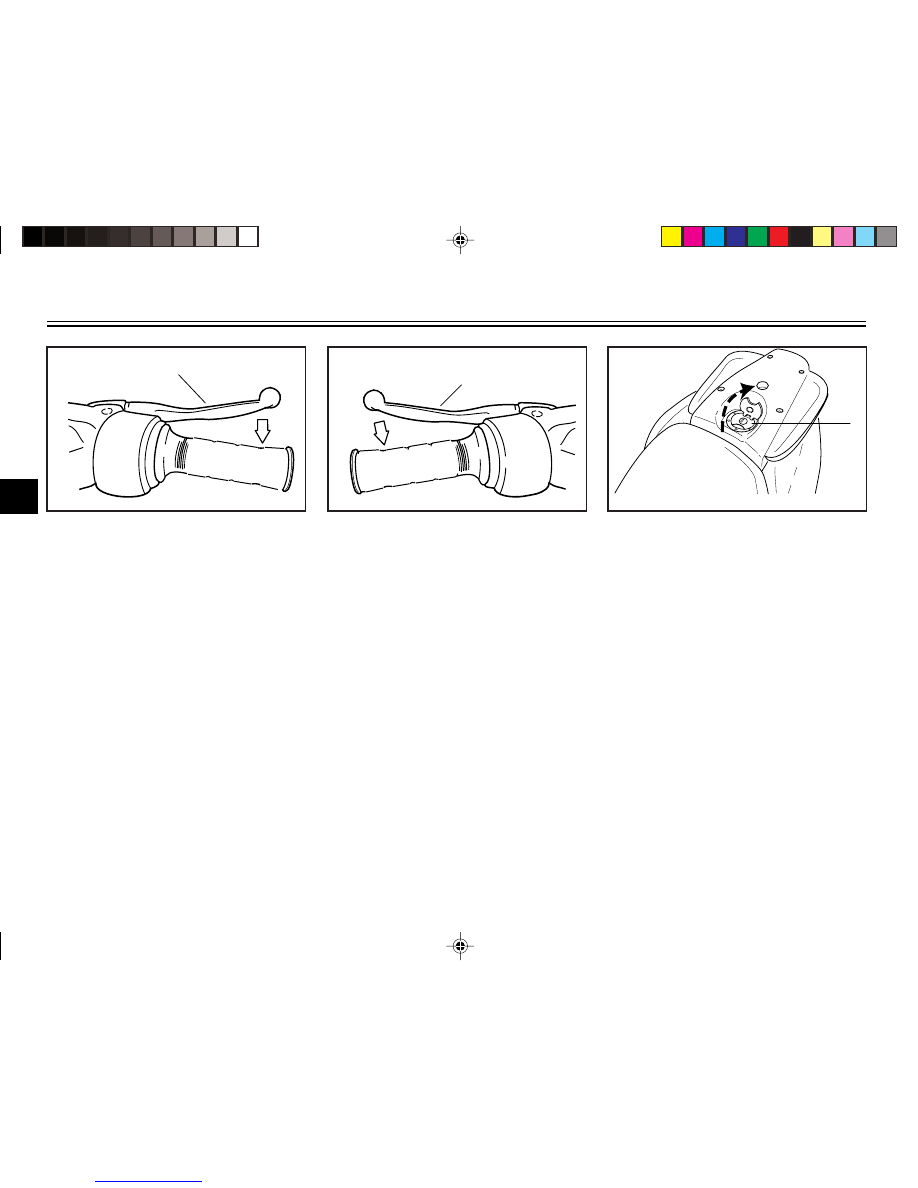
3
INSTRUMENT AND CONTROL FUNCTIONS
EAU03882
Front brake lever
The front brake lever is located on the
right handlebar grip. To apply the front
brake, pull this lever toward the
handlebar grip.
EAU00163
Rear brake lever
The rear brake lever is located on the
left handlebar grip. To apply the rear
brake, pull this lever toward the
handlebar grip.
1. Front brake lever
1. Rear brake lever
1
ZAUM0084
1
ZAUM0085
EAU02935*
Fuel tank cap
To open the fuel tank cap
Open the fuel tank cap lock cover, insert
the key into the lock, and then turn it 1/4
turn counterclockwise. The lock will be
released and the fuel tank cap can be
opened.
1
ZAUM0262
3-5
1. Fuel tank cap
Ofrecido por www.electromanuales.com
manuals search engine
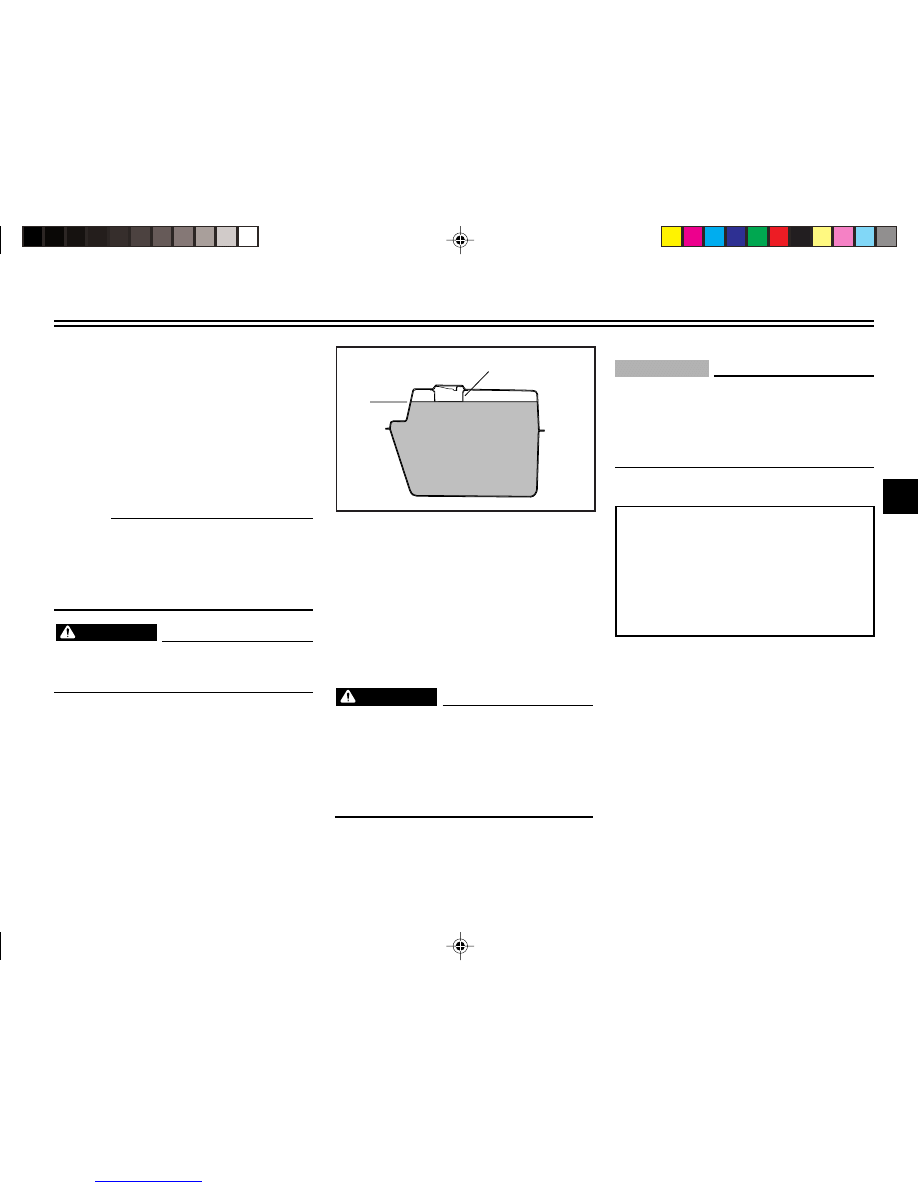
INSTRUMENT AND CONTROL FUNCTIONS
3
To close the fuel tank cap
1. Push the fuel tank cap into posi-
tion with the key inserted in the
lock.
2. Turn the key clockwise to the ori-
ginal position, remove it, and then
close the lock cover.
NOTE :
The fuel tank cap cannot be closed
unless the key is in the lock. In addi-
tion, the key cannot be removed if the
cap is not properly closed and locked.
EWA00025
Make sure that the fuel tank cap is
properly closed before riding.
WARNING
EAU03753
Fuel
Make sure that there is sufficient fuel
in the tank. Fill the fuel tank to the
bottom of the filler tube as shown.
EW000130
•
Do not overfill the fuel tank,
otherwise it may overflow when
the fuel warms up and expands.
•
Avoid spilling fuel on the hot
engine.
WARNING
1
2
ZAUM0020
1. Filler tube
2. Fuel level
EAU00185
EC000008
Immediately wipe off spilled fuel with
a clean, dry, soft cloth, since fuel may
deteriorate painted surfaces or plas-
tic parts.
CAUTION:
EAU04206
Recommended fuel:
REGULAR
UNLEADED
GASOLINE ONLY
Fuel tank capacity:
Total amount:
7 L
Your Yamaha engine has been
designed to use regular unleaded
gasoline with a research octane
number of 91 or higher. If knocking (or
pinging) occurs, use a gasoline of a
different brand or premium unleaded
fuel. Use of unleaded fuel will extend
spark plug life and reduce maintenance
costs.
3-6
Ofrecido por www.electromanuales.com
manuals search engine
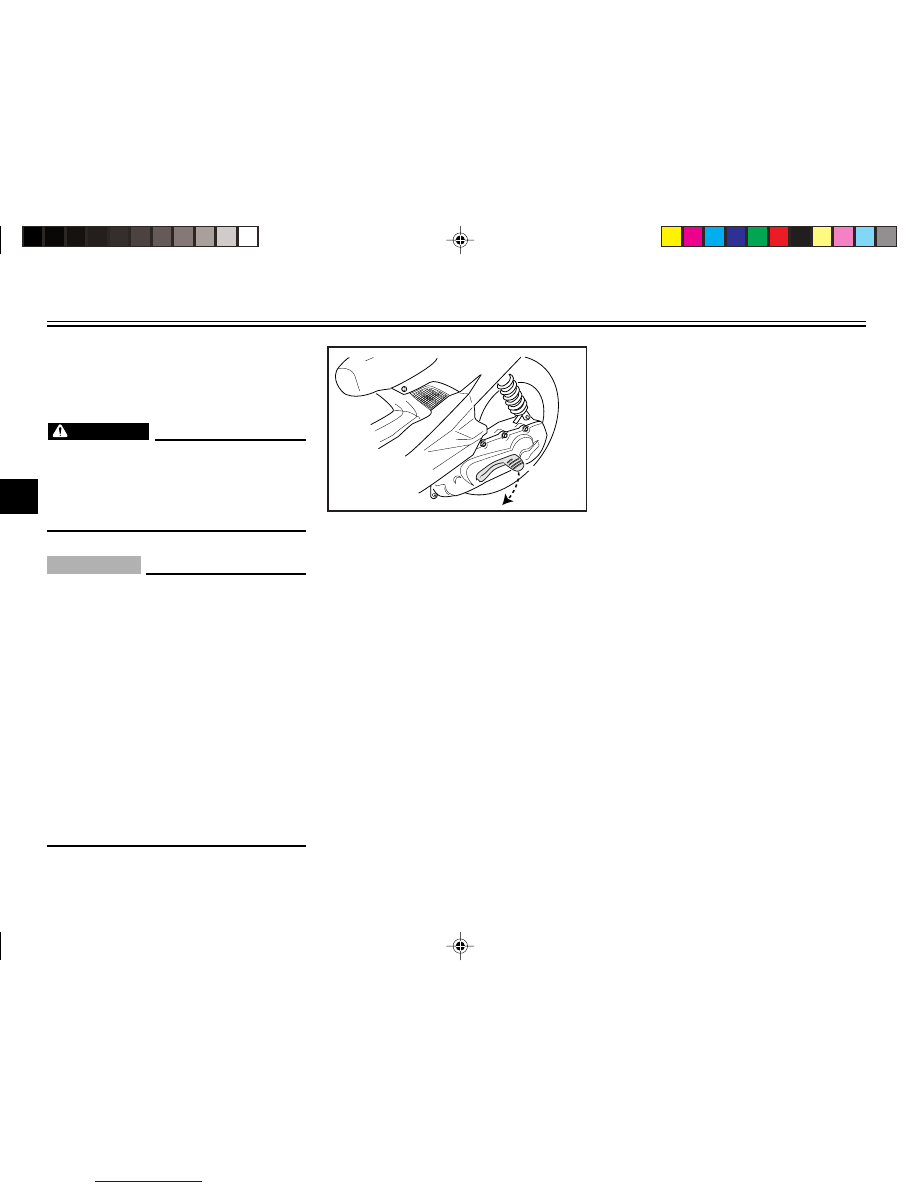
3
INSTRUMENT AND CONTROL FUNCTIONS
EAU03098
Catalytic converter
This scooter is equipped with a catalytic
converter in the muffler.
EW000128
The exhaust system is hot after
operation. Make sure that the
exhaust system has cooled down
before doing any maintenance work.
EC000114
The following precautions must be
observed to prevent a fire hazard or
other damages.
•
Use only unleaded gasoline.
The use of leaded gasoline will
cause unrepairable damage to
the catalytic converter.
•
Never park the scooter near
possible fire hazards such as
grass or other materials that
easily burn.
•
Do not allow the engine to idle
too long.
WARNING
CAUTION:
3-7
ZAUM0289M
EAUS0015
Kickstarter
To start the engine, push the kickstarter
down lightly with your foot until the
gears engage, and then push it down
smoothly but forcefully.
Ofrecido por www.electromanuales.com
manuals search engine
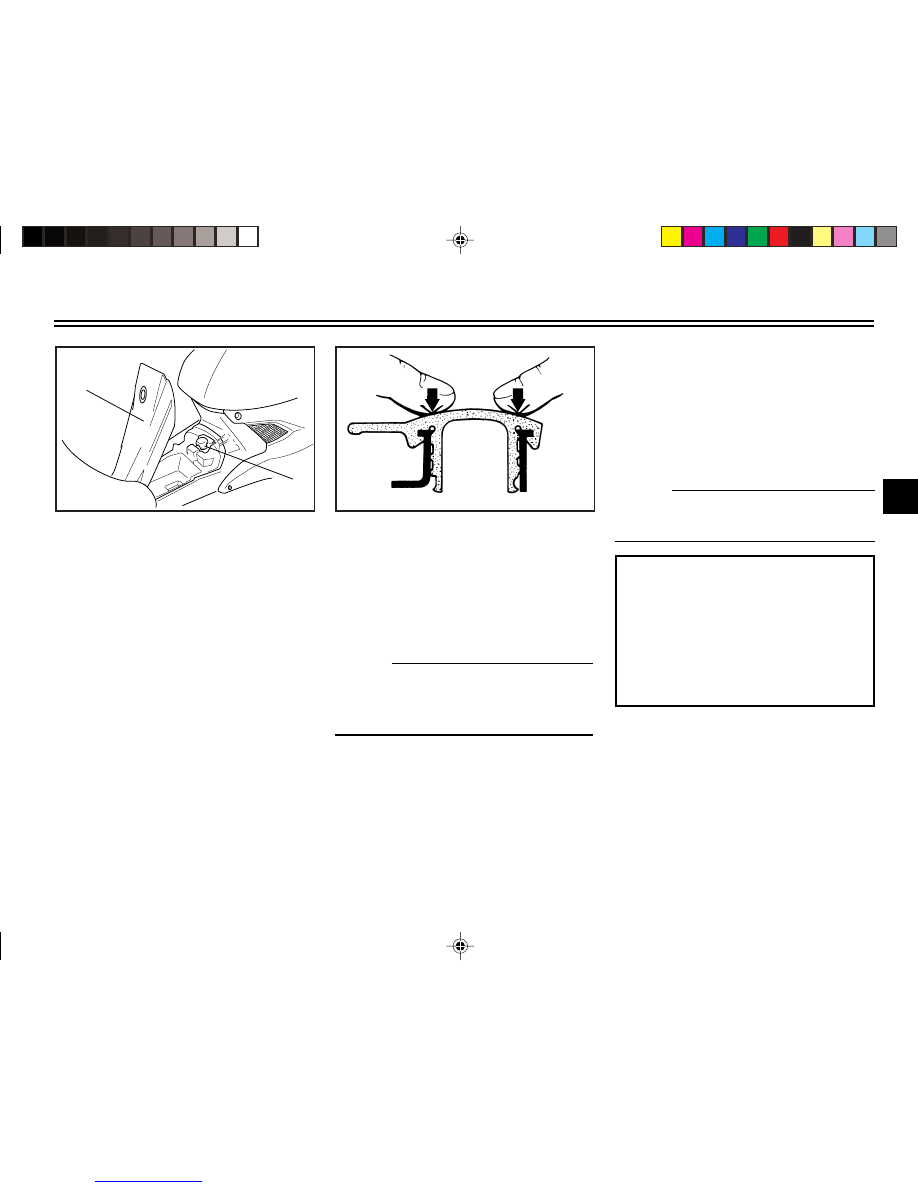
INSTRUMENT AND CONTROL FUNCTIONS
3
ZAUM0204
1
2
ZAUM0263
1. Storage compartment B
2. Oil tank cap
3-8
EAU03750
2-stroke engine oil
Make sure that there is sufficient oil in
the 2-stroke engine oil tank. Add the
recommended 2-stroke engine oil if
necessary.
NOTE :
Make sure that the 2-stroke engine oil
tank cap is properly installed.
Recommended oil:
Yamalube 2
or equivalent 2-stroke engine oil
(JASO grade "FC", or ISO
grades "EG-C" or "EG-D")
Oil quantity:
1.3 L
EAUM0082
2-stroke engine oil tank cap
The 2-stroke engine oil tank cap is
located in the storage compartment.
(See page 3-11 for storage
compartment opening and closing
procedures.)
1. To remove the 2-stroke engine oil
tank cap, pull it off.
2. To install the 2-stroke engine oil
tank cap, push it into the oil tank
opening.
NOTE :
Make sure that the 2-stroke engine oil
tank cap is properly installed before
riding the scooter.
Ofrecido por www.electromanuales.com
manuals search engine
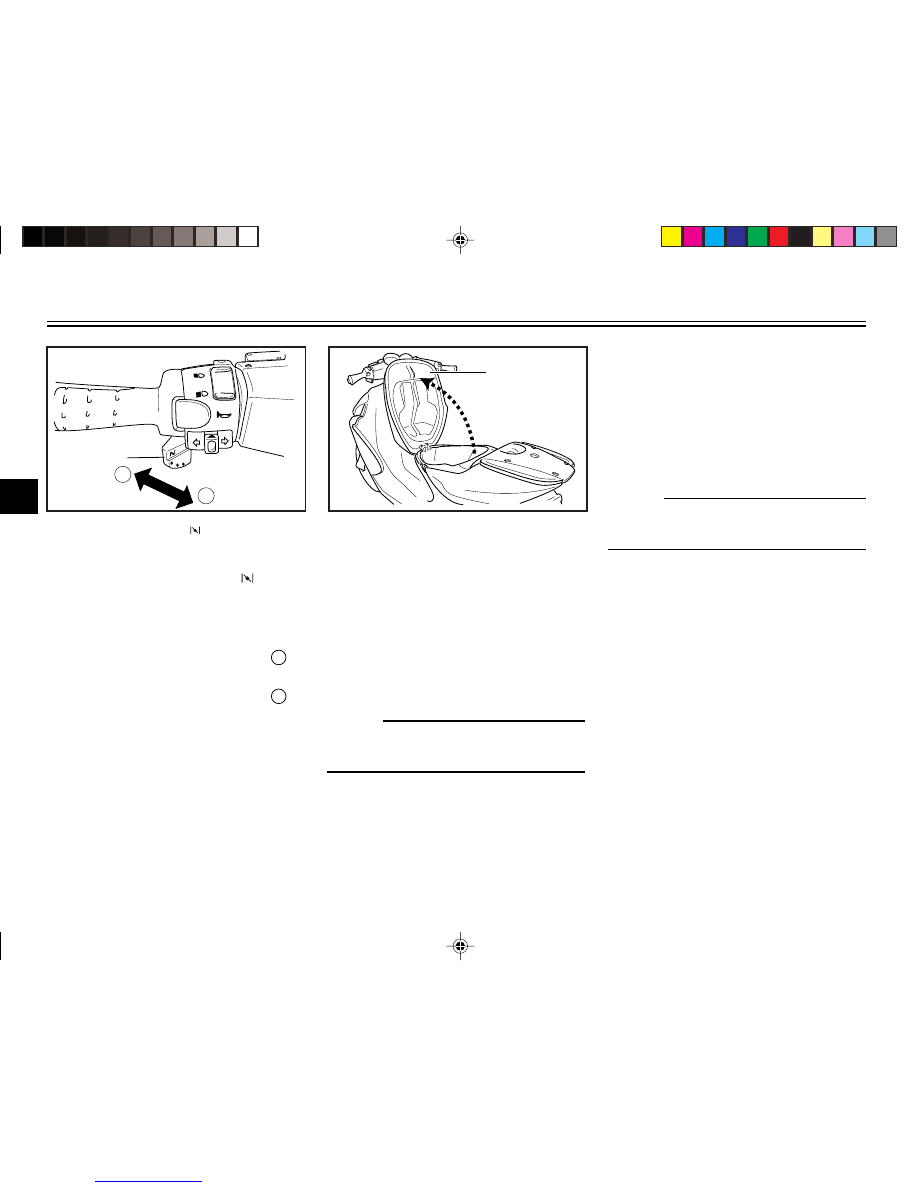
3
INSTRUMENT AND CONTROL FUNCTIONS
EAU03091
Rider seat
To open the rider seat
1. Place the scooter on the
centerstand.
2. Insert the key into the main switch,
and then turn it counterclockwise.
NOTE :
Do not push inward when turning the
key.
3. Fold the rider seat up.
To close the rider seat
1. Fold the rider seat down, and then
push it down to lock it in place.
2. Remove the key from the main
switch if the scooter will be left
unattended.
NOTE :
Make sure that the seat is properly
secured before riding.
1
ZAUM0264
1. Seat
3-9
EAU03839
Starter (choke) lever " "
Starting a cold engine requires a richer
air-fuel mixture, which is supplied by the
starter (choke).
•
Move the lever in direction a to
turn on the starter (choke).
•
Move the lever in direction b to
turn off the starter (choke).
1. Starter (choke) lever " "
a
b
1
ZAUM0293
Ofrecido por www.electromanuales.com
manuals search engine
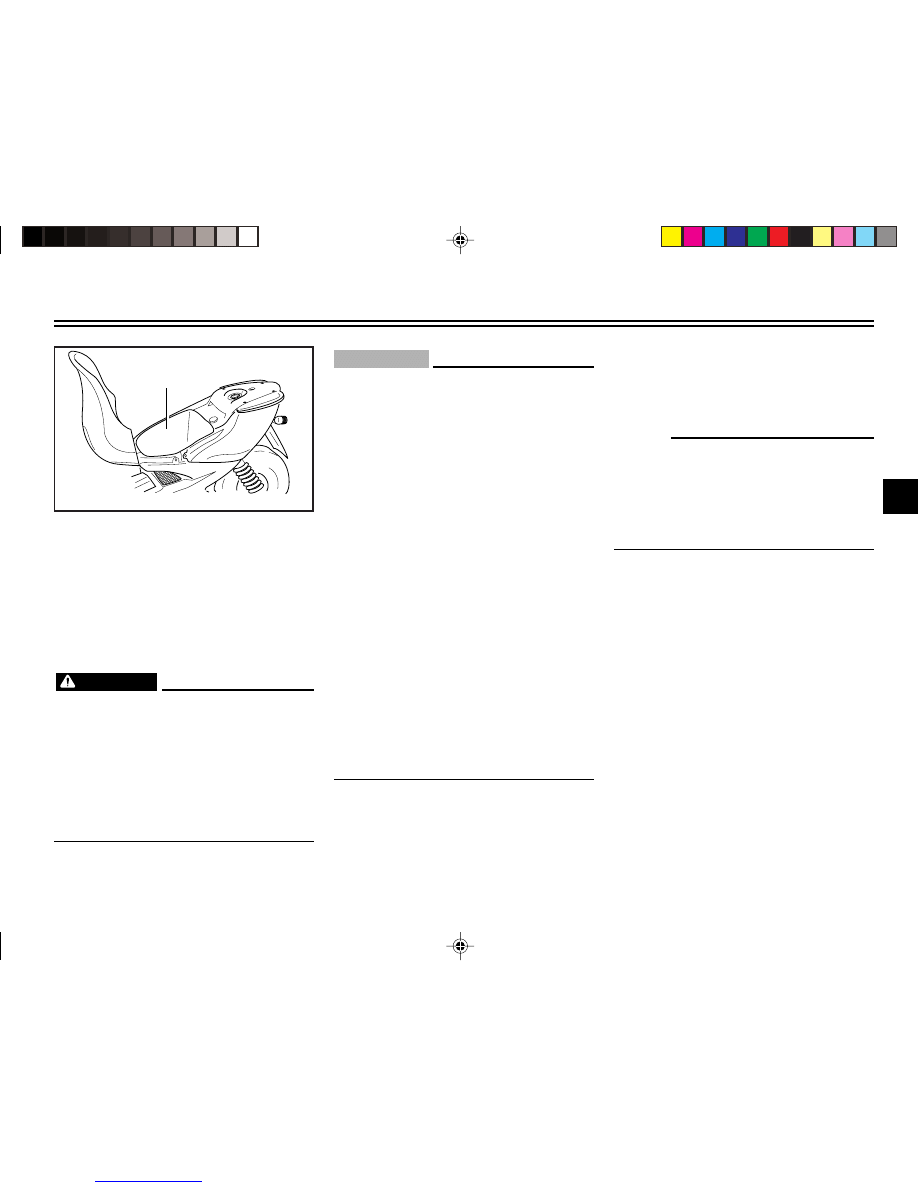
INSTRUMENT AND CONTROL FUNCTIONS
3
1
ZAUM0265
1. Storage compartment A
EAU03450
Storage compartment A
There is a storage compartment under
the seat. (See page 3-9 for seat opening
and closing procedures.)
EWA00005
•
Do not exceed the load limit of 3.0
kg for the storage compartment.
•
Do not exceed the maximum
load of 180 kg for the vehicle.
(Load is the totalweight of rider,
passenger, cargo and acces-
sories.)
EC000010
Keep the following points in mind
when using the storage compartment.
•
Since the storage compartment
accumulates
heat
when
exposed to the sun, do not store
anything susceptible to heat
inside it.
•
To avoid humidity from
spreading through the storage
compartment, wrap wet articles
in a plastic bag before storing
them in the compartment.
•
Since the storage compartment
may get wet while the scooter
is being washed, wrap any arti-
cles stored in the compartment
in a plastic bag.
•
Do not keep anything valuable
or breakable in the storage
compartment.
To store a helmet in the storage
compartment, place the helmet upside-
down with the front facing forward.
NOTE :
•
Some helmets cannot be stored
in the storage compartment
because of their size or shape.
•
Do not leave your scooter
unattended with the seat open.
CAUTION:
WARNING
3-10
Ofrecido por www.electromanuales.com
manuals search engine
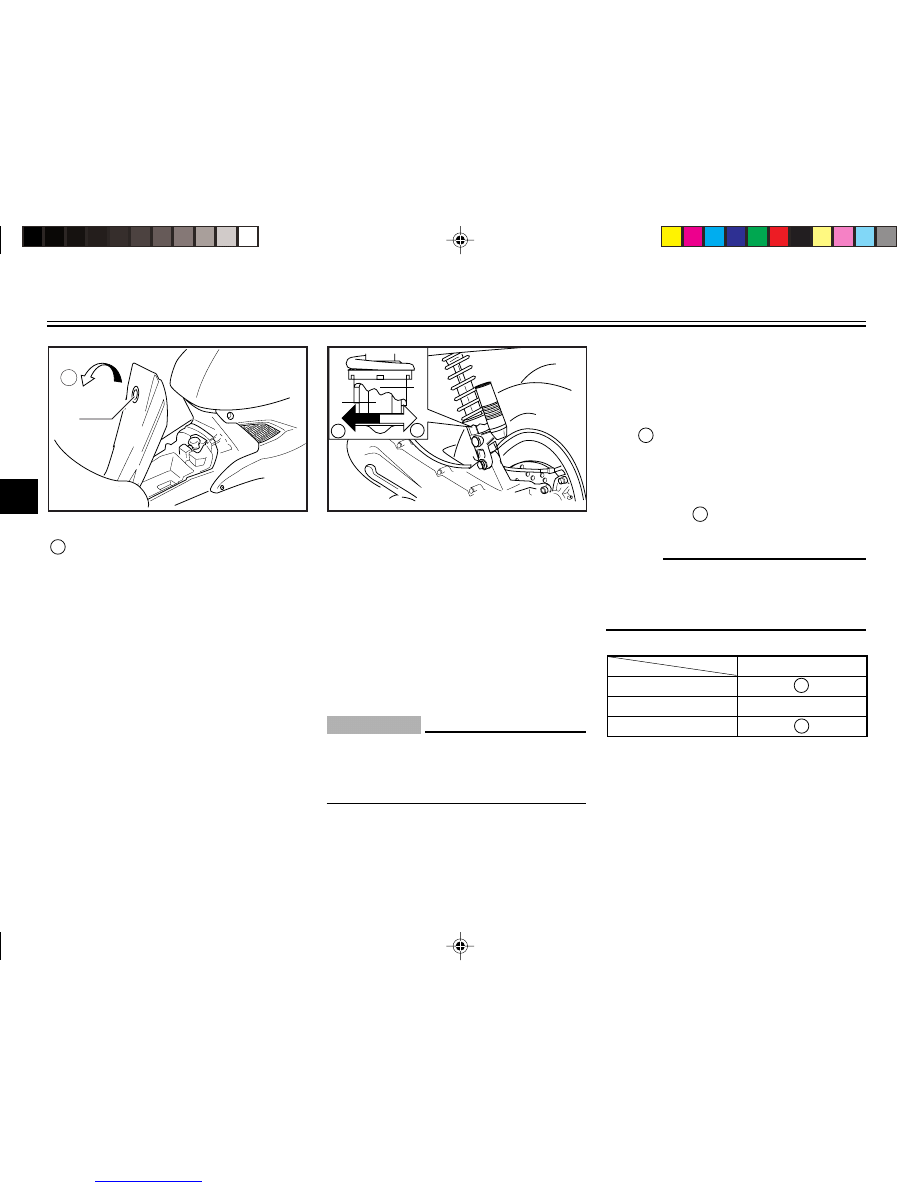
3
INSTRUMENT AND CONTROL FUNCTIONS
a
1
ZAUM0266
1. Storage compartment lock
a Open
3-11
b
a
1
2
ZAUM0294
EAU00295
Adjusting the shock absor-
ber assembly
(depends on model)
This shock absorber assembly is
equipped with a spring preload
adjusting ring.
EC000015
Never attempt to turn an adjusting
mechanism beyond the maximum or
minimum settings.
Adjust the spring preload as follows.
•
To increase the spring preload and
thereby harden the suspension,
turn the adjusting ring in direction
a .
•
To decrease the spring preload
and thereby soften the suspen-
sion, turn the adjusting ring in di-
rection b .
NOTE :
Align the appropriate notch in the
adjusting ring with the position indicator
on the shock absorber.
CAUTION:
Setting
Minimum (soft)
b
Standard
middle
Maximum (hard)
a
1. Spring preload adjusting ring
2. Position indicator
EAUM0083
Storage compartment B
The storage compartment is located in
front of the seat.
To open the storage compartment
1. Insert the key into the lock, and
then turn it clockwise.
2. Fold the storage compartment
cover up.
To close the storage compartment
1. Fold the storage compartment
cover down.
2. Turn the key counterclockwise,
and then remove it.
Ofrecido por www.electromanuales.com
manuals search engine
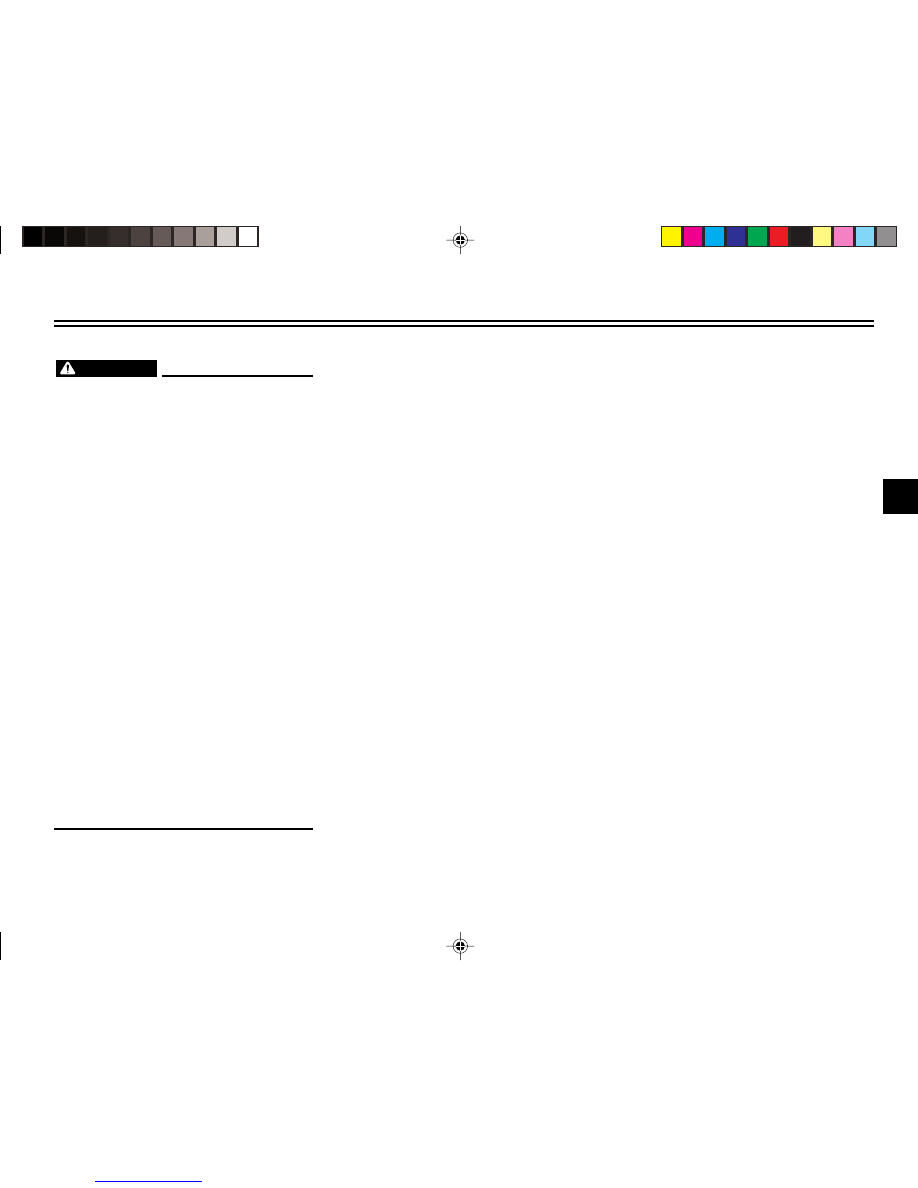
INSTRUMENT AND CONTROL FUNCTIONS
3
EAU00315
EW000041
This shock absorber contains highly
pressurized nitrogen gas. For proper
handling, read and understand the
following information before
handling the shock absorber. The
manufacturer cannot be held
responsible for property damage or
personal injury that may result from
improper handling.
•
Do not tamper with or attempt
to open the gas cylinder.
•
Do not subject the shock absor-
ber to an open flame or other
high heat sources, otherwise it
may explode due to excessive
gas pressure.
•
Do not deform or damage the
gas cylinder in any way, as this
will result in poor damping per-
formance.
•
Always have a Yamaha dealer
service the shock absorber.
WARNING
3-12
Ofrecido por www.electromanuales.com
manuals search engine
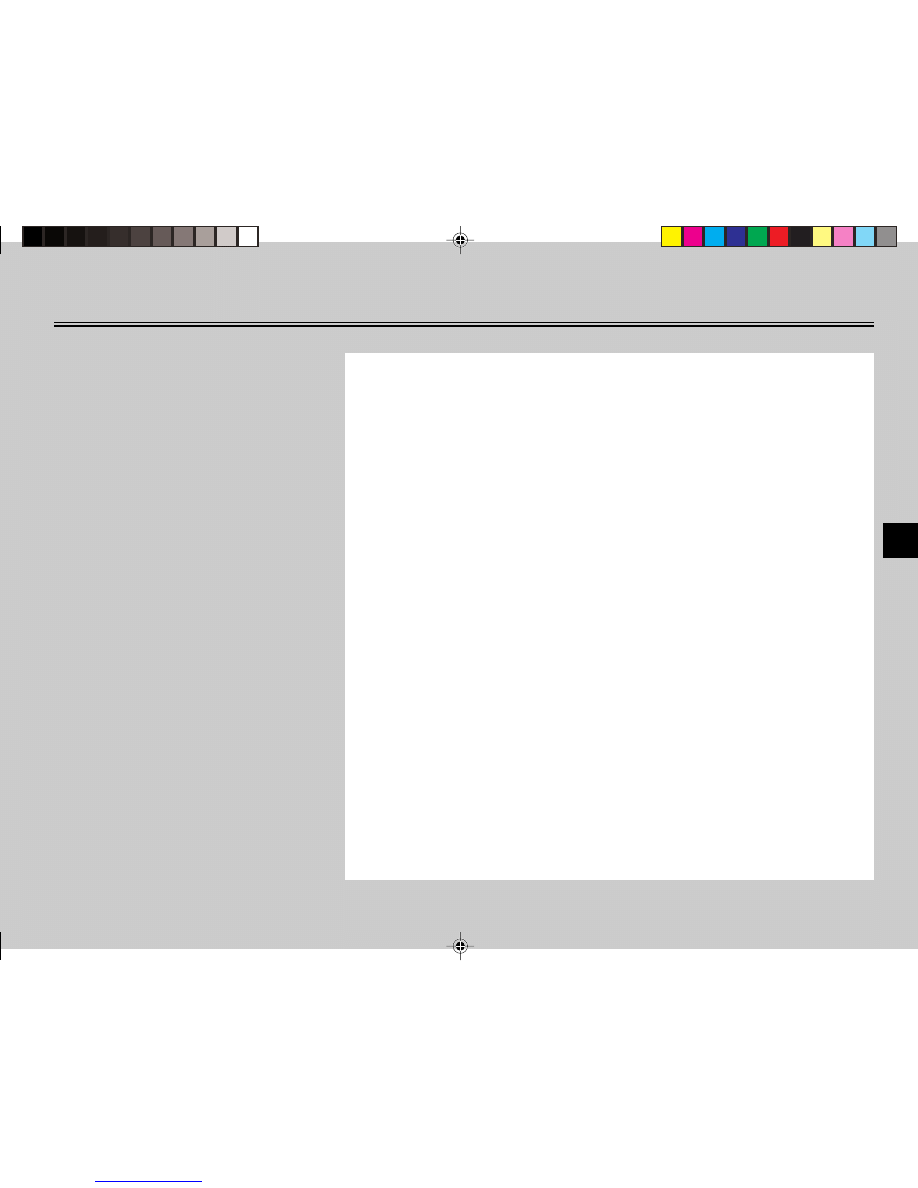
EAU01114
PRE-OPERATION CHECKS
Pre-operation check list ....................................................................... 4-1
4
Ofrecido por www.electromanuales.com
manuals search engine
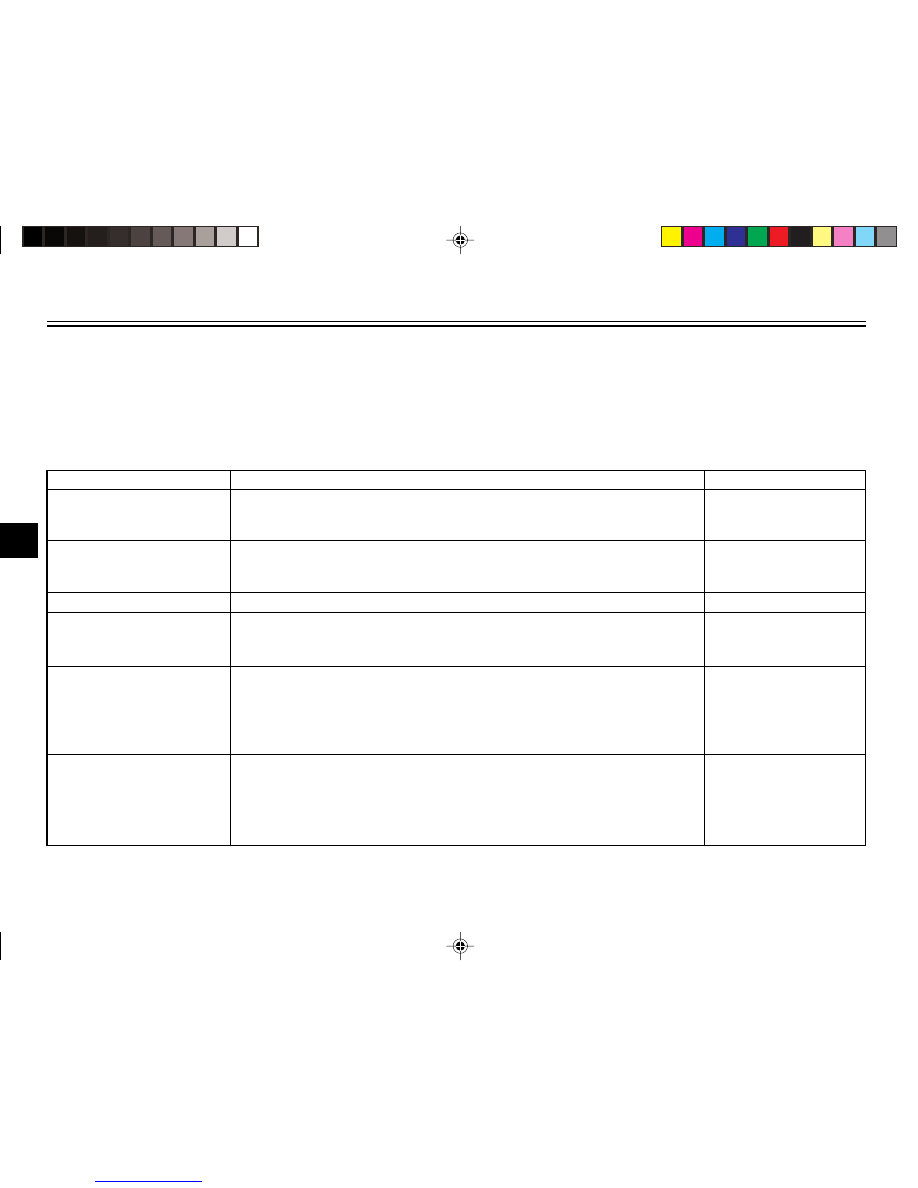
PRE-OPERATION CHECKS
4
EAU03439
Pre-operation check list
ITEM
CHECKS
PAGE
• Check fuel level in fuel tank.
Fuel
• Refuel if necessary.
3-5 — 3-6
• Check fuel line for leakage.
• Check oil level in oil tank.
Two-stroke engine oil
• If necessary, add recommended oil to specified level.
3-8, 6-15
• Check vehicle for oil leakage.
Final transmission oil
• Check vehicle for oil leakage.
6-7
• Check coolant level in reservoir.
Coolant
• If necessary, add recommended coolant to specified level.
6-8
• Check cooling system for leakage.
• Check operation.
• If soft or spongy, have Yamaha dealer bleed hydraulic system.
Front brake
• Check fluid level in reservoir.
3-5, 6-13 — 6-15
• If necessary, add recommended brake fluid to specified level.
• Check hydraulic system for leakage.
• Check operation.
• If soft or spongy, have Yamaha dealer bleed hydraulic system.
Rear brake
• Check fluid level in reservoir.
3-5, 6-13 — 6-15
• If necessary, add recommended brake fluid to specified level.
• Check hydraulic system for leakage.
The condition of a vehicle is the owner’s responsibility. Vital components can start to deteriorate quickly and unexpectedly,
even if the vehicle remains unused (for example, as a result of exposure to the elements). Any damage, fluid leakage or
loss of tire air pressure could have serious consequences. Therefore, it is very important, in addition to a thorough visual
inspection, to check the following points before each ride.
4-1
Ofrecido por www.electromanuales.com
manuals search engine
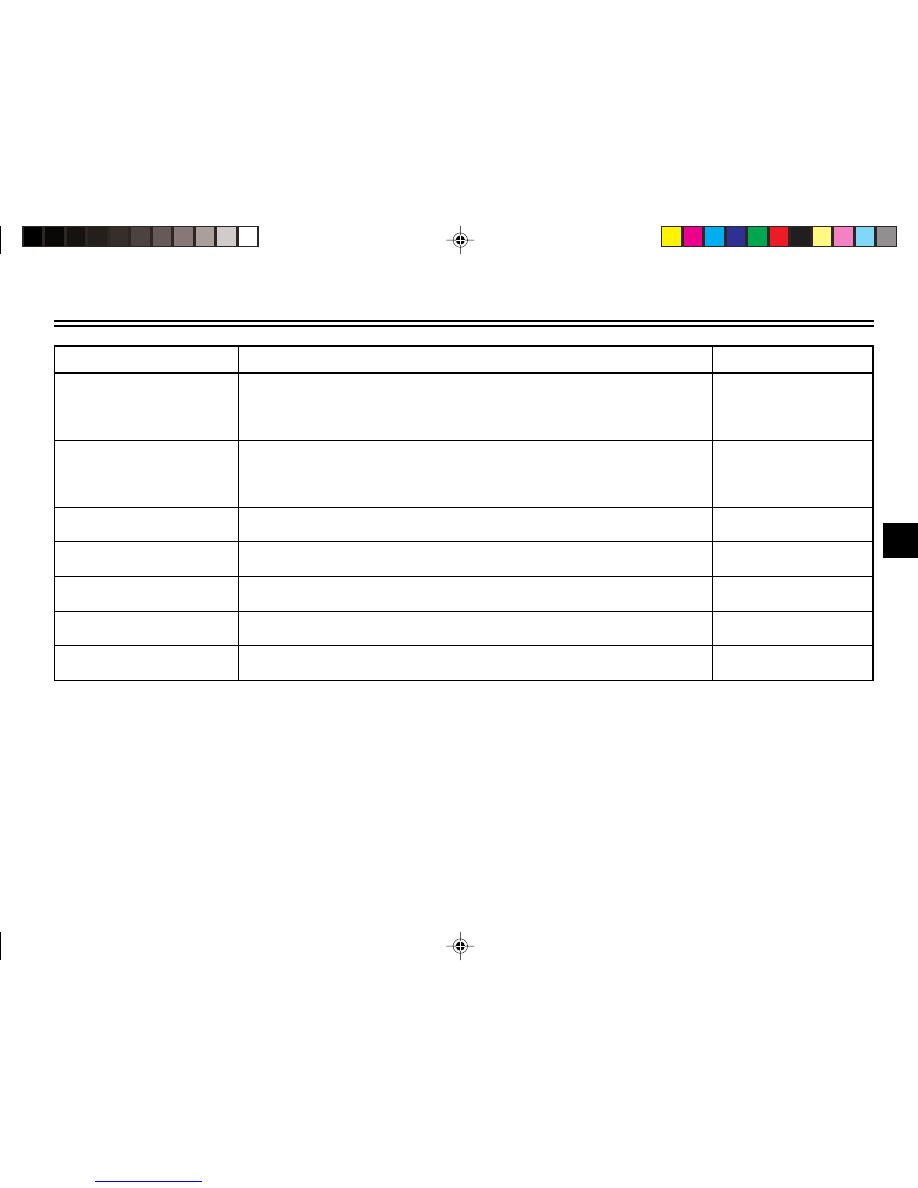
4
PRE-OPERATION CHECKS
ITEM
CHECKS
PAGE
• Make sure that operation is smooth.
Throttle grip
• Check cable free play.
6-11
• If necessary, have Yamaha dealer adjust cable free play
and lubricate cable and grip housing.
• Check for damage.
Wheels and tires
• Check tire condition and tread depth.
6-11 — 6-13
• Check air pressure.
• Correct if necessary.
Brake levers
• Make sure that operation is smooth.
6-13, 6-16
• Lubricate lever pivoting points if necessary.
Centerstand
• Make sure that operation is smooth.
6-16
• Lubricate pivot if necessary.
Chassis fasteners
• Make sure that all nuts, bolts and screws are properly tightened.
—
• Tighten if necessary.
Instruments, lights
• Check operation.
3-3, 3-4, 6-20 — 6-22
signals and switches
• Correct if necessary.
Battery
• Check fluid level.
6-18
• Fill with distilled water if necessary.
4-2
Ofrecido por www.electromanuales.com
manuals search engine
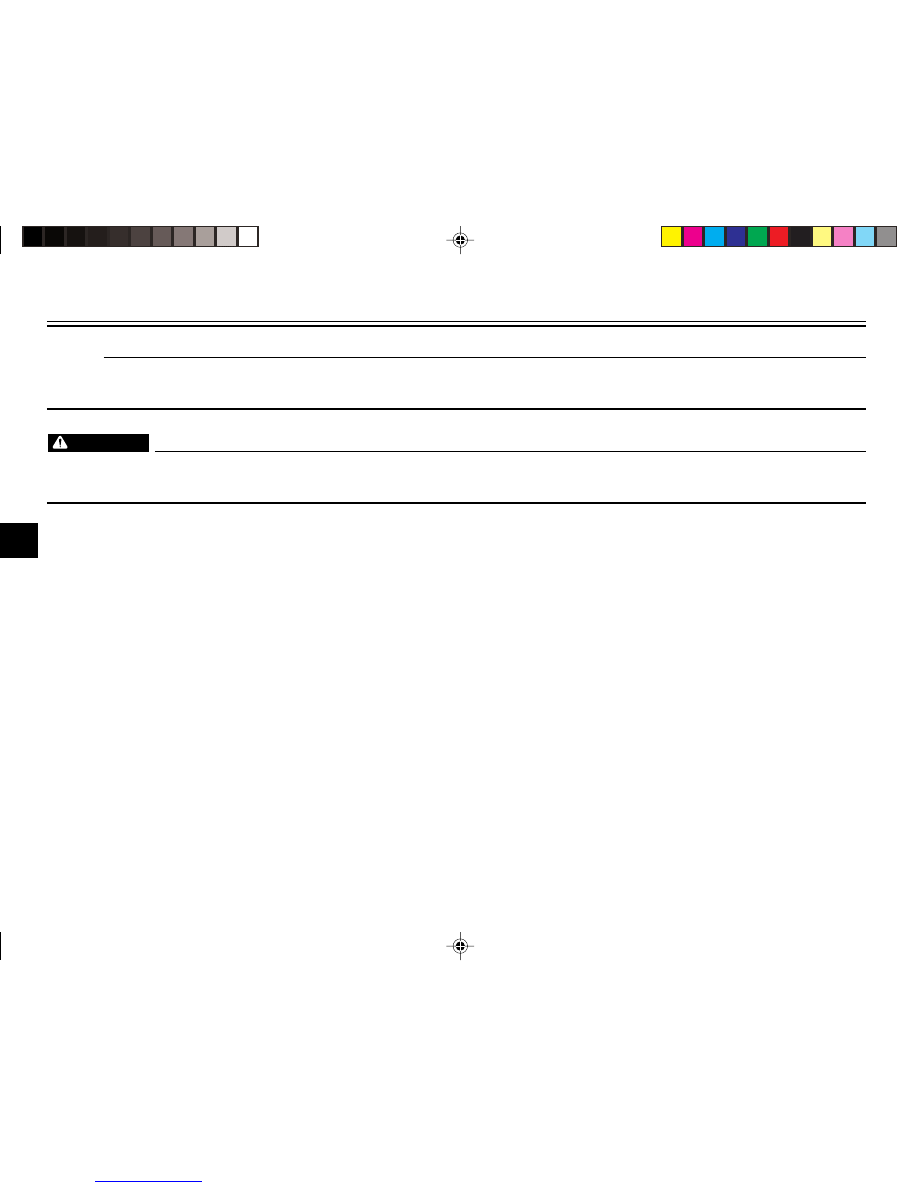
PRE-OPERATION CHECKS
4
NOTE :
Pre-operation checks should be made each time the scooter is used. Such an inspection can be accomplished in a very
short time; and the added safety it assures is more than worth the time involved.
EWA00033
If any item in the Pre-operation check list is not working properly, have it inspected and repaired before operating
the scooter.
WARNING
4-3
Ofrecido por www.electromanuales.com
manuals search engine
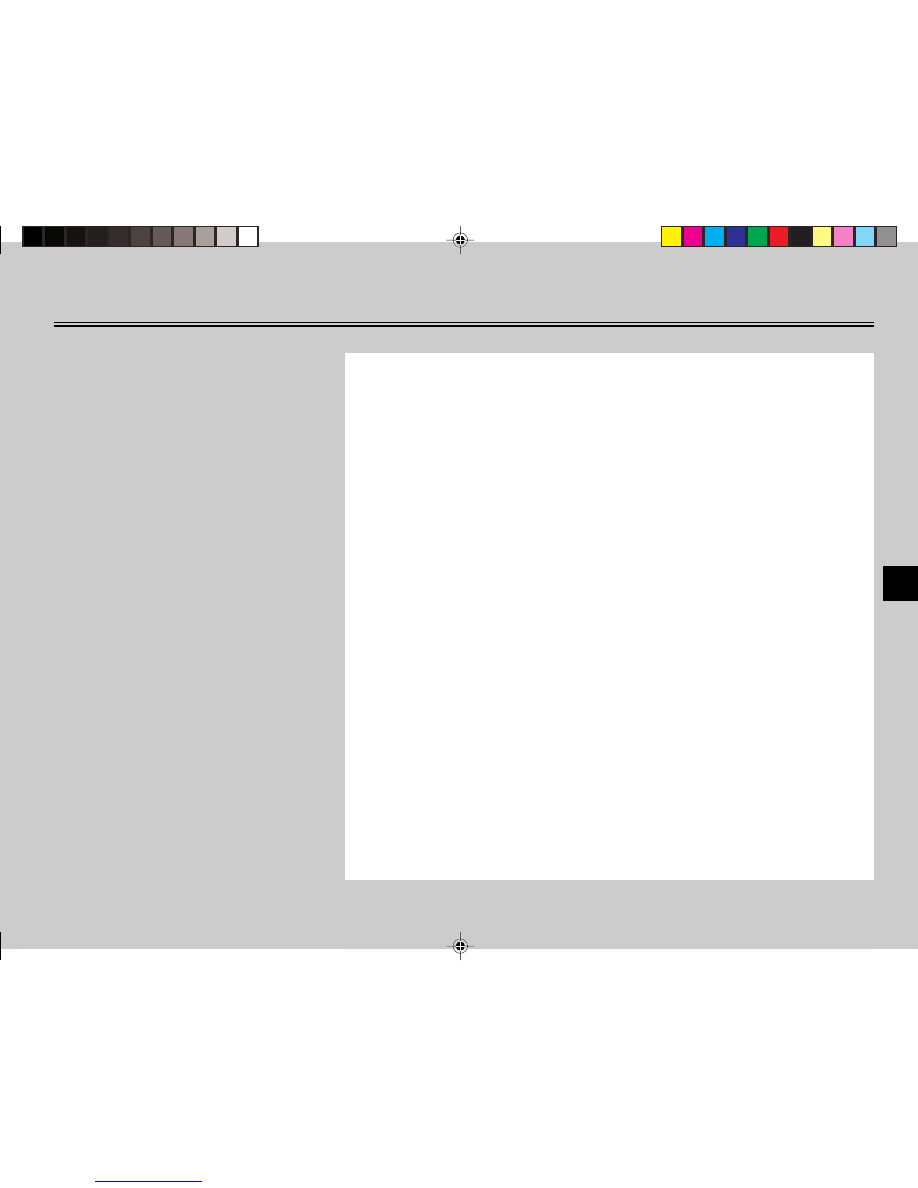
EAU00372
OPERATION AND IMPORTANT RIDING POINTS
Starting the engine .............................................................................. 5-1
Starting a warm engine ....................................................................... 5-2
Starting off ........................................................................................... 5-2
Acceleration and deceleration ............................................................. 5-3
Braking ................................................................................................ 5-3
Tips for reducing fuel consumption ..................................................... 5-4
Engine break-in ................................................................................... 5-4
Parking ................................................................................................ 5-5
5
Ofrecido por www.electromanuales.com
manuals search engine
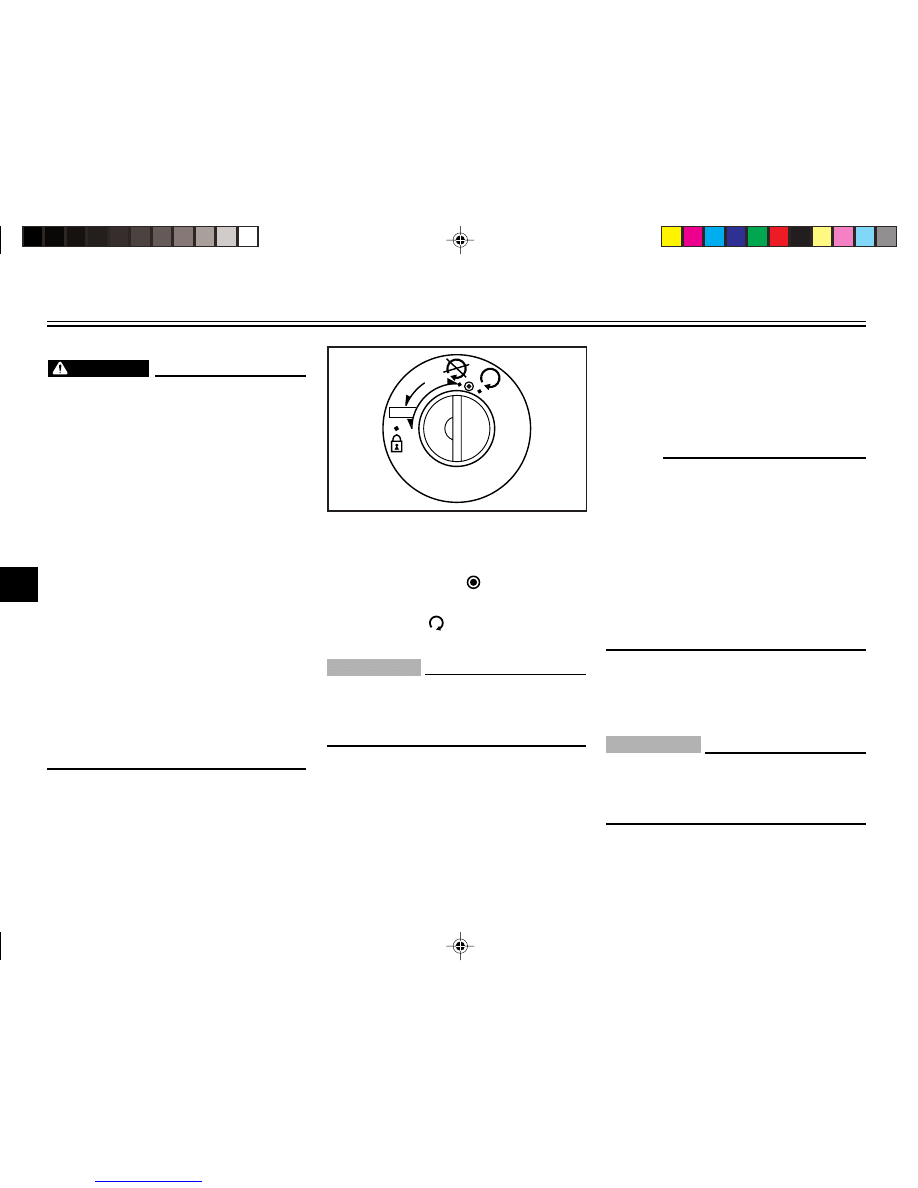
OPERATION AND IMPORTANT RIDING POINTS
5
EAU01118
EW000129
•
Become thoroughly familiar
with all operating controls and
their functions before riding.
Consult a Yamaha dealer
regarding any control or
function that you do not
thoroughly understand.
•
Never start the engine or
operate it in a closed area for
any length of time. Exhaust fu-
mes are poisonous, and
inhaling them can cause loss of
consciousness and death
within a short time. Always
make sure that there is
adequate ventilation.
•
For safety, always start the
engine with the centerstand
down.
WARNING
CAUTION:
CAUTION:
PUSH
OPEN
ZAUM0253
5-1
EAU00415*
Starting the engine
1. Turn the key to "
", then when the
oil level warning light comes on,
turn it to "
".
EC000045
If the oil level warning light does not
come on, have a Yamaha dealer
check the electrical circuit.
2. Turn the starter (choke) on and
completely close the throttle. (See
page 3-9 for starter (choke)
operation.)
3. Start the engine by pushing the
start switch or by pushing the
kickstarter lever down, while
applying the front or rear brake.
NOTE :
If the engine fails to start by pushing
the start switch, release the switch, wait
a few seconds, and then try again. Each
starting attempt should be as short as
possible to preserve the battery. Do not
crank the engine more than 5 seconds
on any one attempt. If the engine does
not start with the starter motor, try using
the kickstarter.
4. After starting the engine, move the
starter (choke) lever back halfway.
ECA00045
For maximum engine life, never
accelerate hard when the engine is
cold!
Ofrecido por www.electromanuales.com
manuals search engine
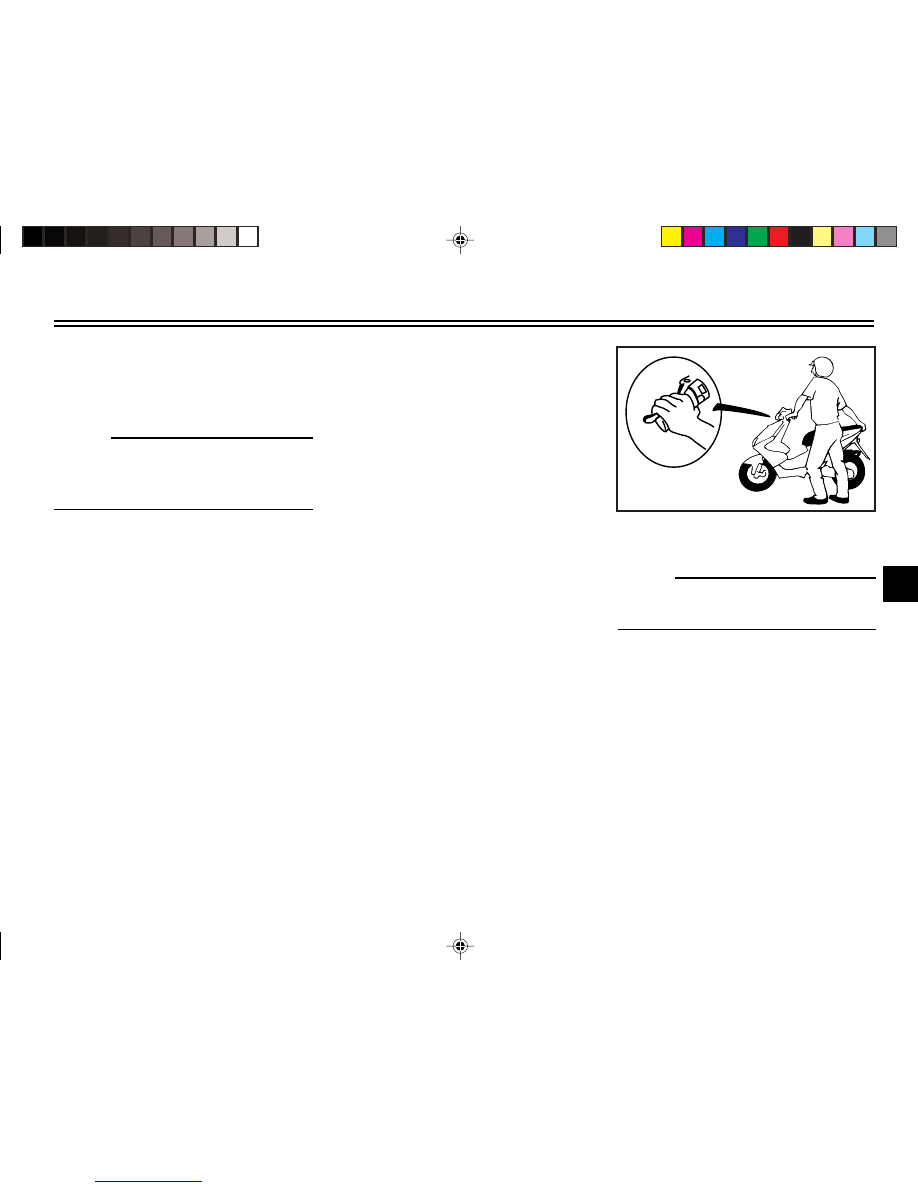
OPERATION AND IMPORTANT RIDING POINTS
5
EAU00433
Starting off
NOTE :
Before starting off, allow the engine to
warm up.
1. While pulling the rear brake lever
with your left hand and holding the
grab bar with your right hand,
push the scooter off the
centerstand.
2. Sit astride the seat, and then
adjust the rear view mirrors.
3. Switch the turn signal on.
4. Check for oncoming traffic, and
then slowly turn the throttle grip
(on the right) in order to take off.
5. Switch the turn signal off.
ZAUM0267
5-2
5. When the engine is warm, turn the
starter (choke) off.
NOTE :
The engine is warm when it responds
normally to the throttle with the starter
(choke) turned off.
EAU01258
Starting a warm engine
Follow the same procedure as for
starting a cold engine with the excep-
tion that the starter (choke) is not
required when the engine is warm.
Ofrecido por www.electromanuales.com
manuals search engine
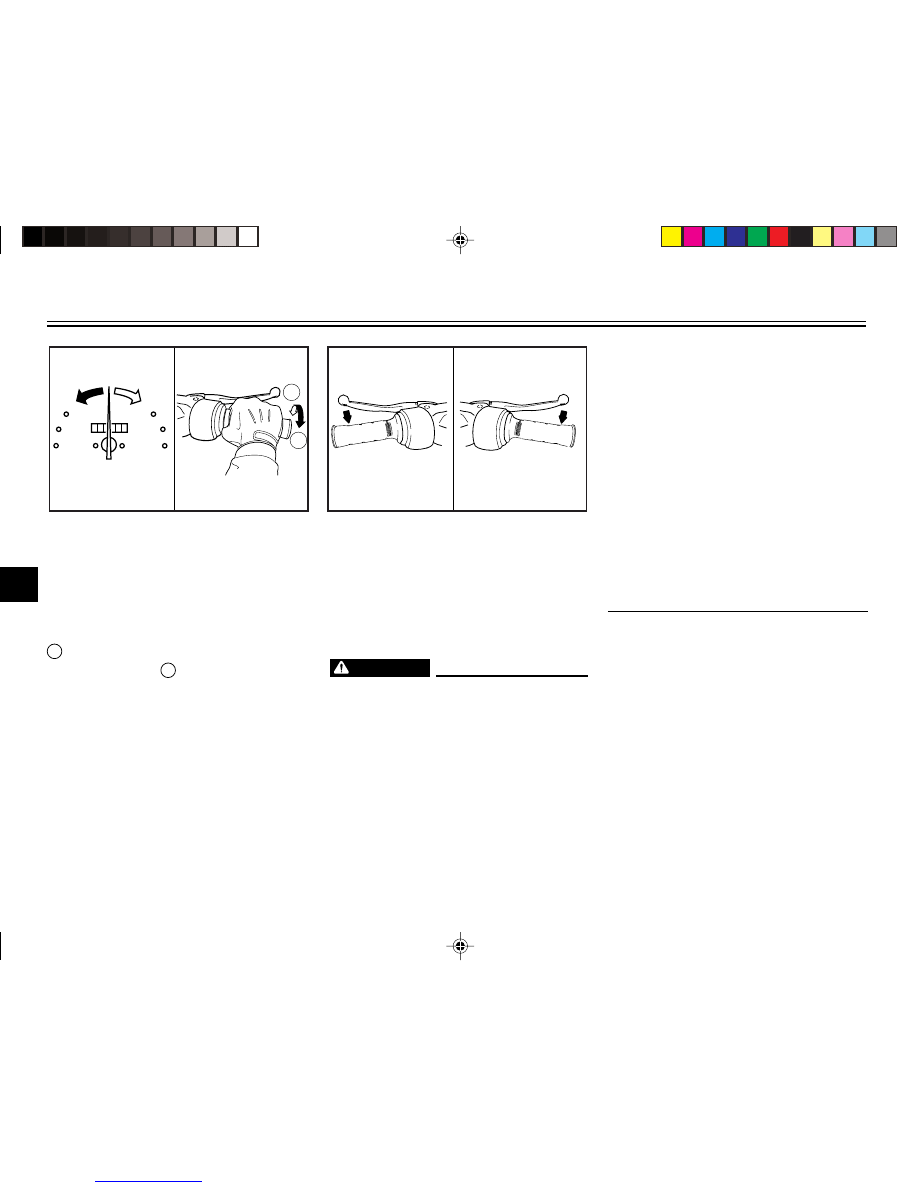
OPERATION AND IMPORTANT RIDING POINTS
5
EAU00435
Braking
1. Close the throttle completely.
2. Apply both front and rear brakes
simultaneously while gradually
increasing the pressure.
EW000057
•
Avoid braking hard or suddenly
(especially when leaning over
to one side), otherwise the
scooter may skid or overturn.
•
Railroad crossings, streetcar
rails, iron plates on road cons-
truction sites, and manhole
covers become extremely
slippery when wet. Therefore,
slow down when approaching
such areas and cross them with
caution.
•
Keep in mind that braking on a
wet road is much more difficult.
•
Ride slowly down a hill, as
braking downhill can be very
difficult.
ZAUM0269
WARNING
5-3
EAU00434
Acceleration and
deceleration
The speed can be adjusted by opening
and closing the throttle. To increase the
speed, turn the throttle grip in direction
a . To reduce the speed, turn the throttle
grip in direction b .
B
A
a
b
ZAUM0268
Ofrecido por www.electromanuales.com
manuals search engine
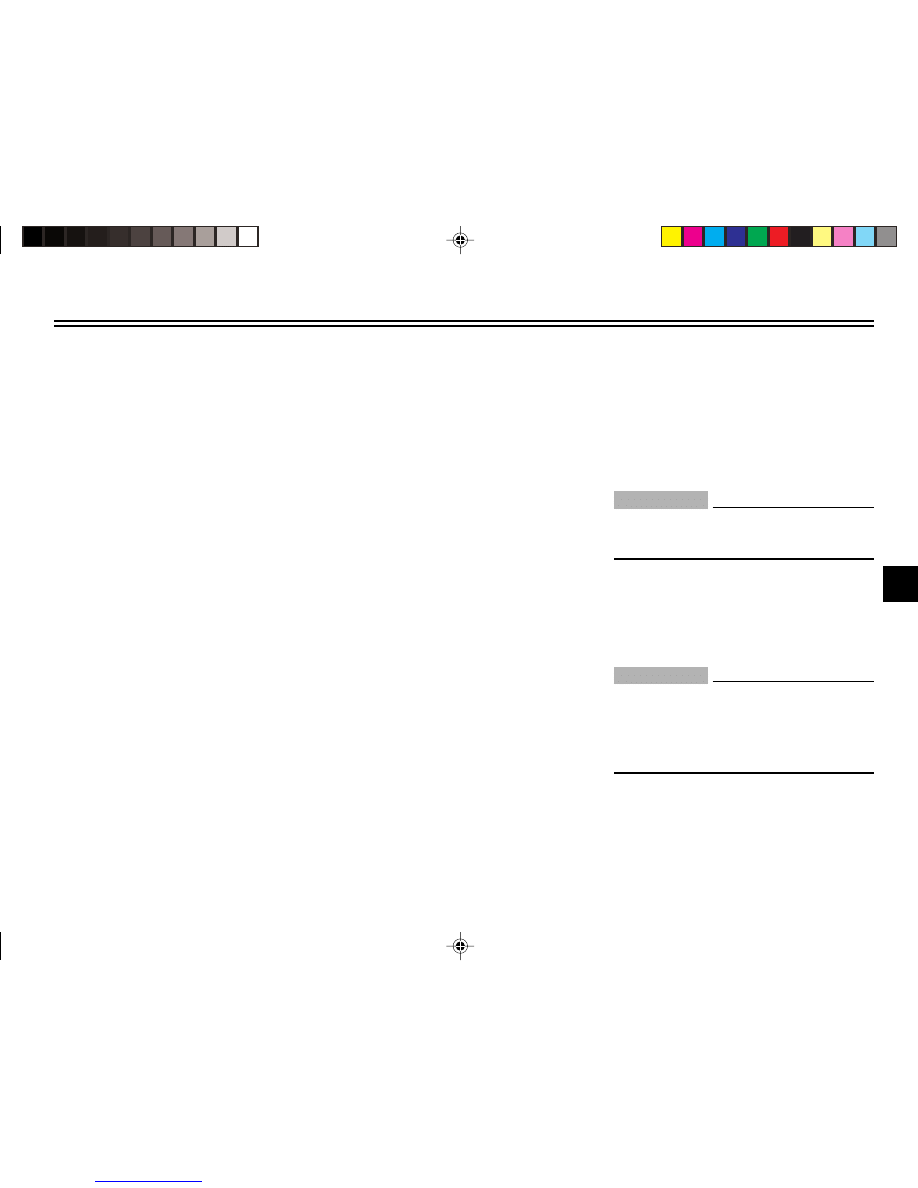
OPERATION AND IMPORTANT RIDING POINTS
5
EAU00436
Engine break-in
There is never a more important period
in the life of your engine than the period
between 0 and 1,000 km. For this
reason, you should read the following
material carefully.
Since the engine is brand new, do not
put an excessive load on it for the first
1,000 km. The various parts in the
engine wear and polish themselves to
the correct operating clearances.
During this period, prolonged full-
throttle operation or any condition that
might result in engine overheating must
be avoided.
EAUT0003
0 — 150 km
Avoid operation above 1/3 throttle. Stop
the engine and let it cool for 5 to 10
minutes after every hour of operation.
Vary the speed of the scooter from time
to time. Do not operate it at one set
throttle position.
150 — 500 km
Avoid prolonged operation above 1/2
throttle.
500 — 1,000 km
Avoid cruising speeds in excess of 3/
4 throttle.
ECAT0001
After 1,000 km of operation, be sure
to replace the final transmission oil.
1,000 km and beyond
Avoid prolonged full throttle operation.
Vary speeds occasionally.
EC000049
If any engine trouble should occur
during the engine break-in period,
immediately have a Yamaha dealer
check the vehicle.
CAUTION:
CAUTION:
5-4
EAU03093
Tips for reducing fuel
consumption
Fuel consumption depends largely on
your riding style. Consider the following
tips to reduce fuel consumption:
•
Thoroughly warm up the engine.
•
Avoid high engine speeds during
acceleration.
•
Avoid high engine speeds with no
load on the engine.
•
Turn the engine off instead of
letting it idle for an extended length
of time (e.g., in traffic jams, at
traffic lights or at railroad
crossings).
Ofrecido por www.electromanuales.com
manuals search engine
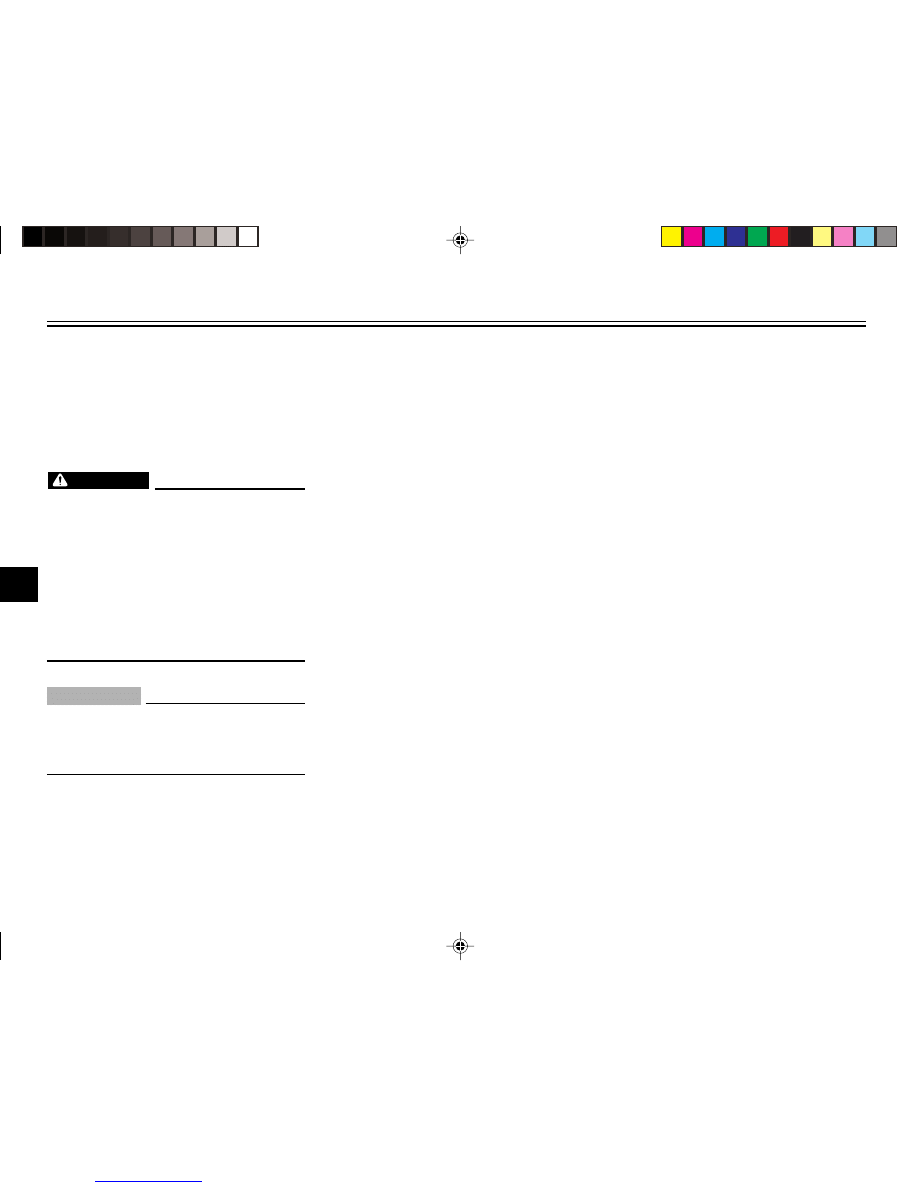
OPERATION AND IMPORTANT RIDING POINTS
5
EAU00461
Parking
When parking, stop the engine, and
then remove the key from the main
switch.
EW000058
•
Since the engine and exhaust
system can become very hot,
park in a place where
pedestrians or children are not
likely to touch them.
•
Do not park on a slope or on
soft ground, otherwise the
scooter may overturn.
EC000062
Never park in an area where there
are fire hazards such as grass or
other flammable materials.
WARNING
CAUTION:
5-5
Ofrecido por www.electromanuales.com
manuals search engine
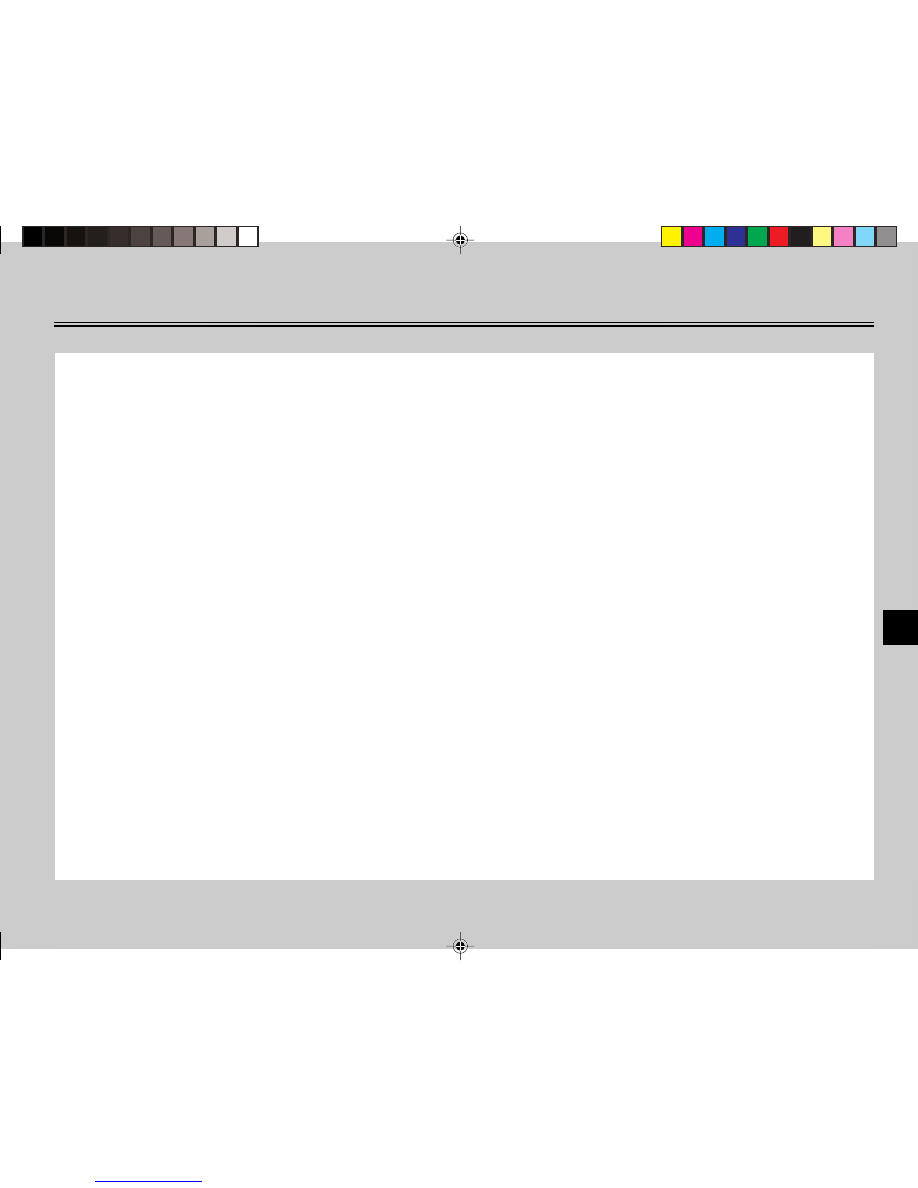
EAU00462
PERIODIC MAINTENANCE AND MINOR REPAIR
Periodic maintenance and lubrication chart ............ 6-2
Removing and installing cowling and panel ............ 6-5
Cowling A ................................................................ 6-5
Panel A .................................................................... 6-5
Checking the spark plug ......................................... 6-6
Final transmission oil .............................................. 6-7
Coolant .................................................................... 6-8
Cleaning the air filter element ................................. 6-9
Adjusting the carburetor ........................................ 6-10
Adjusting the throttle cable free play ..................... 6-11
Tires ...................................................................... 6-11
Wheels .................................................................. 6-13
Adjusting the front and rear brake lever
free play ................................................................ 6-13
Checking the front and rear brake pads ................ 6-14
Checking the brake fluid level ............................... 6-14
6
Changing the brake fluid ....................................... 6-15
Adjusting the autolube pump ................................ 6-15
Checking and lubricating the cables ..................... 6-16
Lubricating the front and rear brakes levers .......... 6-16
Checking and lubricating the centerstand ............. 6-16
Checking the front fork .......................................... 6-17
Checking the steering ........................................... 6-17
Checking the wheel bearings ................................ 6-18
Battery ................................................................... 6-18
Replacing the fuse ................................................ 6-20
Replacing a headlight bulb .................................... 6-20
Replacing tail/brake light bulb ............................... 6-21
Replacing a turn signal light bulb .......................... 6-22
Troubleshooting ..................................................... 6-22
Troubleshooting chart ............................................ 6-23
Engine overheating ............................................... 6-24
Ofrecido por www.electromanuales.com
manuals search engine
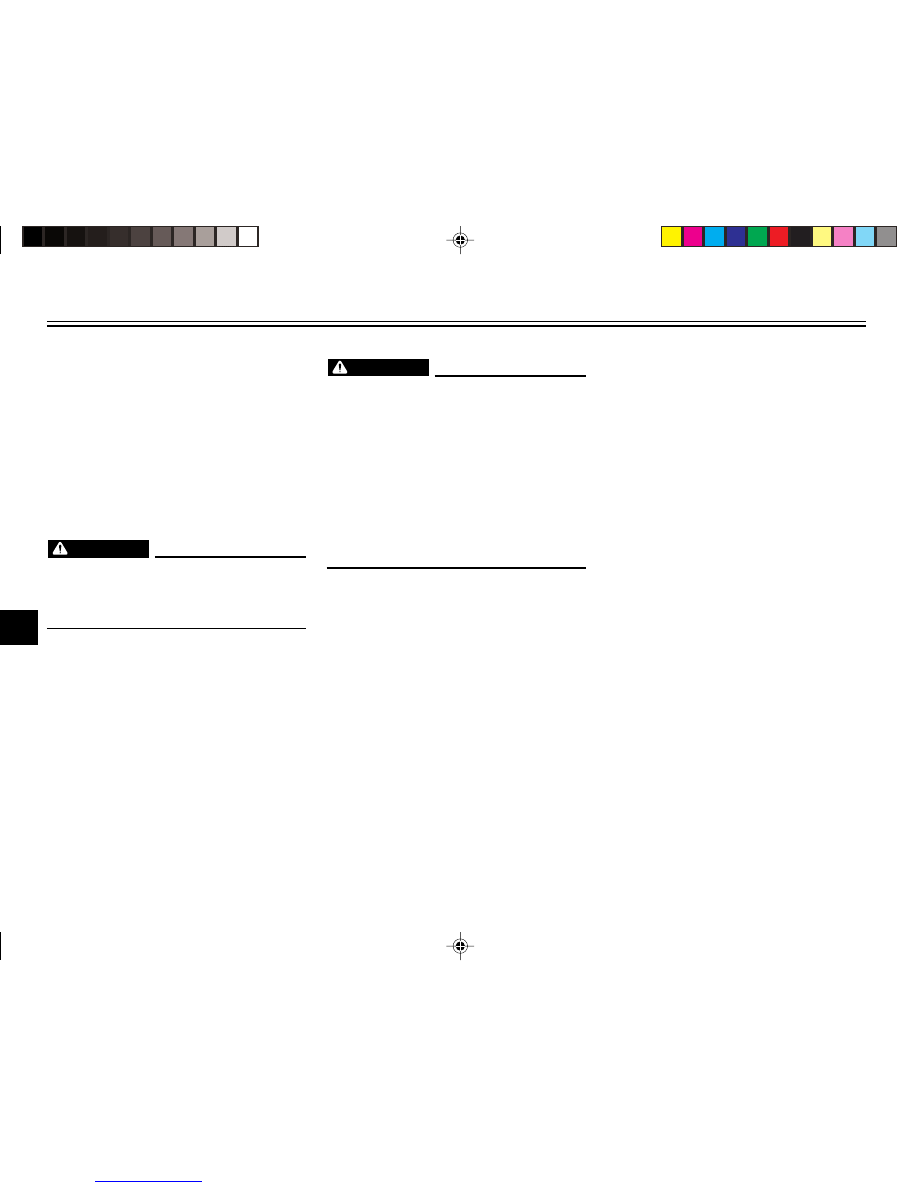
PERIODIC MAINTENANCE AND MINOR REPAIR
6
EAU03453
Safety is an obligation of the owner.
Periodic inspection, adjustment and
lubrication will keep your vehicle in the
safest and most efficient condition pos-
sible. The most important points of
scooter inspection, adjustment, and
lubrication are explained on the
following pages.
EW000060
If you are not familiar with scooter
maintenance work, have a Yamaha
dealer do it for you.
EAU00466
EW000061
This scooter is designed for use on
paved roads only. If this scooter is
operated in abnormally dusty,
muddy or wet conditions, the air filter
element should be cleaned or
replaced more frequently, otherwise
rapid engine wear may result.
Consult a Yamaha dealer for proper
maintenance intervals.
WARNING
WARNING
6-1
Ofrecido por www.electromanuales.com
manuals search engine
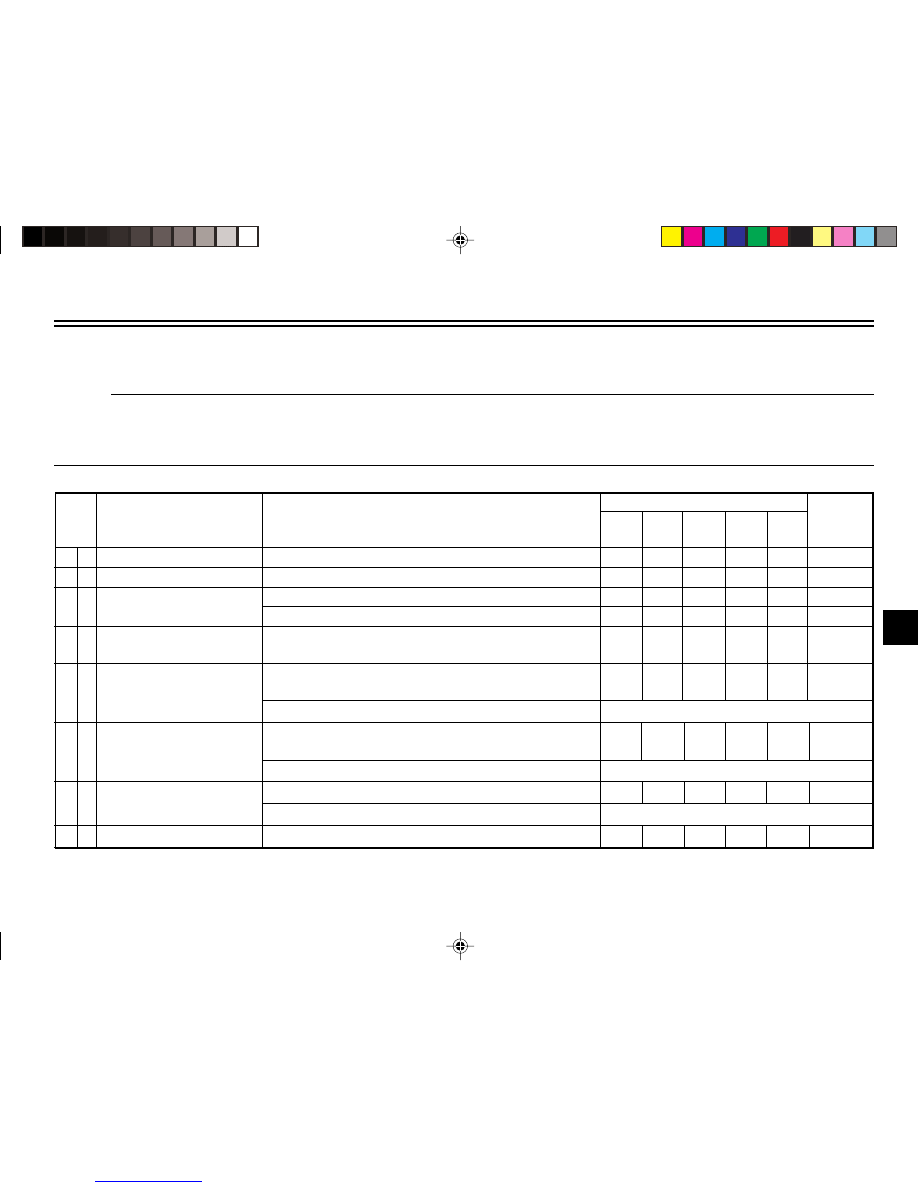
PERIODIC MAINTENANCE AND MINOR REPAIR
6
1
*
Fuel line
• Check fuel hoses and vacuum hose for cracks or damage.
√
√
√
√
√
2
Spark plug
• Replace.
√
√
√
√
√
3
Air filter element
• Clean.
√
√
• Replace.
√
√
4
*
Battery
• Check electrolyte level and specific gravity.
√
√
√
√
√
• Make sure that the breather hose is properly routed.
• Check operation, fluid level and vehicle for fluid leakage.
√
√
√
√
√
√
5
*
Front brake
(See NOTE on page 6-4.)
• Replace brake pads.
Whenever worn to the limit
• Check operation, fluid level and vehicle for fluid leakage.
√
√
√
√
√
√
6
*
Rear brake
(See NOTE on page 6-4.)
• Replace brake pads.
Whenever worn to the limit
7
*
Brake hoses
• Check for cracks or damage.
√
√
√
√
√
• Replace. (See NOTE on page 6-4.)
Every 4 years
8
*
Wheels
• Check runout and for damage.
√
√
√
√
EAU03686
Periodic maintenance and lubrication chart
NOTE :
•
The annual checks must be performed every year, except if a kilometer-based maintenance is performed instead.
•
From 30,000 km, repeat the maintenance intervals starting from 6,000 km.
•
Items marked with an asterisk should be performed by a Yamaha dealer as they require special tools, data and technical skills.
ODOMETER READING (x 1,000 km)
NO.
ITEM
CHECK OR MAINTENANCE JOB
1
ANNUAL
CHECK
6
12
18
24
6-2
Ofrecido por www.electromanuales.com
manuals search engine
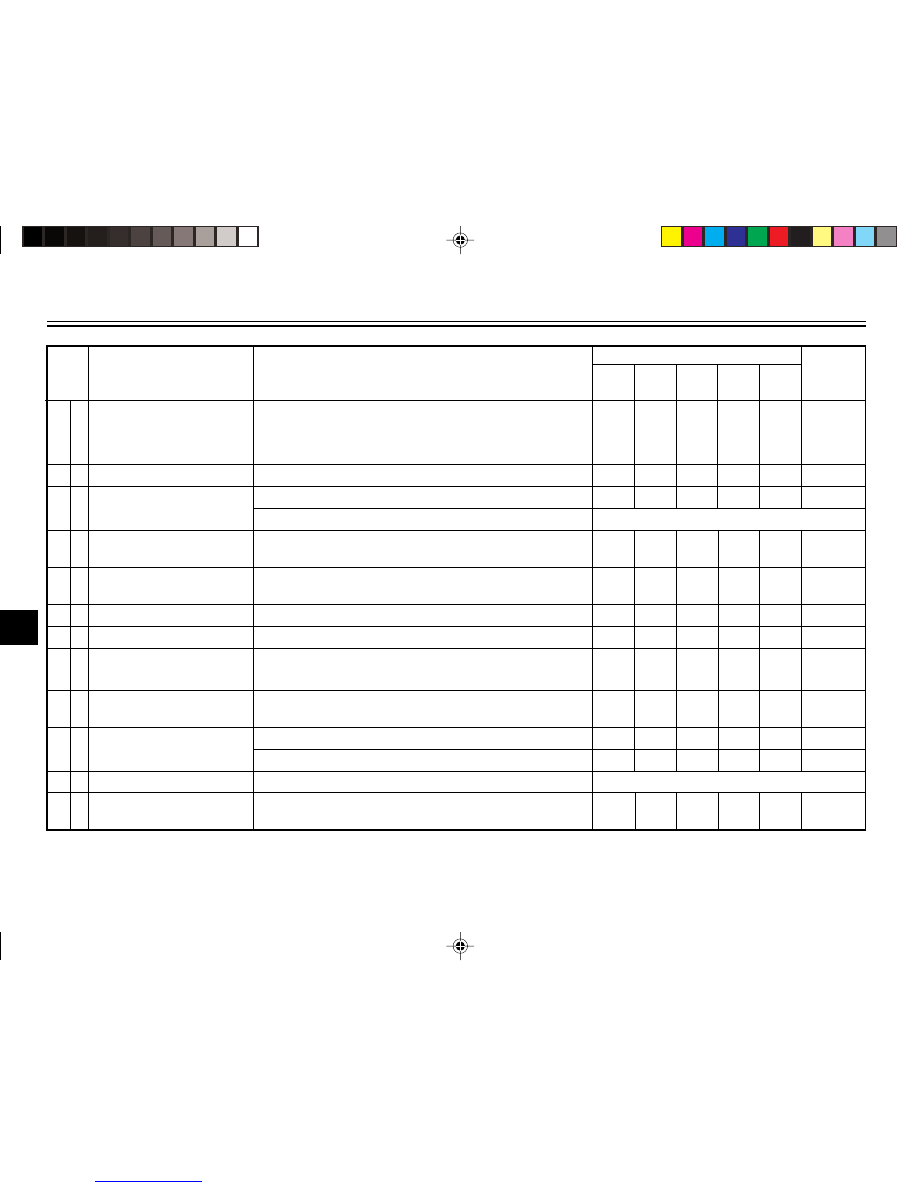
PERIODIC MAINTENANCE AND MINOR REPAIR
6
• Check tread depth and for damage.
9
*
Tires
• Replace if necessary.
√
√
√
√
√
• Check air pressure.
• Correct if necessary.
10
*
Wheel bearings
• Check bearing for looseness or damage.
√
√
√
√
11
*
Steering bearings
• Check bearing play and steering for roughness.
√
√
√
√
√
• Lubricate with lithium-soap-based grease.
Every 24,000 km
12
*
Chassis fasteners
• Make sure that all nuts, bolts and screws are
√
√
√
√
√
properly tightened.
13
Centerstand
• Check operation.
√
√
√
√
√
• Lubricate.
14
*
Front fork
• Check operation and for oil leakage.
√
√
√
√
15
*
Shock absorber assembly
• Check operation and shock absorber for oil leakage.
√
√
√
√
16
*
Carburetor
• Check starter (chocke) operation.
√
√
√
√
√
√
• Adjust engine idling speed.
17
*
Autolube pump
• Check operation.
√
√
√
√
• Bleed if necessary.
18
Final transmission oil
• Check vehicle for oil leakage.
√
√
√
• Change.
√
√
√
19
*
V-belt
• Replace.
Every 10,000 km
20
*
Front and rear brake
• Check operation.
√
√
√
√
√
√
switches
ODOMETER READING (x 1,000 km)
NO.
ITEM
CHECK OR MAINTENANCE JOB
1
ANNUAL
CHECK
6
12
18
24
6-3
Ofrecido por www.electromanuales.com
manuals search engine
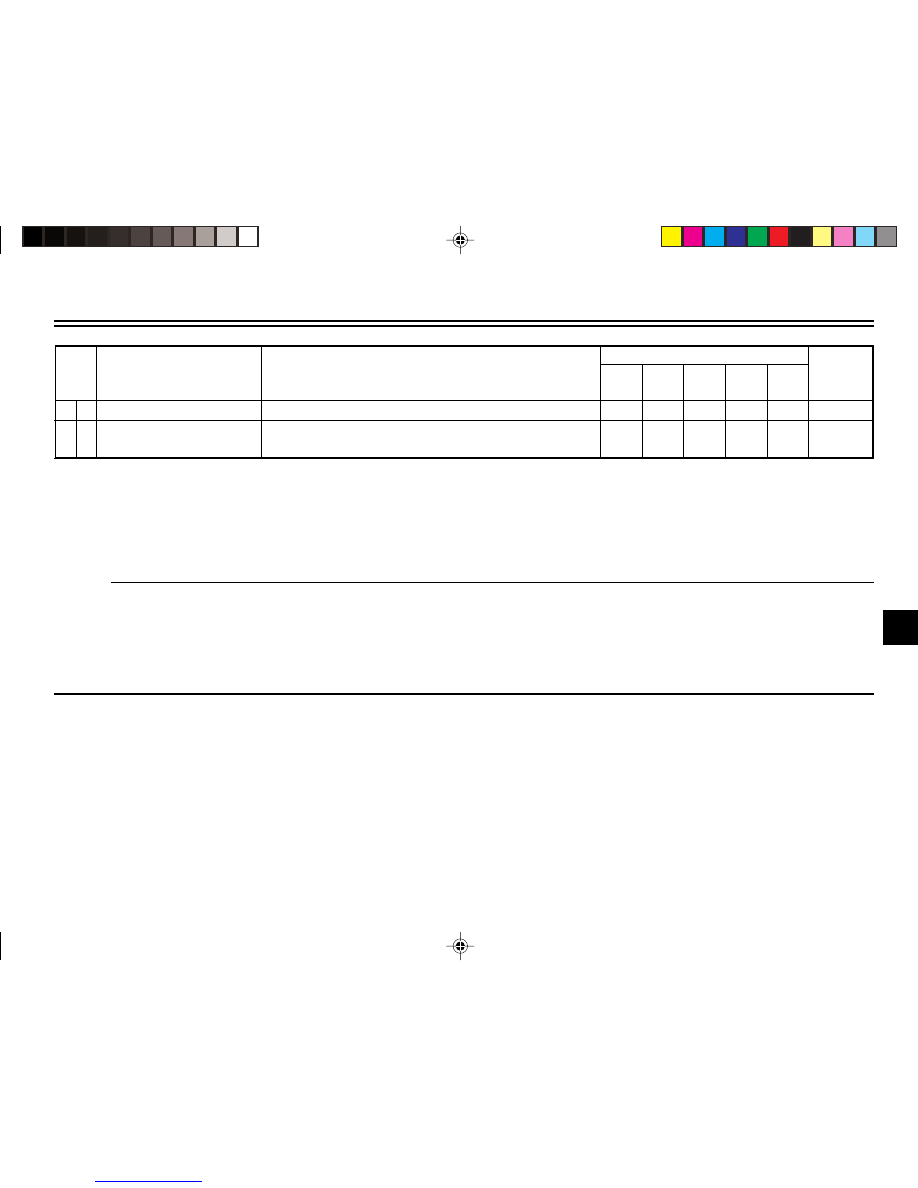
PERIODIC MAINTENANCE AND MINOR REPAIR
6
EAU03541*
NOTE :
•
The air filter needs more frequent service if you are riding in unusually wet or dusty areas.
•
Hydraulic brake service
•
Regularly check and, if necessary, correct the brake fluid level.
•
Every two years change the brake fluid.
•
Replace the brake hoses every four years and if cracked or damaged.
21
Moving parts and cables
• Lubricate.
√
√
√
√
√
22
*
Lights, signals
• Check operation.
√
√
√
√
√
√
and switches
• Adjust headlight beam.
ODOMETER READING (x 1,000 km)
NO.
ITEM
CHECK OR MAINTENANCE JOB
1
ANNUAL
CHECK
6
12
18
24
6-4
Ofrecido por www.electromanuales.com
manuals search engine
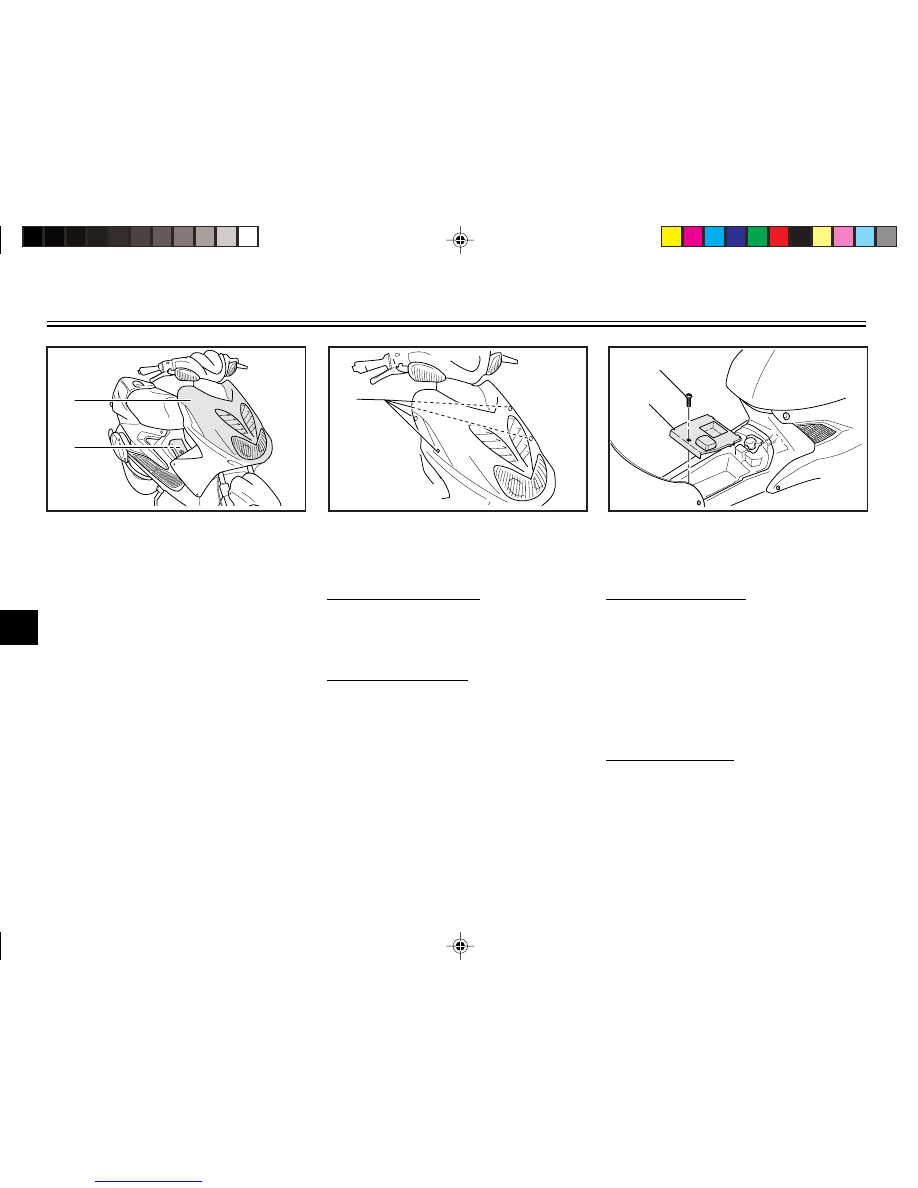
PERIODIC MAINTENANCE AND MINOR REPAIR
6
EAU03810
Removing and installing the
cowling and panel
The cowling and panel shown above
need to be removed to perform some
of the maintenance jobs described in
this chapter. Refer to this section each
time a cowling or panel needs to be
removed and installed.
1
2
ZAUM0270
1. Cowling A
2. Panel A
EAU00482
Cowling A
To remove the cowling
Remove the screws, and then take the
cowling off.
To install the cowling
Place the cowling in the original posi-
tion, and then install the screws.
1
ZAUM0271
1. Screws
2
1
ZAUM0272
1. Panel A
2. Screw
6-5
EAUM0084
Panel A
To remove the panel
1. Open the storage compartment.
(See page 3-11 for storage
compartment opening and closing
procedures.)
2. Remove the screw, and then take
the panel off.
To install the panel
1. Place the panel in the original po-
sition, and then install the screw.
2. Close the storage compartment.
Ofrecido por www.electromanuales.com
manuals search engine
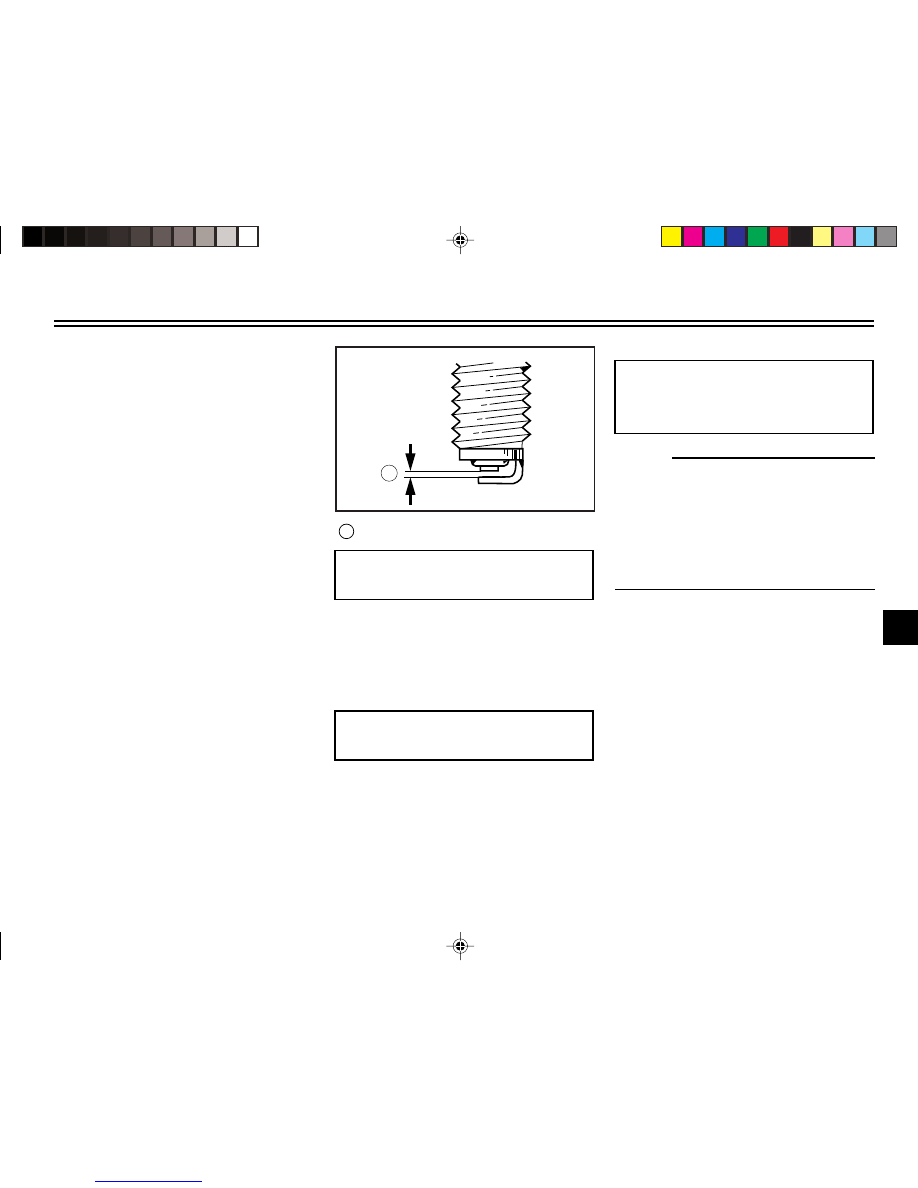
PERIODIC MAINTENANCE AND MINOR REPAIR
6
EAU01651
Checking the spark plug
The spark plug is an important engine
component, which should be checked
periodically, preferably by a Yamaha
dealer. Since heat and deposits will
cause any spark plug to slowly erode,
it should be removed and checked in
accordance with the periodic mainte-
nance and lubrication chart. In addition,
the condition of the spark plug can
reveal the condition of the engine.
The porcelain insulator around the
center electrode of the spark plug
should be a medium-to-light tan (the
ideal color when the scooter is ridden
normally). If the spark plug shows a
distinctly different color, the engine
could be defective. Do not attempt to
diagnose such problems yourself.
Instead, have a Yamaha dealer check
the scooter.
If the spark plug shows signs of
electrode erosion and excessive carbon
or other deposits, it should be replaced.
Specified spark plug:
BR8HS (NGK)
Before installing a spark plug, the spark
plug gap should be measured with a
wire thickness gauge and, if necessary,
adjusted to specification.
Spark plug gap:
0.5 — 0.7 mm
Clean the surface of the spark plug
gasket and its mating surface, and then
wipe off any grime from the spark plug
threads.
a
ZAUM0037
a Spark plug gap
Tightening torque:
Spark plug:
20 Nm (2.0 m
•
kg)
NOTE :
If a torque wrench is not available when
installing a spark plug, a good estimate
of the correct torque is 1/4—1/2 turn
past finger tight. However, the spark
plug should be tightened to the
specified torque as soon as possible.
6-6
Ofrecido por www.electromanuales.com
manuals search engine
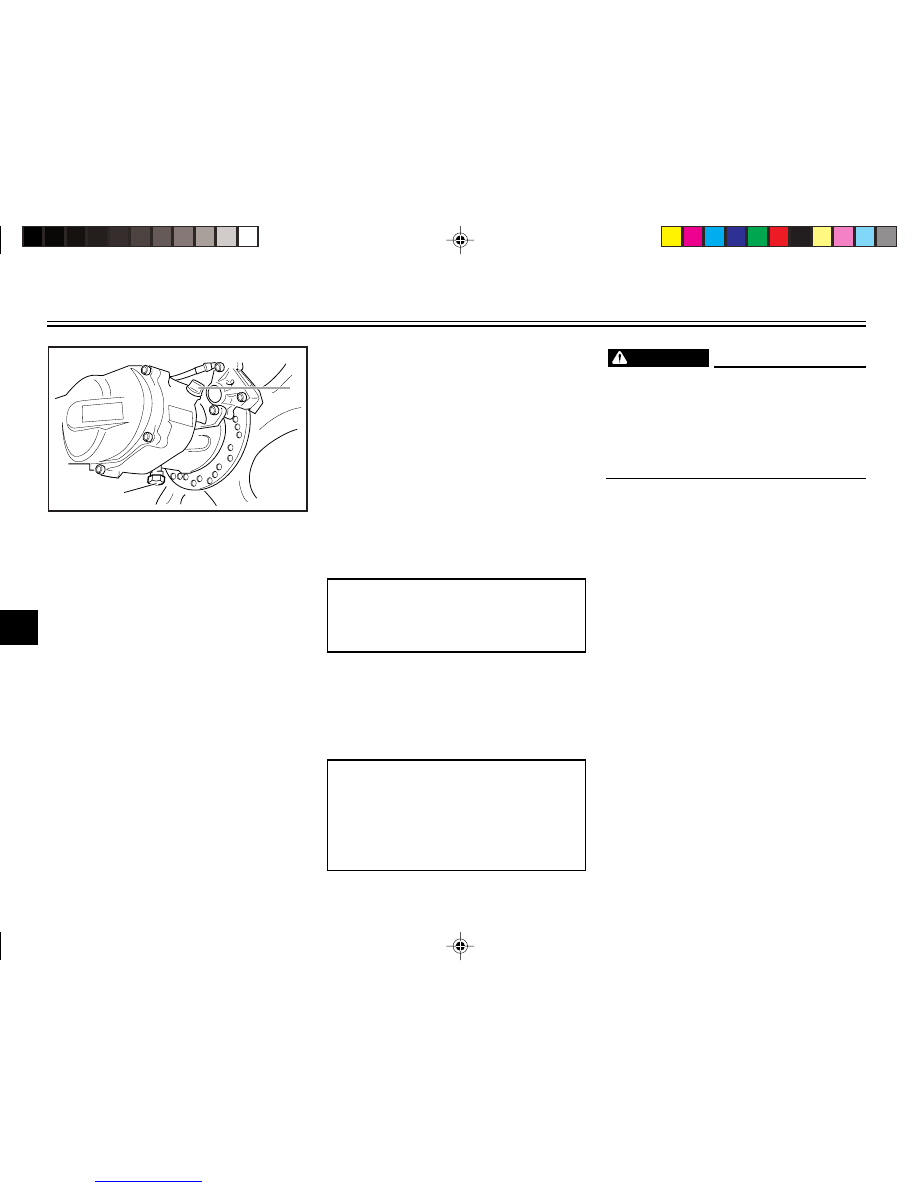
PERIODIC MAINTENANCE AND MINOR REPAIR
6
EWA00062
•
Make sure that no foreign
material enters the final trans-
mission case.
•
Make sure that no oil gets on
the tire or wheel.
7. Check the final transmission case
for oil leakage. If oil is leaking,
check for the cause.
WARNING
EAU04228
Final transmission oil
The final transmission case must be
checked for oil leakage before each
ride. If any leakage is found, have a
Yamaha dealer check and repair the
scooter. In addition, the final transmis-
sion oil must be changed as follows at
the intervals specified in the periodic
maintenance and lubrication chart.
1. Start the engine, warm it up by
riding the scooter for several mi-
nutes, and then stop the engine.
2. Place the scooter on the
centerstand.
3. Place an oil pan under the final
transmission case to collect the
used oil.
4. Remove the oil filler cap and drain
bolt to drain the oil from the final
transmission case.
5. Install the final transmission oil
drain bolt, and then tighten it to
the specified torque.
Tightening torque:
Final transmission oil drain bolt:
18 Nm (1.8 m
•
kgf)
6. Add the specified amount of the
recommended final transmission
oil, and then install and tighten the
oil filler cap.
Recommended final transmission
oil:
See page 8-1.
Oil quantity:
0.13 L
1
2
ZAUM0273
1. Final transmission oil drain bolt
2. Oil filler cap
6-7
Ofrecido por www.electromanuales.com
manuals search engine
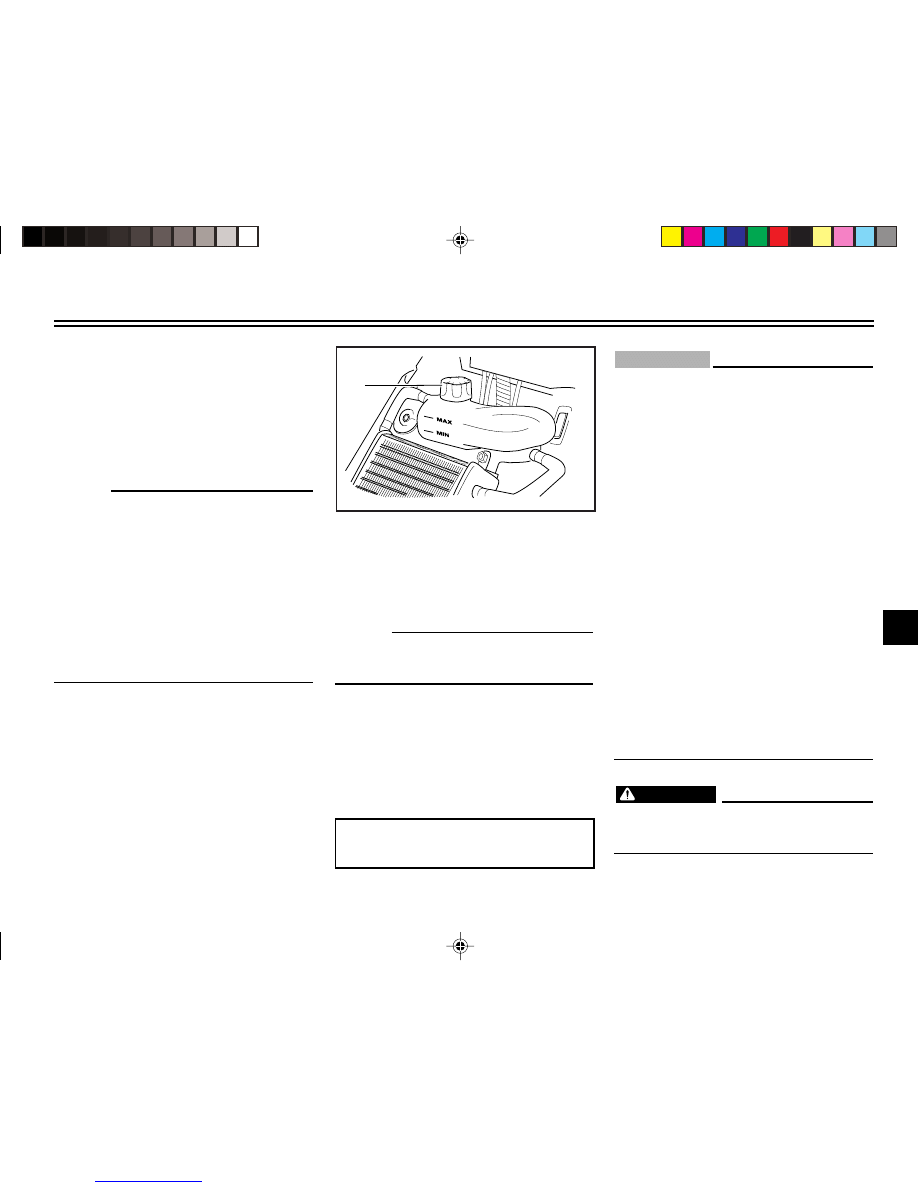
PERIODIC MAINTENANCE AND MINOR REPAIR
6
EC000080
•
If coolant is not available, use
distilled water or soft tap water
instead. Do not use hard water
or salt water since it is harmful
to the engine.
•
If water has been used instead
of coolant, replace it with
coolant as soon as possible,
otherwise the engine may not
be sufficiently cooled and the
cooling system will not be
protected against frost and cor-
rosion.
•
If water has been added to the
coolant, have a Yamaha dealer
check the antifreeze content of
the coolant as soon as possi-
ble, otherwise the effectiveness
of the coolant will be reduced.
EW000067
Never attempt to remove the radiator
cap when the engine is hot.
CAUTION:
WARNING
EAU01808*
Coolant
To check the coolant level
1. Place the scooter on a level sur-
face and hold it in an upright po-
sition.
NOTE :
•
The coolant level must be
checked on a cold engine since
the level varies with engine
temperature.
•
Make sure that the scooter is
positioned straight up when
checking the coolant level. A slight
tilt to the side can result in a false
reading.
2. Remove cowling A. (See page
6-5 for cowling removal and ins-
tallation procedures.)
3. Check the coolant level in the
coolant reservoir.
NOTE :
The coolant should be between the
minimum and maximum level marks.
4. If the coolant is at or below the
minimum level mark, open the
reservoir cap, add coolant to the
maximum level mark, and then
close the reservoir cap.
Coolant reservoir capacity:
0.25 L
1
ZAUM0274
1. Coolant tank cap
6-8
Ofrecido por www.electromanuales.com
manuals search engine
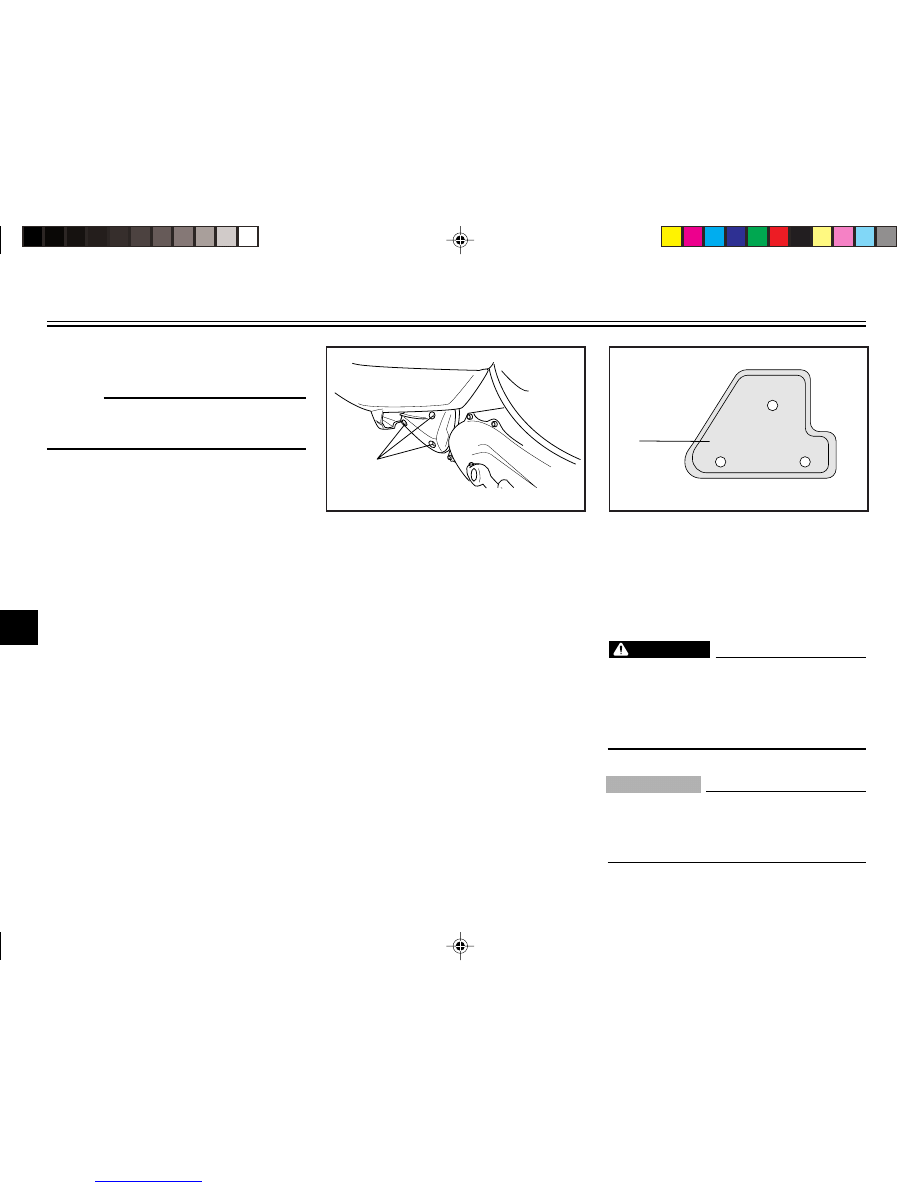
PERIODIC MAINTENANCE AND MINOR REPAIR
6
1
ZAUM0276
1. Air filter element
5. Install the cowling.
NOTE :
If the engine overheats, see page 6-24
for further instructions.
1
ZAUM0275
1. Screws
EAUM0071
Cleaning the air filter
element
The air filter element should be cleaned
at the intervals specified in the periodic
maintenance and lubrication chart.
Clean the air filter element more
frequently if you are riding in unusually
wet or dusty areas.
1. Remove the air filter case cover
by removing the screws.
2. Pull the air filter element out, clean
it with solvent, and then squeeze
the remaining solvent out.
EW000075
Use only a dedicated parts cleaning
solvent. To avoid the risk of fire or
explosion, do not use gasoline or
solvents with a low flash point.
EC000089
To avoid damaging the foam material,
handle it gently and carefully, and do
not twist or wring it.
WARNING
CAUTION:
6-9
Ofrecido por www.electromanuales.com
manuals search engine
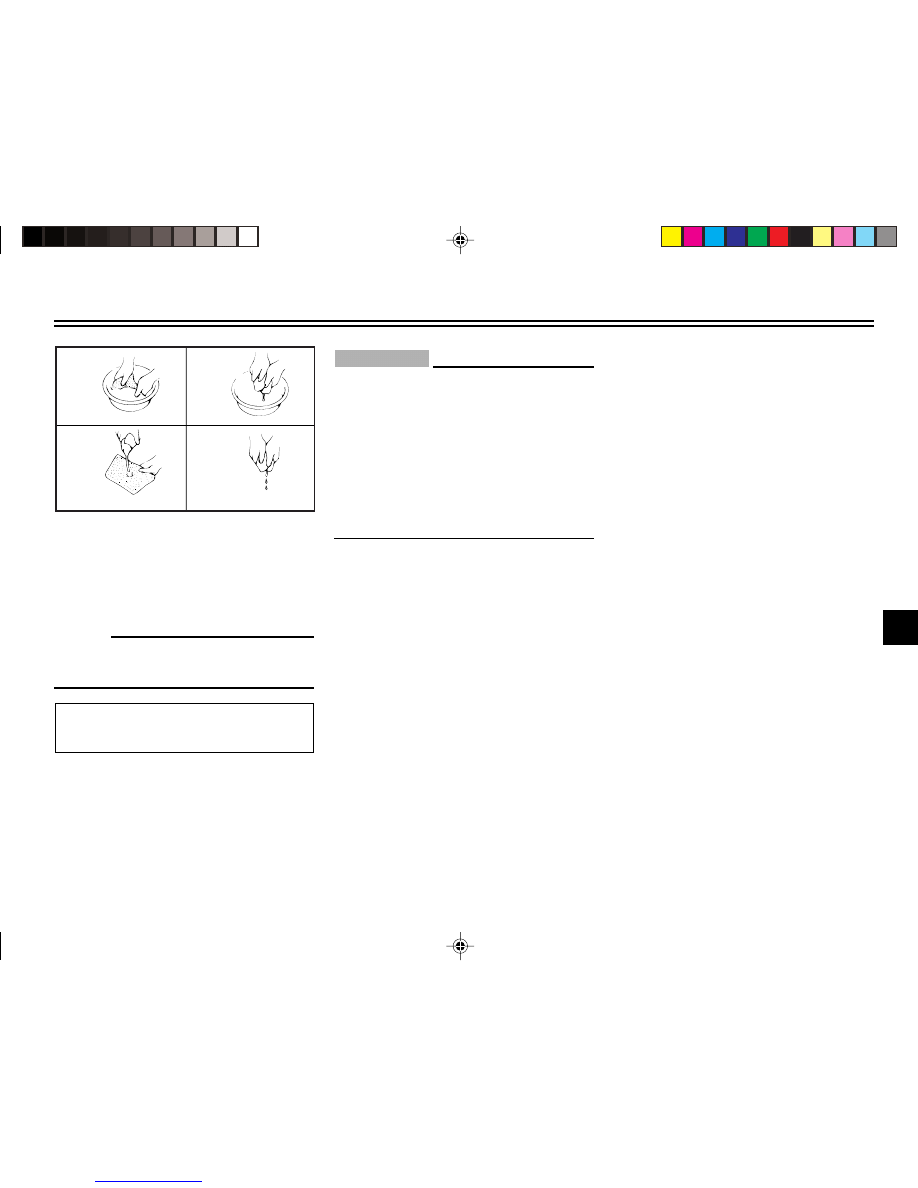
PERIODIC MAINTENANCE AND MINOR REPAIR
6
1
4
3
2
ZAUM0156
3. Apply oil of the recommended
type to the entire surface of the
element, and then squeeze the
excess oil out.
NOTE :
The air filter element should be wet but
not dripping.
Recommended oil:
Engine oil
4. Insert the element into the air filter
case.
CAUTION:
EC000082
•
Make sure that the air filter
element is properly seated in
the air filter case.
•
The engine should never be
operated without the air filter
element installed, otherwise the
piston(s) and/or cylinder(s) may
become excessively worn.
5. Install the air filter case cover by
installing the screws.
6-10
EAU00631
Adjusting the carburetor
The carburetor is an important part of
the engine and requires very
sophisticated adjustment. Therefore, all
carburetor adjustments should be left
to a Yamaha dealer, who has the
necessary professional knowledge and
experience.
Ofrecido por www.electromanuales.com
manuals search engine
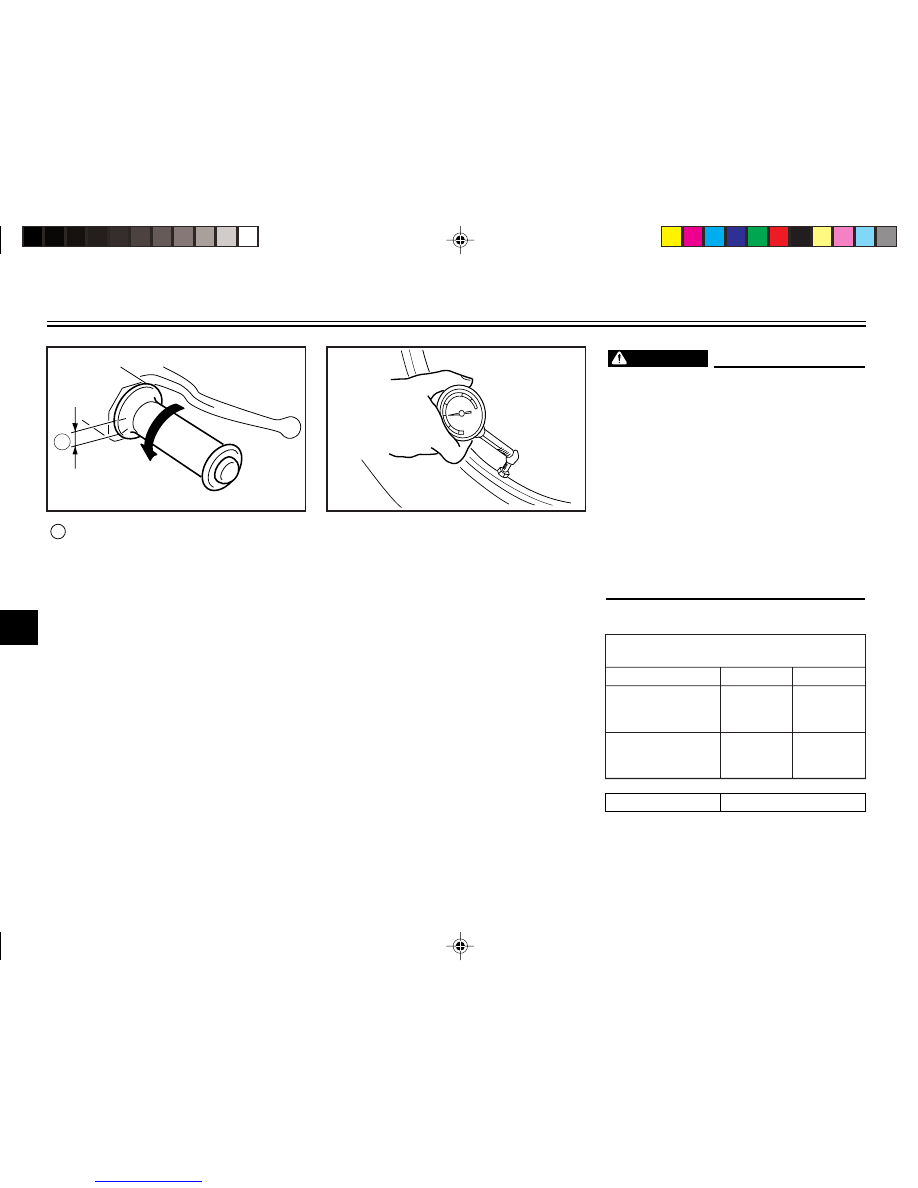
PERIODIC MAINTENANCE AND MINOR REPAIR
6
EAU04551
Tires
To maximize the performance,
durability, and safe operation of your
scooter, note the following points
regarding the specified tires.
Tire air pressure
The tire air pressure should be checked
and, if necessary, adjusted before each
ride.
EW000082
•
The tire air pressure must be
checked and adjusted on cold
tires (i.e., when the temperature
of the tires equals the ambient
temperature).
•
The tire air pressure must be
adjusted in accordance with the
riding speed and with the total
weight of rider, passenger,
cargo,
and
accessories
approved for this model.
WARNING
0
1
2
3
4
ZAUM0053
Tire air pressure
(measured on cold tires)
Load*
Front
Rear
Up to 90 kg*
150 kPa
1.5 kgf/cm
2
1.5 bar
150 kPa
1.5 kgf/cm
2
1.5 bar
90 kg ~
maximum*
150 kPa
1.5 kgf/cm
2
1.5 bar
170 kPa
1.7 kgf/cm
2
1.7 bar
Maximum load*
180 kg
* Total weight of rider, passenger, cargo and
accessories
6-11
a
ZAUM0051
EAU00635
Adjusting the throttle cable
free play
The throttle cable free play should
measure 1.0 — 3.0 mm at the throttle
grip. Periodically check the throttle cable
free play and, if necessary, have a
Yamaha dealer adjust it.
a Throttle cable free play
Ofrecido por www.electromanuales.com
manuals search engine
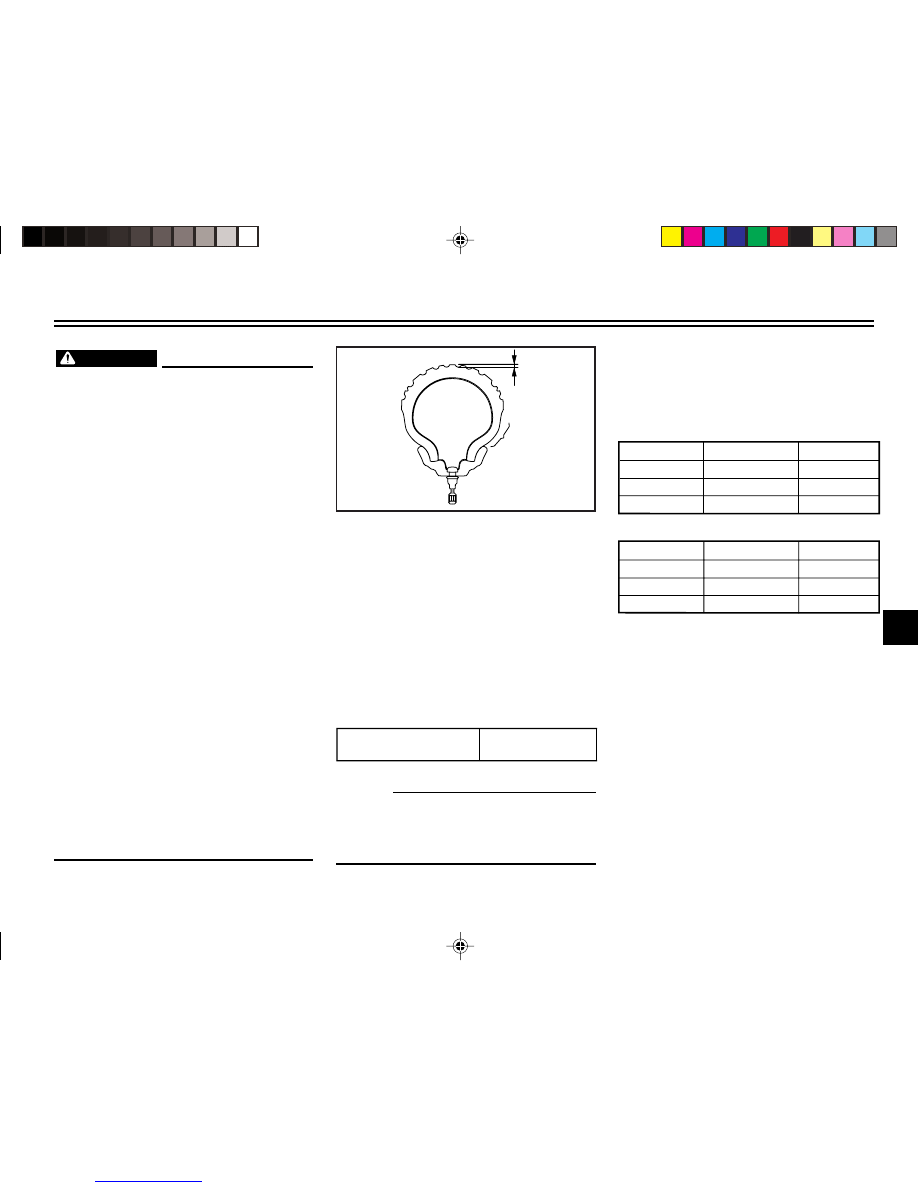
PERIODIC MAINTENANCE AND MINOR REPAIR
6
Tire inspection
The tires must be checked before each
ride. If the center tread depth reaches
the specified limit, if the tire has a nail
or glass fragments in it, or if the sidewall
is cracked, have a Yamaha dealer re-
place the tire immediately.
1
2
ZAUM0054
1. Tread depth
2. Side wall
Tire information
This scooter is equipped with tubeless
tires.
Minimum tire tread depth
(front and rear)
1.6 mm
NOTE :
The tire tread depth limits may differ
from country to country. Always comply
with the local regulations.
Front
Manufacturer
Size
Type
PIRELLI
M
130/60-13M
SL36
Rear
Manufacturer
Size
Type
MICHELIN
M
130/60-13M
BOPPER
PIRELLI
M
130/60-13M
EVO 21
PIRELLI
M
140/60-13M
SL36
MICHELIN
M
140/60-13M
BOPPER
PIRELLI
M
140/60-13 M
EVO 22
6-12
EW000077
Because loading has an enormous
impact on the handling, braking, per-
formance and safety characteristics of
your scooter, you should keep the
following precautions in mind.
•
NEVER OVERLOAD THE SCOO-
TER! Operation of an overloaded
scooter may result in tire damage,
loss of control, or severe injury.
Make sure that the total weight of
rider, cargo, and accessories
does not exceed the specified
maximum load for the vehicle.
•
Do not carry along loosely
packed items, which can shift
during a ride.
•
Securely pack the heaviest items
close to the center of the scooter
and distribute the weight evenly
on both sides.
•
Adjust the suspension and tire air
pressure with regard to the load.
•
Check the tire condition and air
pressure before each ride.
WARNING
Ofrecido por www.electromanuales.com
manuals search engine
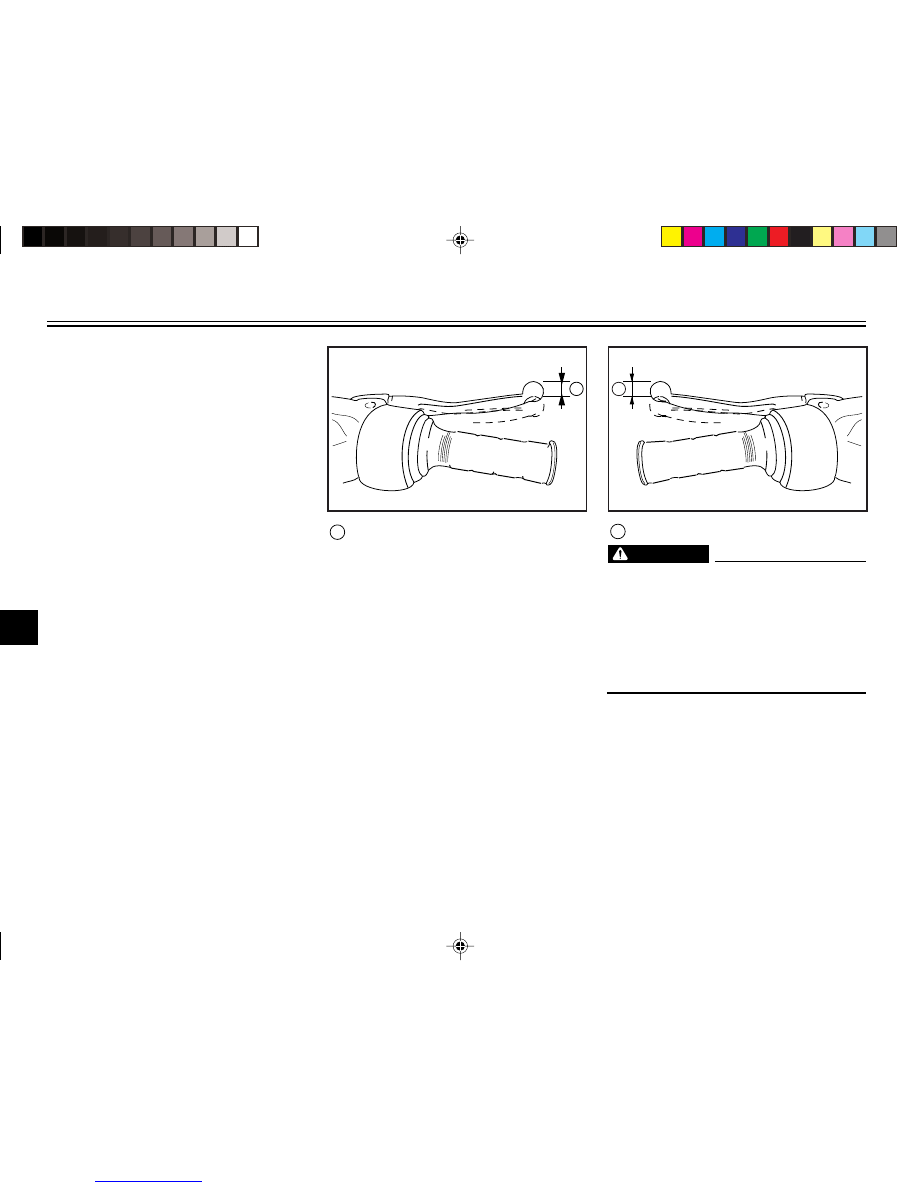
PERIODIC MAINTENANCE AND MINOR REPAIR
6
EAUM0056
Adjusting the front and rear
brake lever free play
The front and rear brake lever free play
should measure 10 — 20 mm as shown.
Periodically check the front and rear
brake lever free play and, if necessary,
have a Yamaha dealer adjust it.
EW000100
An incorrect brake lever free play
indicates a hazardous condition in
the brake system. Do not operate the
scooter until the brake system has
been checked or repaired by a
Yamaha dealer.
WARNING
a
ZAUM0107
a
ZAUM0108
a Front brake lever free play
a Rear brake lever free play
6-13
EAU03773
Cast wheels
To maximize the performance,
durability, and safe operation of your
scooter, note the following points
regarding the specified wheels.
•
The wheel rims should be
checked for cracks, bends or
warpage before each ride. If any
damage is found, have a Yamaha
dealer replace the wheel. Do not
attempt even the smallest repair
to the wheel. A deformed or
cracked wheel must be replaced.
•
The wheel should be balanced
whenever either the tire or wheel
has been changed or replaced. An
unbalanced wheel can result in
poor performance, adverse
handling characteristics, and a
shortened tire life.
•
Ride at moderate speeds after
changing a tire since the tire surface
must first be "broken in" for it to
develop its optimal characteristics.
Ofrecido por www.electromanuales.com
manuals search engine
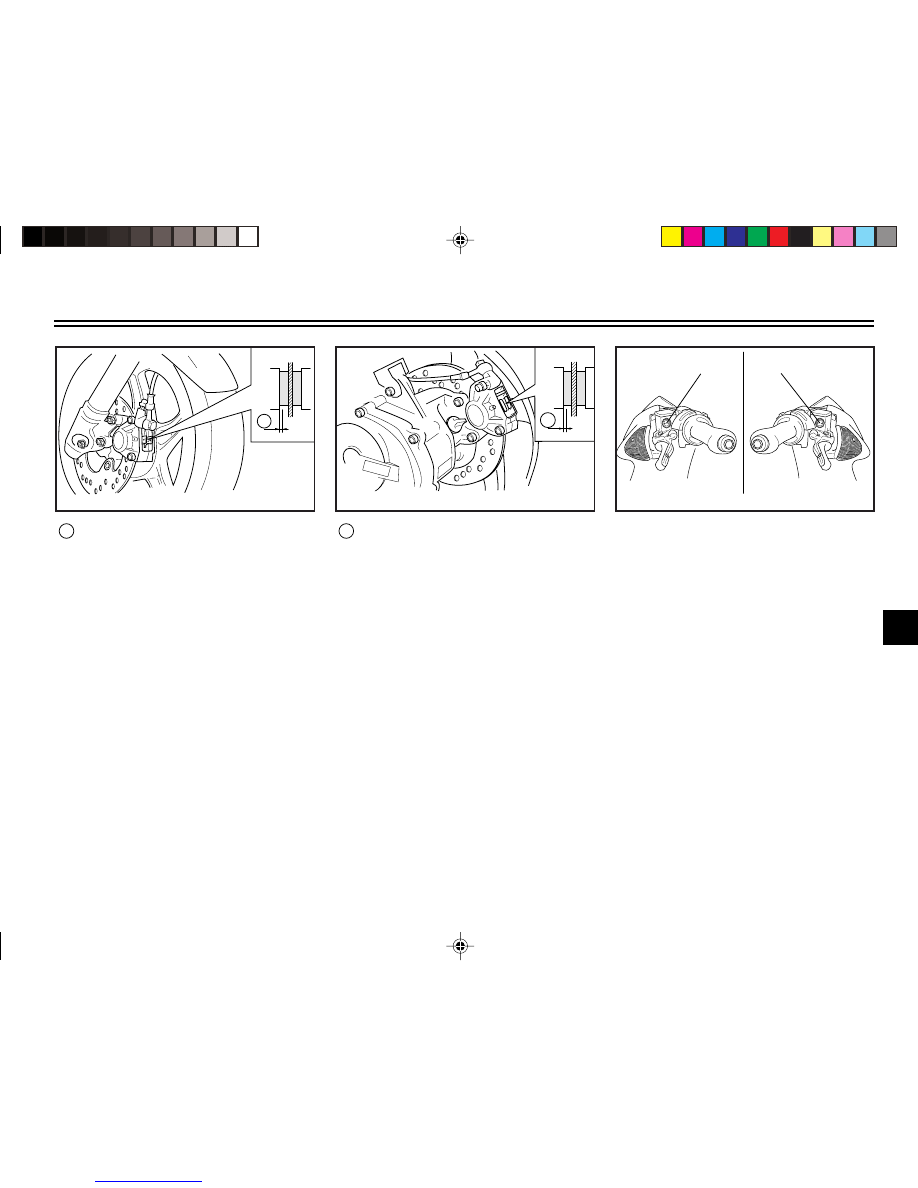
PERIODIC MAINTENANCE AND MINOR REPAIR
6
EAU00717
Checking the front and rear
brake pads
The front and rear brake pads must be
checked for wear at the intervals
specified in the periodic maintenance
and lubrication chart. To check the
brake pad wear, measure the lining
thickness. If the lining thickness is less
than 2.0 mm, have a Yamaha dealer
replace the brake pads as a set.
a
ZAUM0277
a
ZAUM0278
a Brake pad thickness
a Brake pad thickness
EAU00732
Checking the brake fluid
level
Insufficient brake fluid may allow air to
enter the brake system, possibly
causing it to become ineffective.
Before riding, check that the brake fluid
is above the minimum level mark and
replenish if necessary. A low brake fluid
level may indicate worn brake pads and/
or brake system leakage. If the brake
level is low, be sure to check the brake
pads for wear and the brake system for
leakage.
1
1
ZAUM0280
1. Brake fluid minimum level
6-14
Ofrecido por www.electromanuales.com
manuals search engine
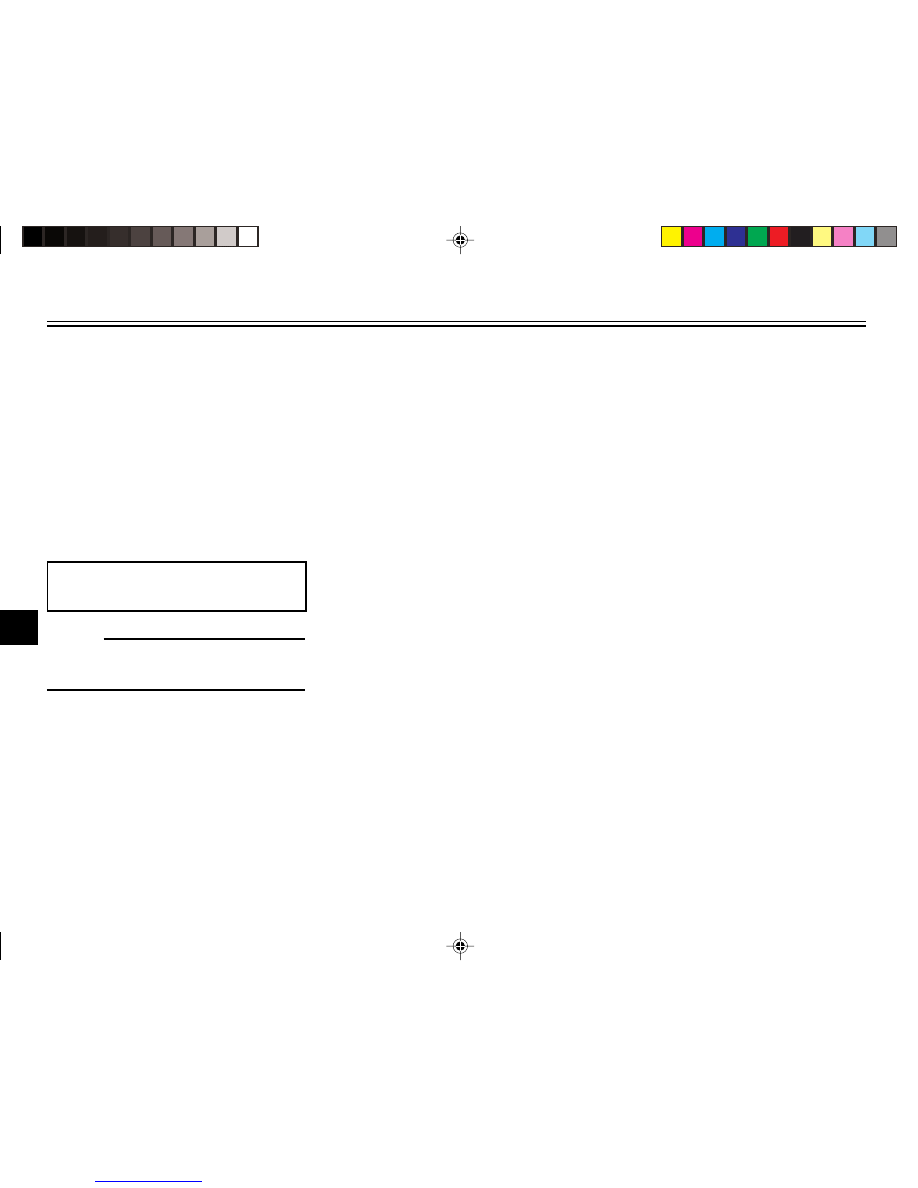
PERIODIC MAINTENANCE AND MINOR REPAIR
6
Observe these precautions:
•
When checking the fluid level,
make sure that the top of the
master cylinder is level by turning
the handlebars.
•
Use only the recommended
quality brake fluid, otherwise the
rubber seals may deteriorate,
causing leakage and poor braking
performance.
Recommended brake fluid:
DOT 4
NOTE :
If DOT 4 is not available, DOT 3 can be
used.
•
Refill with the same type of brake
fluid. Mixing fluids may result in a
harmful chemical reaction and
lead to poor braking performance.
•
Be careful that water does not
enter the master cylinder when
refilling. Water will significantly
lower the boiling point of the fluid
and may result in vapor lock.
•
Brake fluid may deteriorate
painted surfaces or plastic parts.
Always clean up spilled fluid
immediately.
•
As the brake pads wear, it is nor-
mal for the brake fluid level to
gradually go down. However, if the
brake fluid level goes down
suddenly, have a Yamaha dealer
check the cause.
EAUM0008*
Changing the brake fluid
Have a Yamaha dealer change the
brake fluid at the intervals specified in
the periodic maintenance and
lubrication chart. In addition, have the
brake hoses replaced every four years
or whenever there are damaged or
leaking.
6-15
EAU00774
Adjusting the Autolube pump
The Autolube pump is a vital and
sophisticated component of the engine,
which must be adjusted by a Yamaha
dealer at the intervals specified in the
periodic maintenance and lubrication
chart.
Ofrecido por www.electromanuales.com
manuals search engine
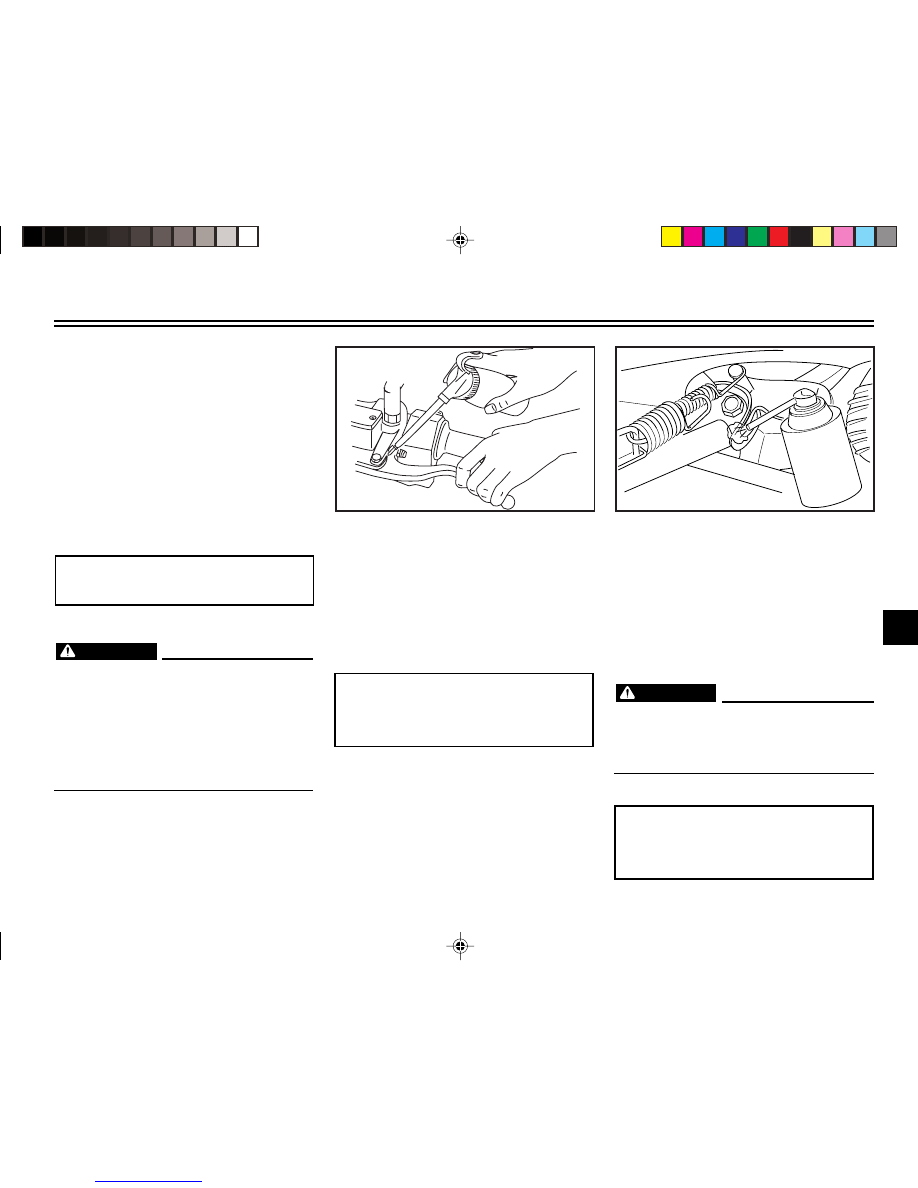
PERIODIC MAINTENANCE AND MINOR REPAIR
6
ZAUM0061
EAU03118
Lubricating the front and rear
brake levers
The pivoting points of the front and rear
brake levers must be lubricated at the
intervals specified in the periodic main-
tenance and lubrication chart.
Recommended lubricant:
Lithium-soap-based grease
(all-purpose grease)
ZAUM0062
EAU04123
Checking and lubricating the
centerstand
The operation of the centerstand should
be checked before each ride, and the
pivots and metal-to-metal contact sur-
faces should be lubricated if necessary.
EWA00055
If the centerstand does not move up
and down smoothly, have a Yamaha
dealer check or repair it.
Recommended lubricant:
Lithium-soap-based grease
(all-purpose grease)
WARNING
6-16
EAU02962
Checking and lubricating the
cables
The operation of all control cables and
the condition of the cables should be
checked before each ride, and the cables
and cable ends should be lubricated if
necessary. If a cable is damaged or does
not move smoothly, have a Yamaha dea-
ler check or replace it.
Recommended lubricant:
Engine oil
EW000112
Damage to the outer sheath may
interfere with proper cable operation
and will cause the inner cable to rust.
Replace a damaged cable as soon
as possible to prevent unsafe con-
ditions.
WARNING
Ofrecido por www.electromanuales.com
manuals search engine
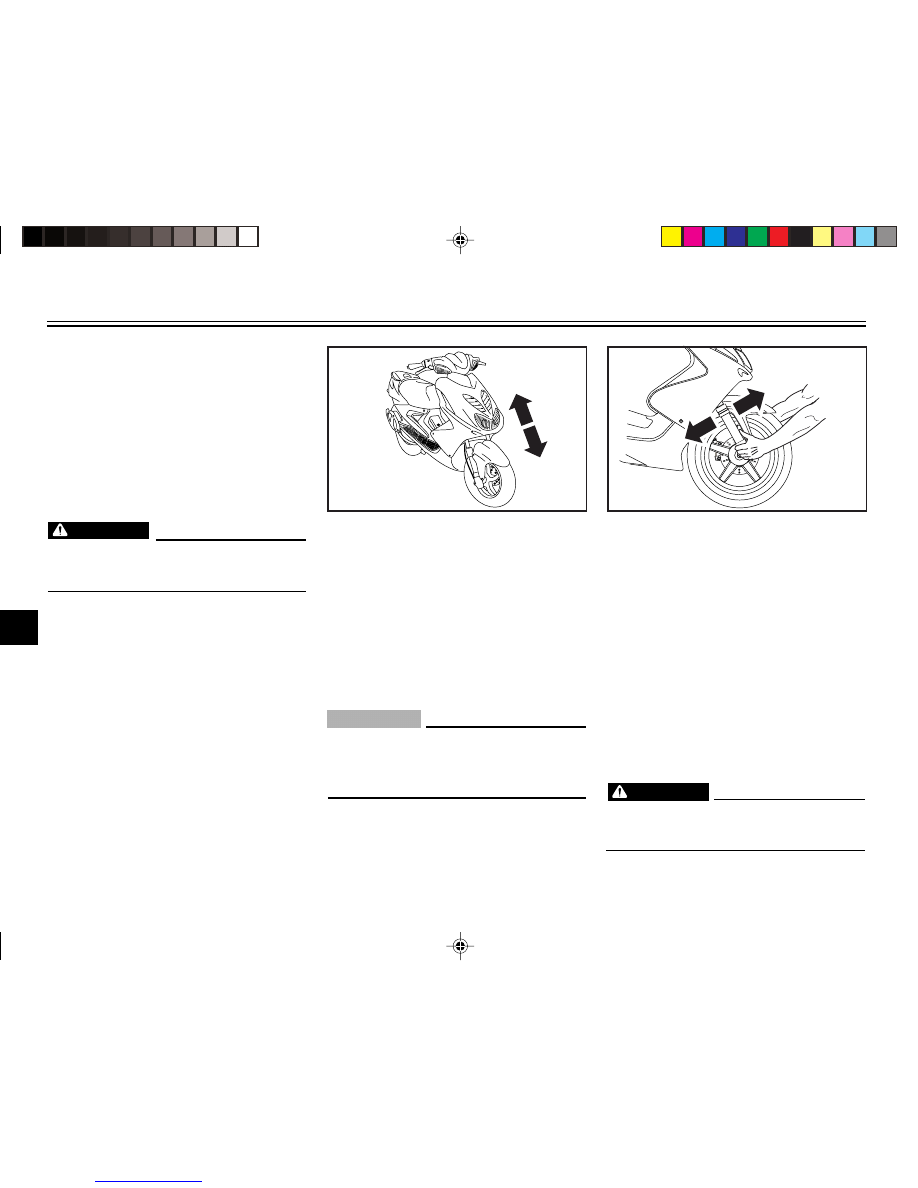
PERIODIC MAINTENANCE AND MINOR REPAIR
6
EAU02939
Checking the front fork
The condition and operation of the front
fork must be checked as follows at the
intervals specified in the periodic main-
tenance and lubrication chart.
To check the condition
EW000115
Securely support the scooter so that
there is no danger of it falling over.
Check the inner tubes for scratches,
damage and excessive oil leakage.
WARNING
To check the operation
1. Place the scooter on a level sur-
face and hold it in an upright po-
sition.
2. While applying the front brake,
push down hard on the
handlebars several times to check
if the front fork compresses and
rebounds smoothly.
EC000098
If any damage is found or the front
fork does not operate smoothly, have
a Yamaha dealer check or repair it.
CAUTION:
EAU00794
Checking the steering
Worn or loose steering bearings may
cause danger. Therefore, the operation
of the steering must be checked as
follows at the intervals specified in the
periodic maintenance and lubrication
chart.
1. Place a stand under the engine
to raise the front wheel off the
ground.
EW000115
Securely support the scooter so that
there is no danger of it falling over.
WARNING
6-17
ZAUM0296
ZAUM0297
Ofrecido por www.electromanuales.com
manuals search engine
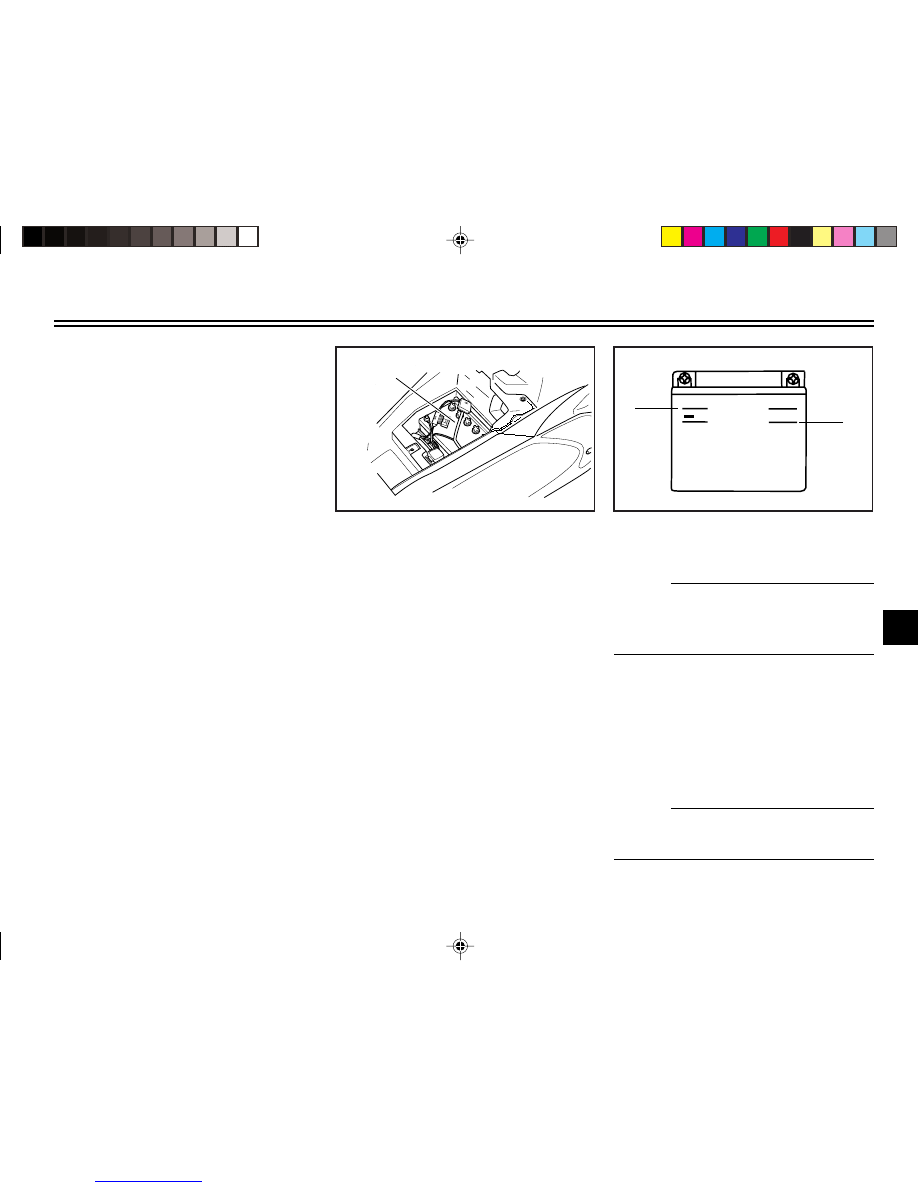
PERIODIC MAINTENANCE AND MINOR REPAIR
6
EAU01144
Checking the wheel bearings
The front and rear wheel bearings must
be checked at the intervals specified in
the periodic maintenance and
lubrication chart. If there is play in the
wheel hub or if the wheel does not turn
smoothly, have a Yamaha dealer check
the wheel bearings.
1
ZAUM0281
1. Battery
EAUM0049
Battery
A poorly maintained battery will corrode
and discharge quickly. The electrolyte
level, battery lead connections and
breather hose routing should be
checked before each ride and at the
intervals specified in the periodic main-
tenance and lubrication chart.
To check the electrolyte level
1. Place the scooter on a level sur-
face and hold it in an upright posi-
tion.
NOTE :
Make sure that the scooter is positioned
straight up when checking the
electrolyte level.
2. Remove panel A. (See page 6-5
for panel removal and installation
procedures.)
3. Check the electrolyte level in the
battery.
NOTE :
The electrolyte should be between the
minimum and maximum level marks.
1
2
+
UPPER
LOWER
ZAUM0106
1. Maximum level
2. Minimum level
6-18
2. Hold the lower ends of the front
fork legs and try to move them
forward and backward. If any free
play can be felt, have a Yamaha
dealer check or repair the
steering.
Ofrecido por www.electromanuales.com
manuals search engine
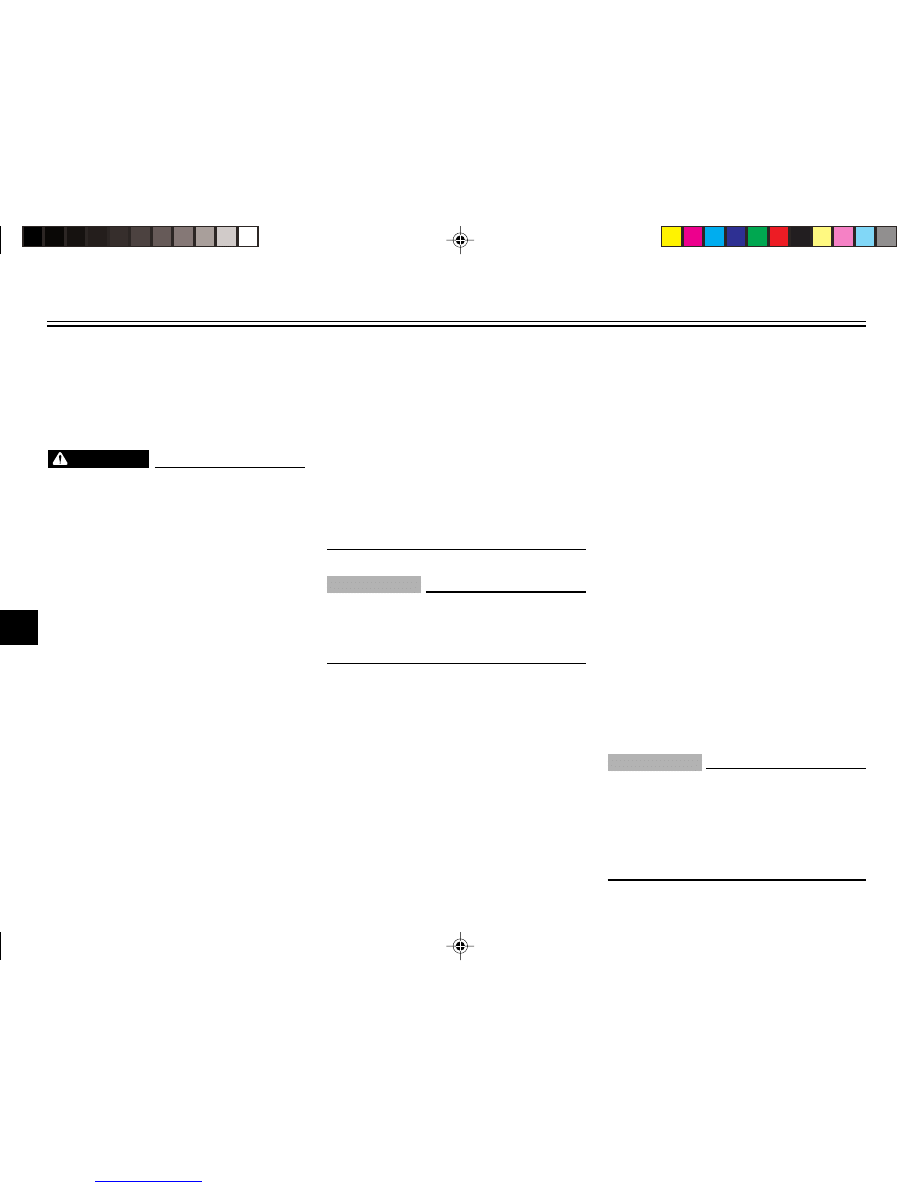
PERIODIC MAINTENANCE AND MINOR REPAIR
6
4. If the electrolyte is at or below the
minimum level mark, add distilled
water to raise it to the maximum
level mark.
EW000116
•
Electrolyte is poisonous and
dangerous since it contains
sulfuric acid, which causes
severe burns. Avoid any con-
tact with skin, eyes or clothing
and always shield your eyes
when working near batteries. In
case of contact, administer the
following FIRST AID.
•
EXTERNAL: Flush with
plenty of water.
•
INTERNAL: Drink large
quantities of water or milk
and immediately call a
physician.
•
EYES: Flush with water for 15
minutes and seek prompt
medical attention.
•
Batteries produce explosive
hydrogen gas. Therefore, keep
sparks, flames, cigarettes, etc.,
away from the battery and
provide sufficient ventilation
when charging it in an enclosed
space.
•
KEEP THIS AND ALL BATTE-
RIES OUT OF THE REACH OF
CHILDREN.
EC000100
Use only distilled water, as tap water
contains minerals that are harmful
to the battery.
5. Check and, if necessary, tighten
the battery lead connections and
correct the breather hose routing.
WARNING
CAUTION:
To store the battery
1. If the scooter will not be used for
more than one month, remove the
battery, fully charge it, and then
place it in a cool, dry place.
2. If the battery will be stored for
more than two months, check the
specific gravity of the electrolyte
at least once a month and fully
charge the battery whenever
necessary.
3. Fully charge the battery before
installation.
4. After installation, make sure that
the battery leads are properly
connected to the battery terminals
and that the breather hose is
properly routed, in good condition,
and not obstructed.
EC000099
If the breather hose is positioned in
such a way that the frame is exposed
to electrolyte or gas expelled from
the battery, the frame could suffer
structural and external damages.
CAUTION:
6-19
Ofrecido por www.electromanuales.com
manuals search engine
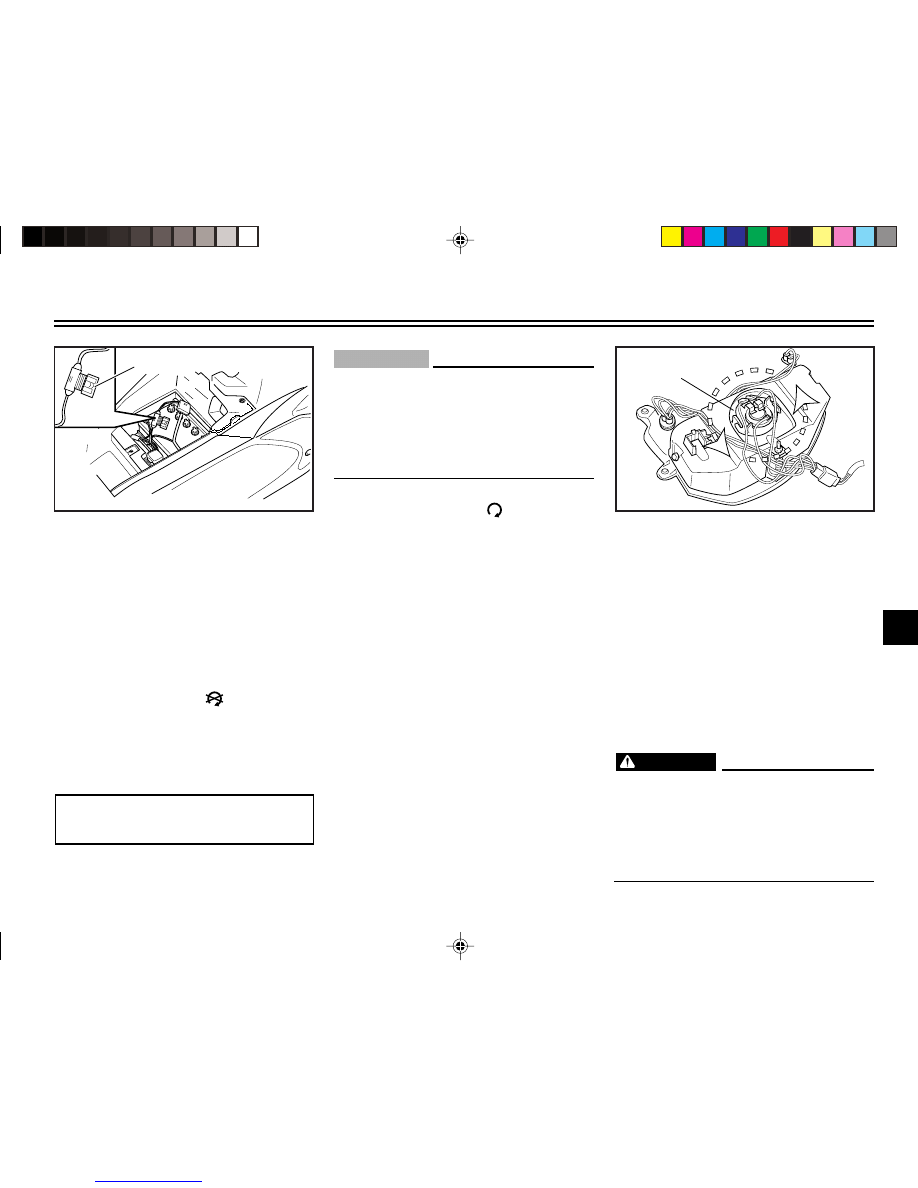
PERIODIC MAINTENANCE AND MINOR REPAIR
6
1
ZAUM0282
1. Fuse
EAU01307
Replacing the fuse
The fuse holder is located behind pa-
nel A. (See page 6-5 for panel removal
and installation procedures.)
If the fuse is blown, replace it as follows.
1. Turn the key to "
" and turn off
all electrical circuits.
2. Remove the blown fuse, and then
install a new fuse of the specified
amperage.
Specified fuse: 7.5 A
EC000103
Do not use a fuse of a higher
amperage rating than recommended
to avoid causing extensive damage
to the electrical system and possibly
a fire.
3. Turn the key to "
" and turn on
the electrical circuits to check if the
devices operate.
4. If the fuse immediately blows
again, have a Yamaha dealer
check the electrical system.
CAUTION:
EAUM0072*
Replacing a headlight bulb
1. Remove cowling A
(See page 6-5 for cowling removal
and installation procedures.)
2. Remove the headlight coupler.
3. Remove the headlight bulb holder by
turning it 1/4 turn counterclockwise.
4. Remove the defective bulb.
EW000119
Headlight bulbs get very hot.
Therefore, keep flammable products
away from a lit headlight bulb, and
do not touch the bulb until it has
cooled down.
1
ZAUM0283
1. Headlight bulb
WARNING
6-20
Ofrecido por www.electromanuales.com
manuals search engine
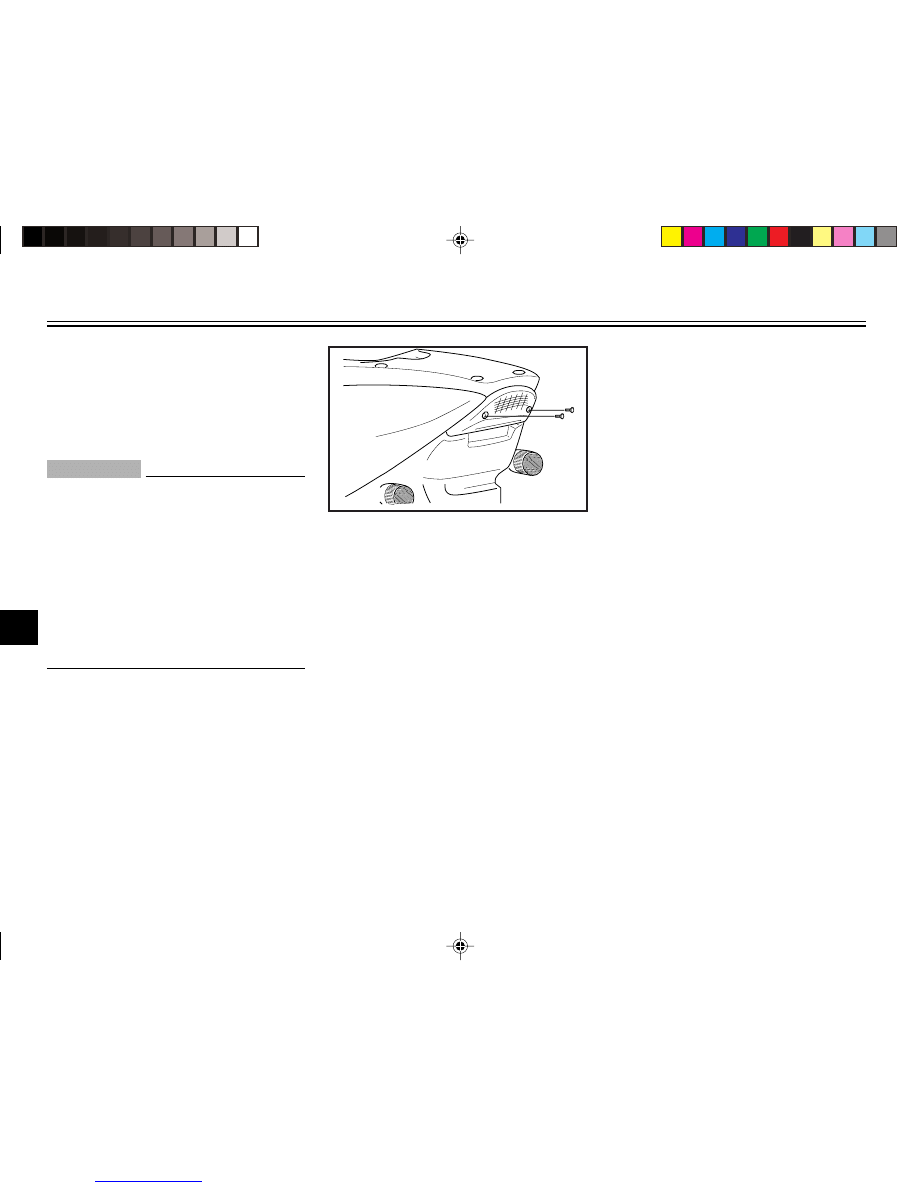
PERIODIC MAINTENANCE AND MINOR REPAIR
6
5. Place a new headlight bulb into
position, and then secure it with
the bulb holder.
6. Connect the headlight coupler
and install the cowling A.
EC000105
Do not touch the glass part of the
headlight bulb to keep it free from
oil, otherwise the transparency of
the glass, the luminosity of the bulb,
and the bulb life will be adversely
affected. Thoroughly clean off any
dirt and fingerprints on the headlight
bulb using a cloth moistened with
alcohol or thinner.
CAUTION:
ZAUM0284
6-21
EAUM0037
Replacing the brake/taillight
bulb
1. Remove the brake/taillight lens by
removing the screws.
2. Remove the brake/taillight bulb
holder by turning it 1/4 turn
counter-clockwise.
3. Remove the defective bulb.
4. Place a new bulb into position, and
then secure it with the bulb holder.
5. Place the brake/taillight lens in the
original position, and then install
the screw.
Ofrecido por www.electromanuales.com
manuals search engine
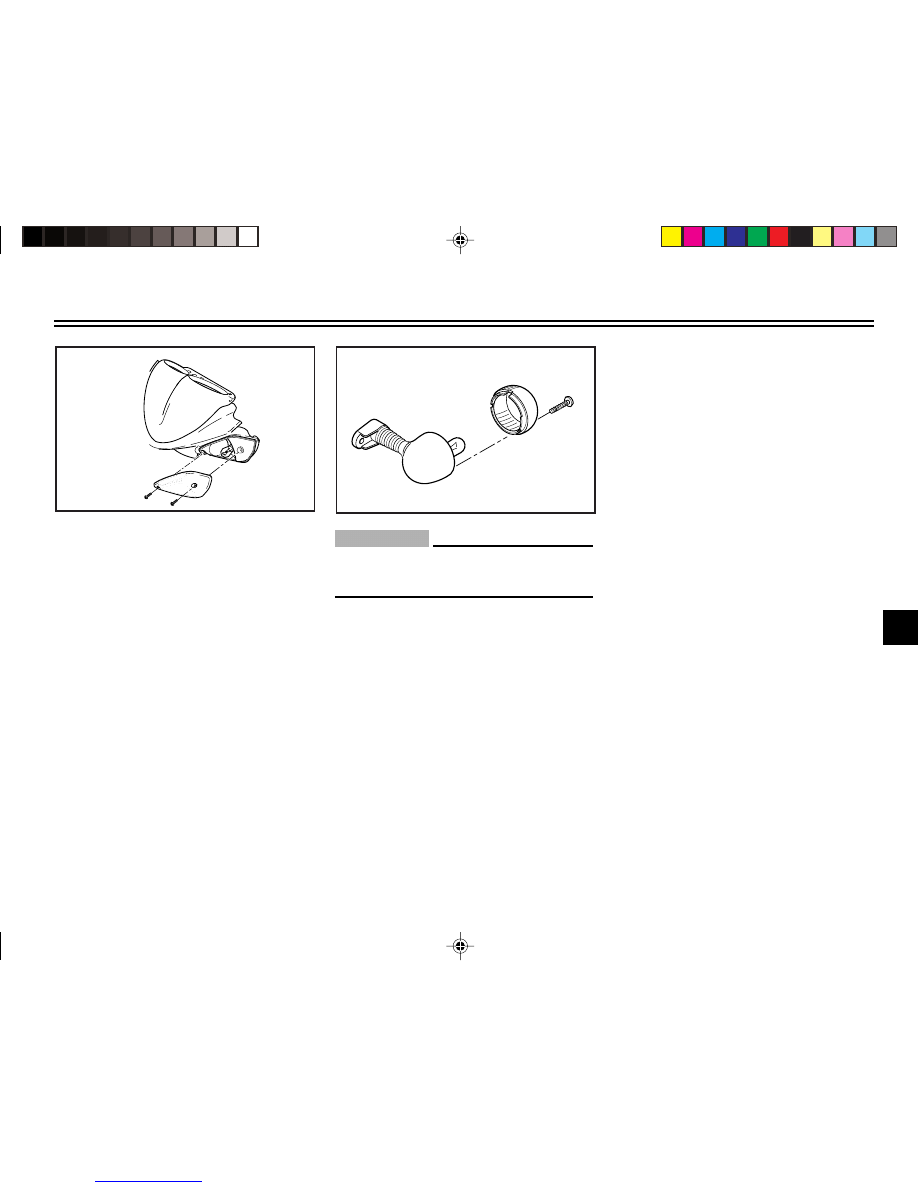
PERIODIC MAINTENANCE AND MINOR REPAIR
6
ZAUM0285
ZAUM0286
EAU03218
Replacing a turn signal light
bulb
1. Remove the turn signal lens by
removing the screws.
2. Remove the defective bulb by
pushing it in and turning it
counterclockwise.
3. Insert a new bulb into the socket,
push it in, and then turn it
clockwise until it stops.
4. Install the lens by installing the
screws.
EC000108
Do not overtighten the screws,
otherwise the lens may break.
CAUTION:
EAU03087
Troubleshooting
Although Yamaha scooters receive a
thorough inspection before shipment
from the factory, trouble may occur
during operation. Any problem in the
fuel, compression, or ignition systems,
for example, can cause poor starting
and loss of power.
The following troubleshooting charts
represent quick and easy procedures
for checking these vital systems
yourself. However, should your scooter
require any repair, take it to a Yamaha
dealer, whose skilled technicians have
the necessary tools, experience, and
know-how to service the scooter
properly.
Use only genuine Yamaha replacement
parts. Imitation parts may look like
Yamaha parts, but they are often
inferior, have a shorter service life and
can lead to expensive repair bills.
6-22
Ofrecido por www.electromanuales.com
manuals search engine
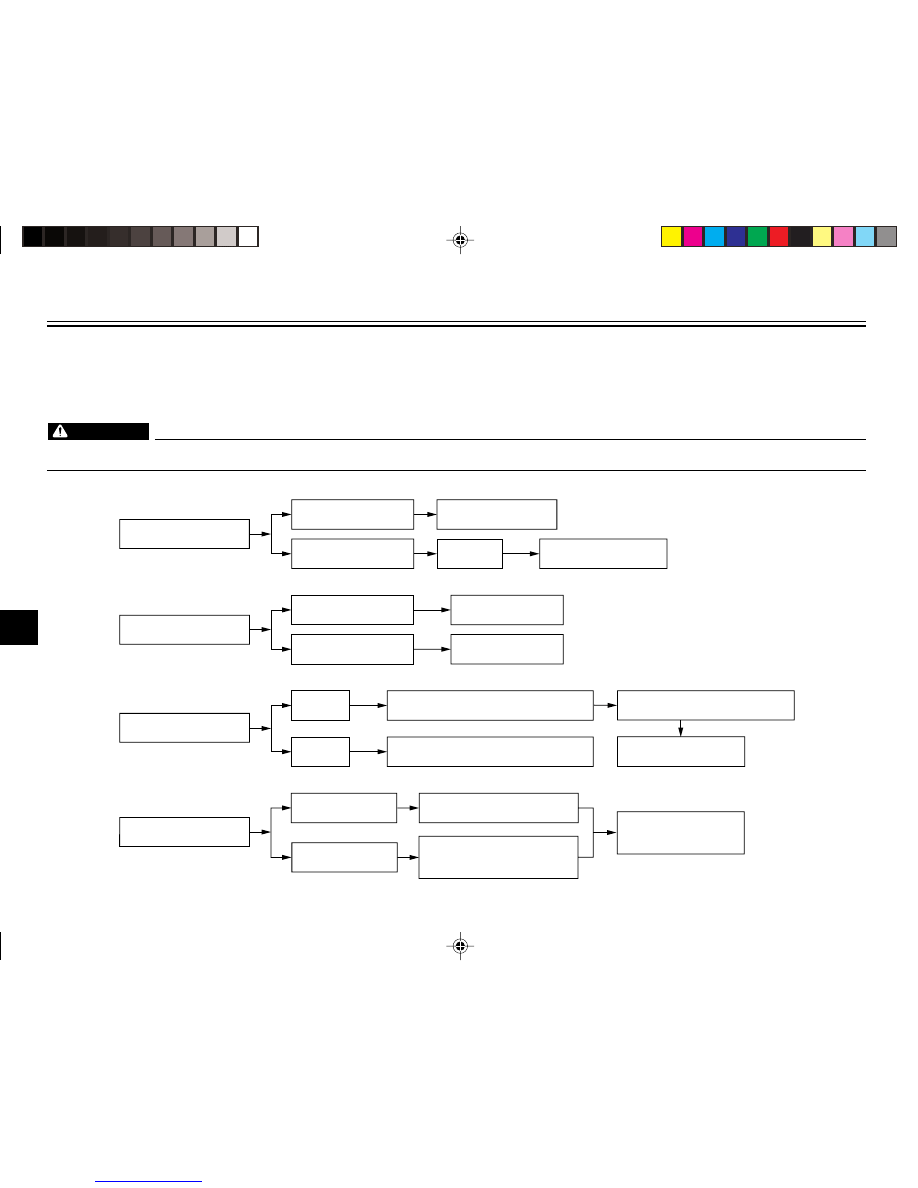
PERIODIC MAINTENANCE AND MINOR REPAIR
6
EAU03363
Troubleshooting charts
Starting problems or poor engine performance
EW000125
Keep away open flames and do not smoke while checking or working on the fuel system.
WARNING
Check the fuel level in
the fuel tank.
1. Fuel
There is enough fuel.
There is no fuel.
Check the compression.
Supply fuel.
Operate the electric starter.
2. Compression
There is compression.
There is no compression.
Check the ignition.
Have a Yamaha dealer
check the vehicle.
Remove the spark plugs
and check the electrodes.
3. Ignition
Wet
Dry
Wipe off with a dry cloth and correct the
spark plug gaps, or replace the spark plugs.
Have a Yamaha dealer check the vehicle.
The engine does not start.
Check the battery.
Open the throttle halfway and operate
the electric starter.
Operate the electric starter.
4. Battery
The engine turns over
quickly.
The engine turns over
slowly.
The battery is good.
Check the electrolyte and battery
lead connections, and charge the
battery if necessary.
The engine does not start.
Have a Yamaha dealer
check the vehicle.
The engine does not start.
Check the compressoin.
6-23
Ofrecido por www.electromanuales.com
manuals search engine
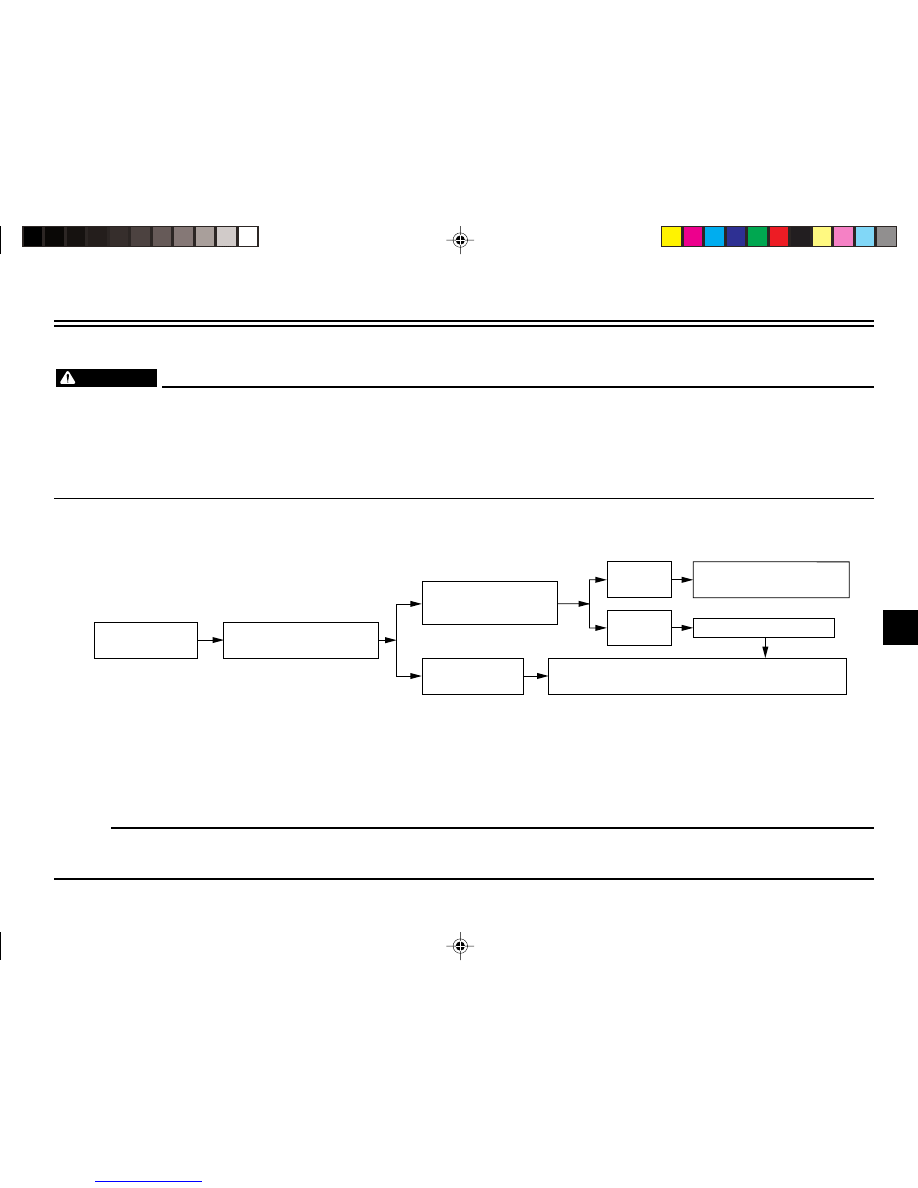
PERIODIC MAINTENANCE AND MINOR REPAIR
6
Engine overheating
EW000070
•
Do not remove the radiator cap when the engine and radiator are hot. Scalding hot fluid and steam may be
blown out under pressure, which could cause serious injury. Be sure to wait until the engine has cooled.
•
After removing the radiator cap retaining bolt, place a thick rag, like a towel, over the radiator cap, and then
slowly rotate the cap counterclockwise to the detent to allow any residual pressure to escape. When the hissing
sound has stopped, press down on the cap while turning it counterclockwise, and then remove the cap.
NOTE :
If coolant is not available, tap water can be temporarily used instead, provided that it is changed to the recommended
coolant as soon as possible.
WARNING
Wait until the
engine has cooled.
Check the coolant level in the
reservoir and radiator.
The coolant level
is OK.
The coolant level is low.
Check the cooling system
for leakage.
Have a Yamaha dealer check
and repair the cooling system.
Add coolant. (See NOTE.)
Start the engine. If the engine overheats again,
have a
Yamaha dealer check
and repair the cooling system.
There is
leakage.
There is
no leakage.
6-24
Ofrecido por www.electromanuales.com
manuals search engine
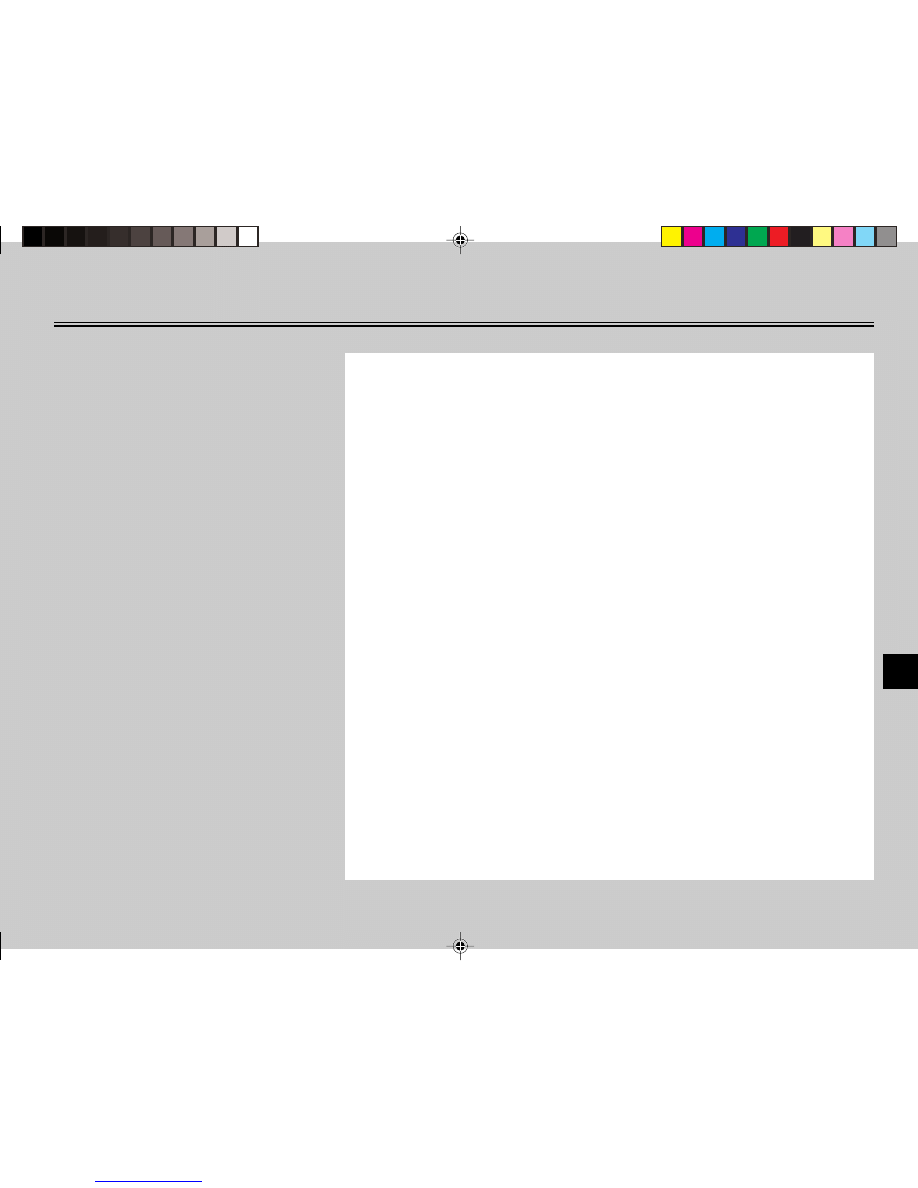
EAU03434
SCOOTER CARE AND STORAGE
Care .................................................................................................... 7-1
Storage ............................................................................................... 7-3
7
Ofrecido por www.electromanuales.com
manuals search engine
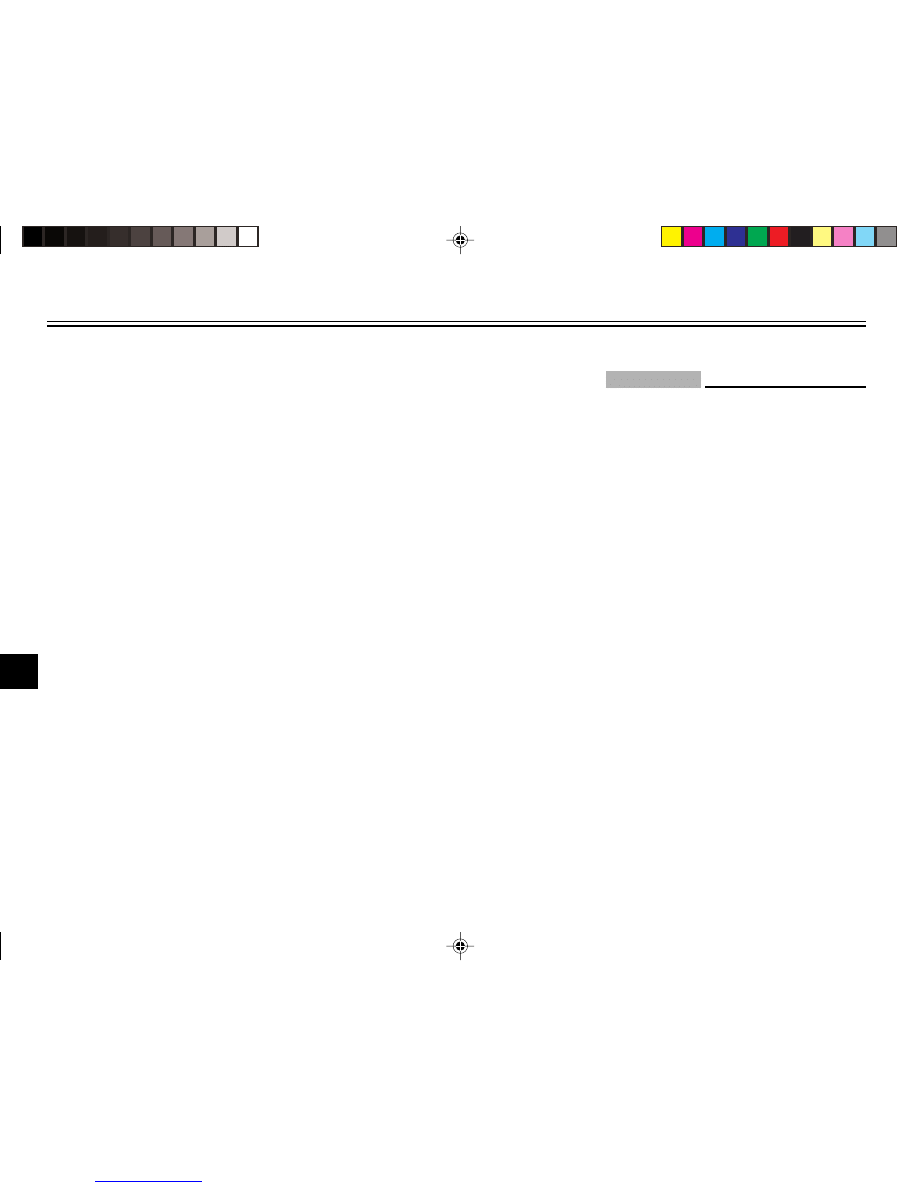
SCOOTER CARE AND STORAGE
7
Care
While the open design of a scooter
reveals the attractiveness of the
technology, it also makes it more
vulnerable. Rust and corrosion can
develop
even
if
high-quality
components are used. A rusty exhaust
pipe may go unnoticed on a car,
however, it detracts from the overall
appearance of a scooter. Frequent and
proper care does not only comply with
the terms of the warranty, but it will also
keep your scooter looking good, extend
its life and optimize its performance.
Before cleaning
1. Cover the muffler outlet with a
plastic bag after the engine has
cooled down.
2. Make sure that all caps and covers
as well as all electrical couplers
and connectors, including the
spark plug cap, are tightly
installed.
3. Remove extremely stubborn dirt,
like oil burnt onto the crankcase,
with a degreasing agent and a
brush, but never apply such
products onto seals, gaskets and
wheel axles. Always rinse the dirt
and degreaser off with water.
Cleaning
ECA00011
•
Avoid using strong acidic wheel
cleaners, especially on spoked
wheels. If such products are
used on hard-to-remove dirt, do
not leave the cleaner on the
affected area any longer than
instructed. Also, thoroughly
rinse the area off with water,
immediately dry it, and then
apply a corrosion protection
spray.
•
Improper cleaning can damage
windshields, cowlings, panels
and other plastic parts. Use
only a soft, clean cloth or
sponge with mild detergent and
water to clean plastic.
CAUTION:
7-1
Ofrecido por www.electromanuales.com
manuals search engine
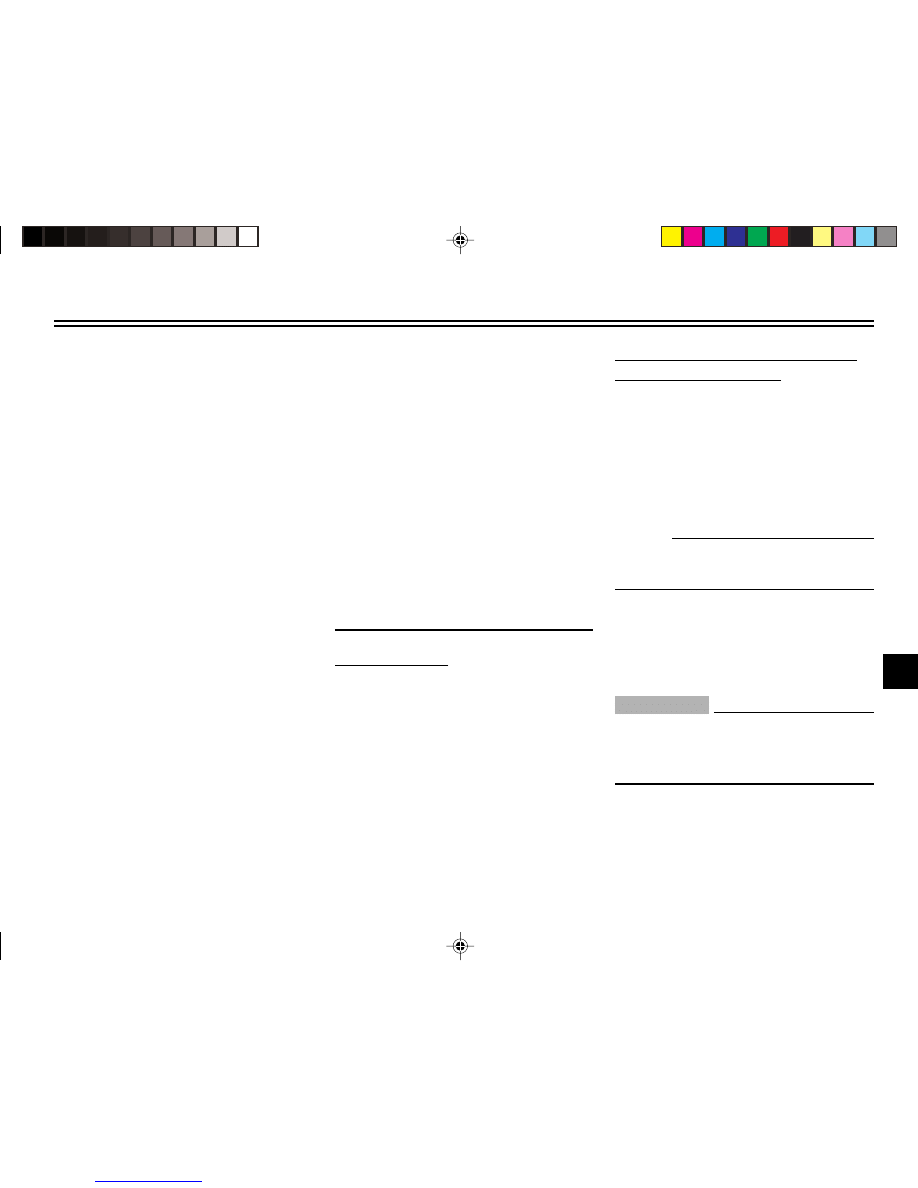
SCOOTER CARE AND STORAGE
7
•
Do not use any harsh chemical
products on plastic parts. Be
sure to avoid using cloths or
sponges which have been in
contact with strong or abrasive
cleaning products, solvent or
thinner, fuel (gasoline), rust
removers or inhibitors, brake
fluid, antifreeze or electrolyte.
•
Do not use high-pressure
washers or steam-jet cleaners
since they cause water
seepage and deterioration in
the following areas: seals (of
wheel and swingarm bearings,
fork and brakes), electric
components
(couplers,
connectors,
instruments,
switches and lights), breather
hoses and vents.
•
For scooters equipped with a
windshield: Do not use strong
cleaners or hard sponges as
they will cause dulling or
scratching. Some cleaning
compounds for plastic may
leave scratches on the
windshield. Test the product on
a small hidden part of the
windshield to make sure that it
does not leave any marks. If the
windshield is scratched, use a
quality plastic polishing
compound after washing.
After normal use
Remove dirt with warm water, a mild
detergent, and a soft, clean sponge,
and then rinse thoroughly with clean
water. Use a toothbrush or bottlebrush
for hard-to-reach areas. Stubborn dirt
and insects will come off more easily if
the area is covered with a wet cloth for
a few minutes before cleaning.
After riding in the rain, near the sea
or on salt-sprayed roads
Since sea salt or salt sprayed on the
roads during winter are extremely cor-
rosive in combination with water, carry
out the following steps after each ride
in the rain, near the sea or on salt-
sprayed roads.
NOTE :
Salt sprayed on roads in the winter may
remain well into spring.
1. Clean the scooter with cold water
and a mild detergent after the
engine has cooled down.
ECA00012
Do not use warm water since it
increases the corrosive action of the
salt.
2. Apply a corrosion protection spray
on all metal, including chrome-
and nickel-plated, surfaces to
prevent corrosion.
CAUTION:
7-2
Ofrecido por www.electromanuales.com
manuals search engine
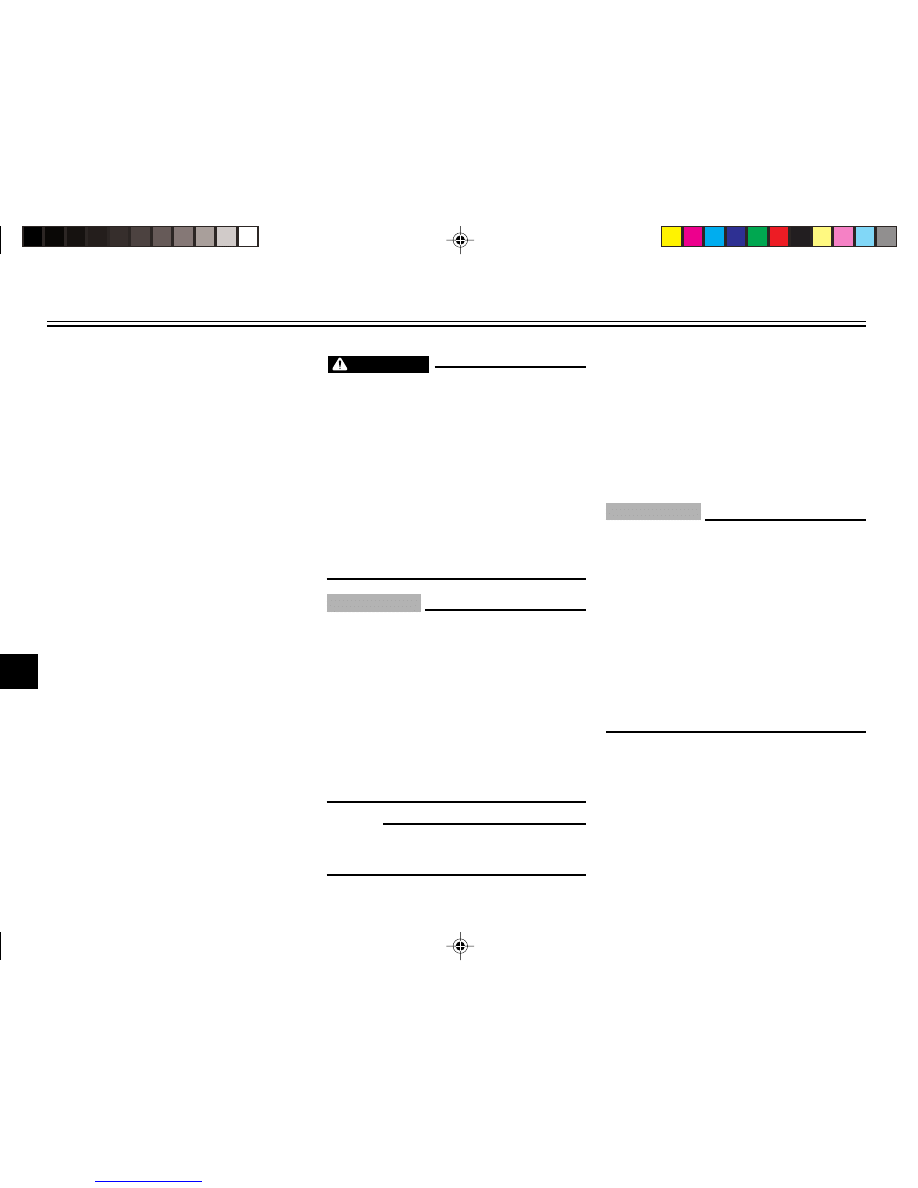
SCOOTER CARE AND STORAGE
7
After cleaning
1. Dry the scooter with a chamois or
an absorbing cloth.
2. Use a chrome polish to shine
chrome, aluminum and stainless-
steel parts, including the exhaust
system. (Even the thermally
induced discoloring of stainless-
steel exhaust systems can be
removed through polishing.)
3. To prevent corrosion, it is
recommended to apply a corro-
sion protection spray on all metal,
including chrome- and nickel-
plated, surfaces.
4. Use spray oil as a universal
cleaner to remove any remaining
dirt.
5. Touch up minor paint damage
caused by stones, etc.
6. Wax all painted surfaces.
7. Let the scooter dry completely
before storing or covering it.
EWA00002
•
Make sure that there is no oil or
wax on the brakes or tires. If
necessary, clean the brake discs
and brake linings with a regular
brake disc cleaner or acetone,
and wash the tires with warm
water and a mild detergent.
•
Before operating the scooter
test its braking performance and
cornering behavior.
ECA00013
•
Apply spray oil and wax sparingly
and make sure to wipe off any
excess.
•
Never apply oil or wax to any
rubber and plastic parts, but treat
them with a suitable care product.
•
Avoid using abrasive polishing
compounds as they will wear
away the paint.
NOTE :
Consult a Yamaha dealer for advice on
what products to use.
Storage
Short-term
Always store your scooter in a cool, dry
place and, if necessary, protect it
against dust with a porous cover.
ECA00015
•
Storing the scooter in a poorly
ventilated room or covering it
with a tarp, while it is still wet,
will allow water and humidity to
seep in and cause rust.
•
To prevent corrosion, avoid
damp cellars, stables (because
of the presence of ammonia)
and areas where strong
chemicals are stored.
WARNING
CAUTION:
CAUTION:
7-3
Ofrecido por www.electromanuales.com
manuals search engine
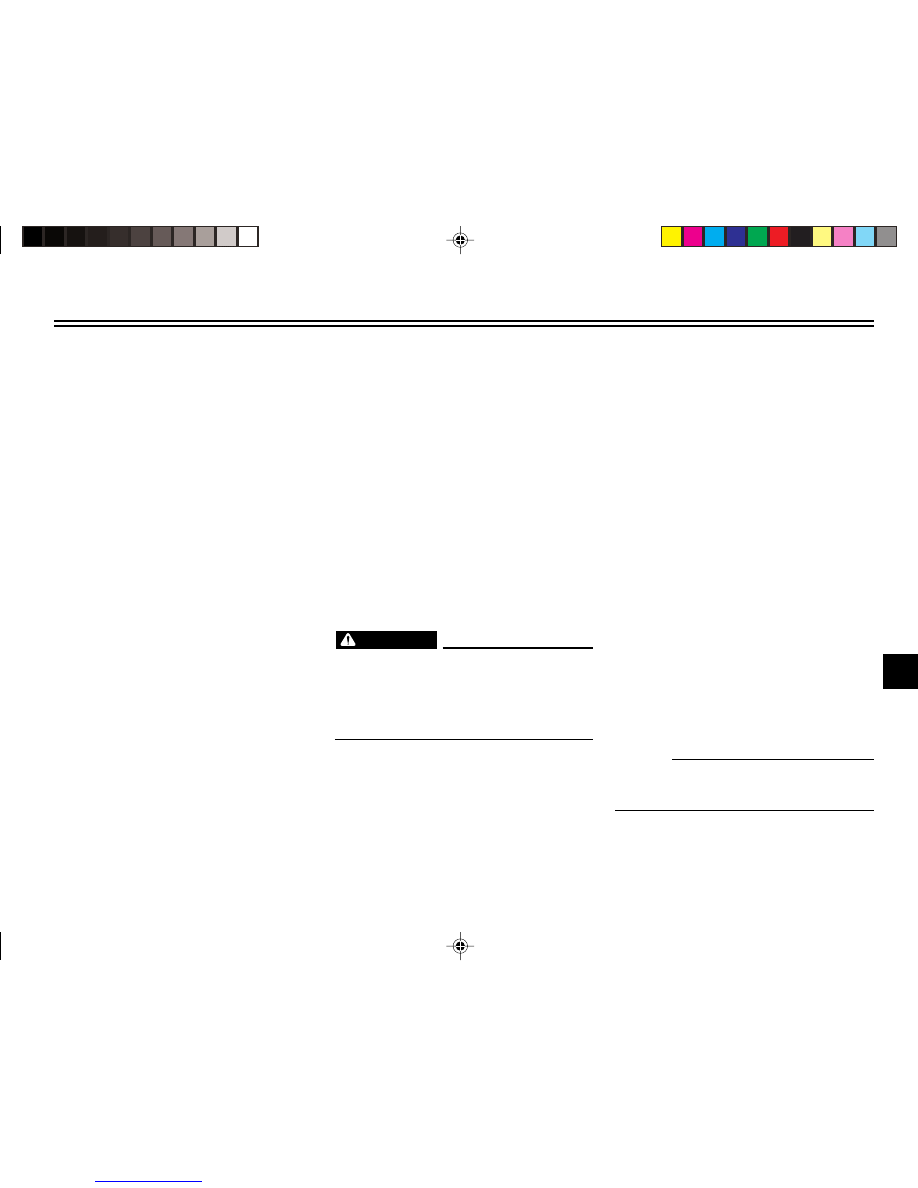
SCOOTER CARE AND STORAGE
7
Long-term
Before storing your scooter for several
months:
1. Follow all the instructions in the
"Care" section of this chapter.
2. Drain the carburetor float chamber
by loosening the drain bolt; this will
prevent fuel deposits from building
up. Pour the drained fuel into the fuel
tank.
3. Fill up the fuel tank and add fuel
stabilizer (if available) to prevent the
fuel tank from rusting and the fuel
from deteriorating.
4. Perform the following steps to protect
the cylinder, piston rings, etc. from
corrosion.
a. Remove the spark plug cap
and spark plug.
b. Pour a teaspoonful of engine oil
into the spark plug bore.
c. Install the spark plug cap onto
the spark plug, and then place
the spark plug on the cylinder
head so that the electrodes are
grounded. (This will limit
sparking during the next step.)
d. Turn the engine over several
times with the starter. (This will
coat the cylinder wall with oil.)
e. Remove the spark plug cap
from the spark plug, and then
install the spark plug and the
spark plug cap.
EWA00003
To prevent damage or injury from
sparking, make sure to ground the
spark plug electrodes while turning
the engine over.
5. Lubricate all control cables and
the pivoting points of all levers and
pedals as well as of the sidestand/
centerstand.
6. Check and, if necessary, correct
the tire air pressure, and then lift
the scooter so that both of its
wheels are off the ground.
Alternatively, turn the wheels a
little every month in order to
prevent the tires from becoming
degraded in one spot.
7. Cover the muffler outlet with a
plastic bag to prevent moisture
from entering it.
8. Remove the battery and fully
charge it. Store it in a cool, dry
place and charge it once a month.
Do not store the battery in an
excessively cold or warm place
(less than 0
°
C or more than 30
°
C). For more information on
storing the battery, see page 6-19.
NOTE :
Make any necessary repairs before
storing the scooter.
WARNING
7-4
Ofrecido por www.electromanuales.com
manuals search engine
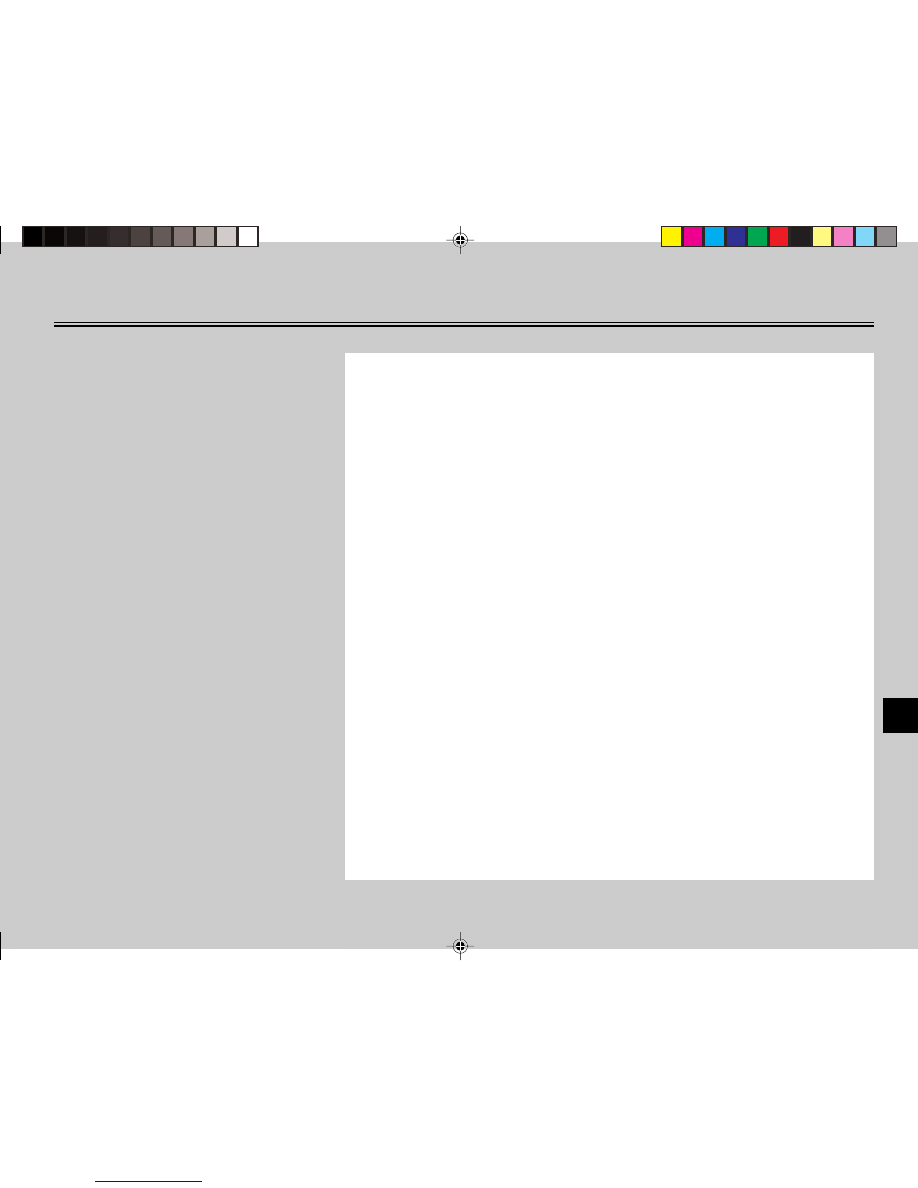
EAU01038
SPECIFICATIONS
Specifications ...................................................................................... 8-1
Conversion table ................................................................................. 8-4
8
Ofrecido por www.electromanuales.com
manuals search engine
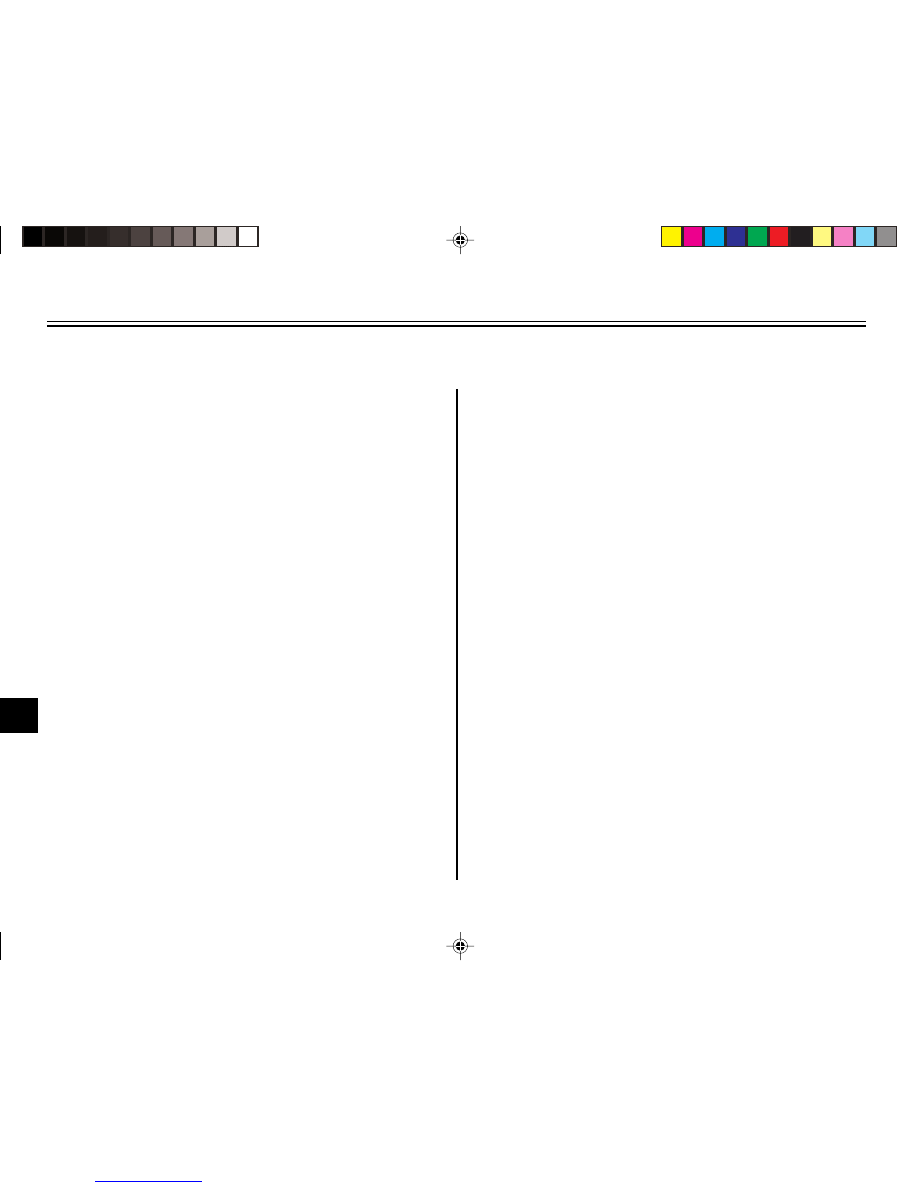
SPECIFICATIONS
8
Specifications
Model
YQ50
Dimensions:
Overall length
1.743 mm
Overall width
690 mm
Overall height
1.170 mm
Seat height
828 mm
Wheelbase
1.256 mm
Minimum ground clearance
185 mm
Minimum turning radius
1.800 mm
Basic weight:
97 kg
(with oil and full fuel tank)
Engine:
Engine type
Liquid cooled, 2 stroke
Cylinder arrangement
Single cylinder, horizontal
Displacement
49.2 cc
Bore x stroke
40.0 x 39.2
Compression ratio
7.44:1
Starting system
Electric and kick starter
Lubrication system
Separate lubrication (Autolube)
Engine oil:
Type
Yamalube 2
or 2 stroke engine oil
Recommended engine oil
Jaso FC
classification
or ISO EG-C, EG-D
Capacity
1.3 L
Final transmission oil:
Type
SAE 10W30 type SE
Quantity
0.13L
Cooling system capacity:
1.2L
(total amount)
Air filter type:
Wet type element
Fuel:
Recommended fuel
Regular unleaded gasoline
(RON 91 mini)
Fuel tank capacity
7L
Carburetor:
Manufacturer
DELL'ORTO
Model/quantity
PHBN 12HS x1
Spark plug:
Manufacturer/Model
NGK / BR8HS
Spark plug gap
0.5—0.7 mm
Clutch type:
Dry, centrifugal automatic
Transmission:
Primary reduction system
Helical gear
Primary reduction ratio
52/13 (4.000)
Secondary reduction system
Spur gear
Secondary reduction ratio
43/14 (3.071)
Transmission type
V-belt automatic
Operation
Centrifugal automatic type
8-1
Ofrecido por www.electromanuales.com
manuals search engine
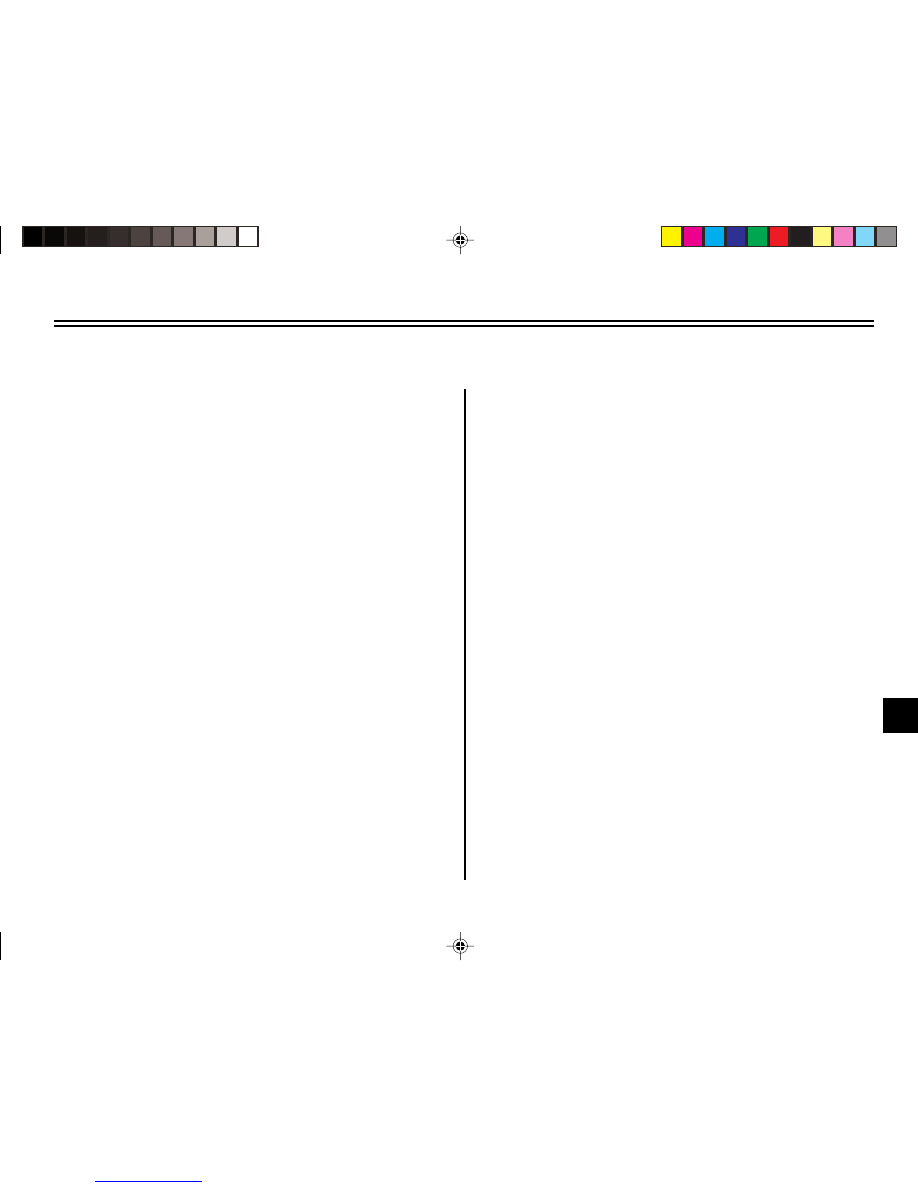
SPECIFICATIONS
8
Chassis:
Frame type
Steel tube underbone
Caster angle
27
°
Trail
89.4 mm
Tires:
Front:
Type
Tubeless
Size
130/60-13 53L TL
Manufacturer/ Model
PIRELLI / SL36
PIRELLI / EVO 21
MICHELIN / BOPPER
Rear:
Type
Tubeless
Size
140/60-13 57L TL
anufacturer/ Model
PIRELLI / SL36
PIRELLI / EVO 22
MICHELIN / BOPPER
Maximum load*
180 kg
Tir air pressure
(mesured on cold tires):
Up to 90 kg
Front
150 kpa
Rear
150 kpa
90kg—maximum*
Front
150 kpa
Rear
170 kpa
* Total weight of rider, passenger, cargo and accessories
Wheels:
Front
Type
Cast wheel
Size
13 X MT 3.00
Rear
Type
Cast wheel
Size
13 X MT 3.50
Brakes:
Front
Type
Single disc brake
Operation
Right hand operation
Type brake fluid
DOT 3 or DOT 4
Rear
Type
Single disc brake
Operation
Left hand operation
Type brake fluid
DOT 3 or DOT 4
Suspension:
Front suspension
Telescopic fork
Rear suspension
Unit swing
Shock absorber:
Front fork type
Coil spring/oil damper
Rear shock absorber
Coil spring/oil damper
assembly type
or Coil spring/Gas-oil damper
(Depends on model)
Wheel travel:
Front wheel travel
80 mm
Rear wheel travel
72 mm
8-2
Ofrecido por www.electromanuales.com
manuals search engine
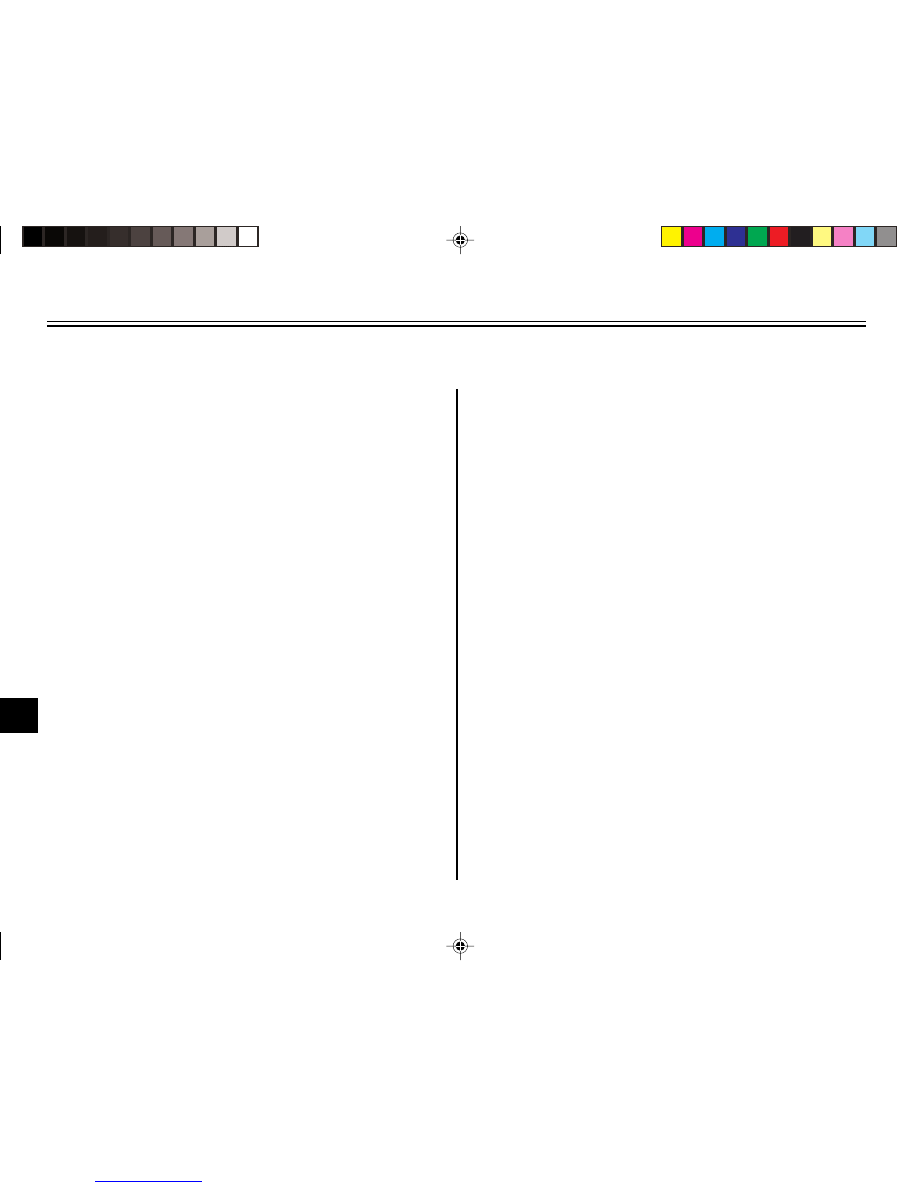
SPECIFICATIONS
8
Electrical:
Ignition system type
C.D.I
Charging system
Flywheel magneto
Battery
Model
GM4-3B, YB4L-B, FB4L-B
Voltage/capacity
12 V / 4 Ah
Headlight type:
Bulb
Bulbs (voltage/wattage x quantity):
Headlight
12V, 35W/35Wx1
Brake/brake light
12V, 5W/21Wx1
Turn signal light
Front
12V, 10Wx2
Rear
12V, 10Wx2
Meter lights
12V, 1,2Wx2
High beam indicator light
12V, 2Wx1
Turn signal indicator light
12V, 2Wx1
Oil warning light
12V, 2Wx1
Temperature indicator light
12V, 1,2Wx1
Fuses:
Main fuse
7.5 A
8-3
Ofrecido por www.electromanuales.com
manuals search engine
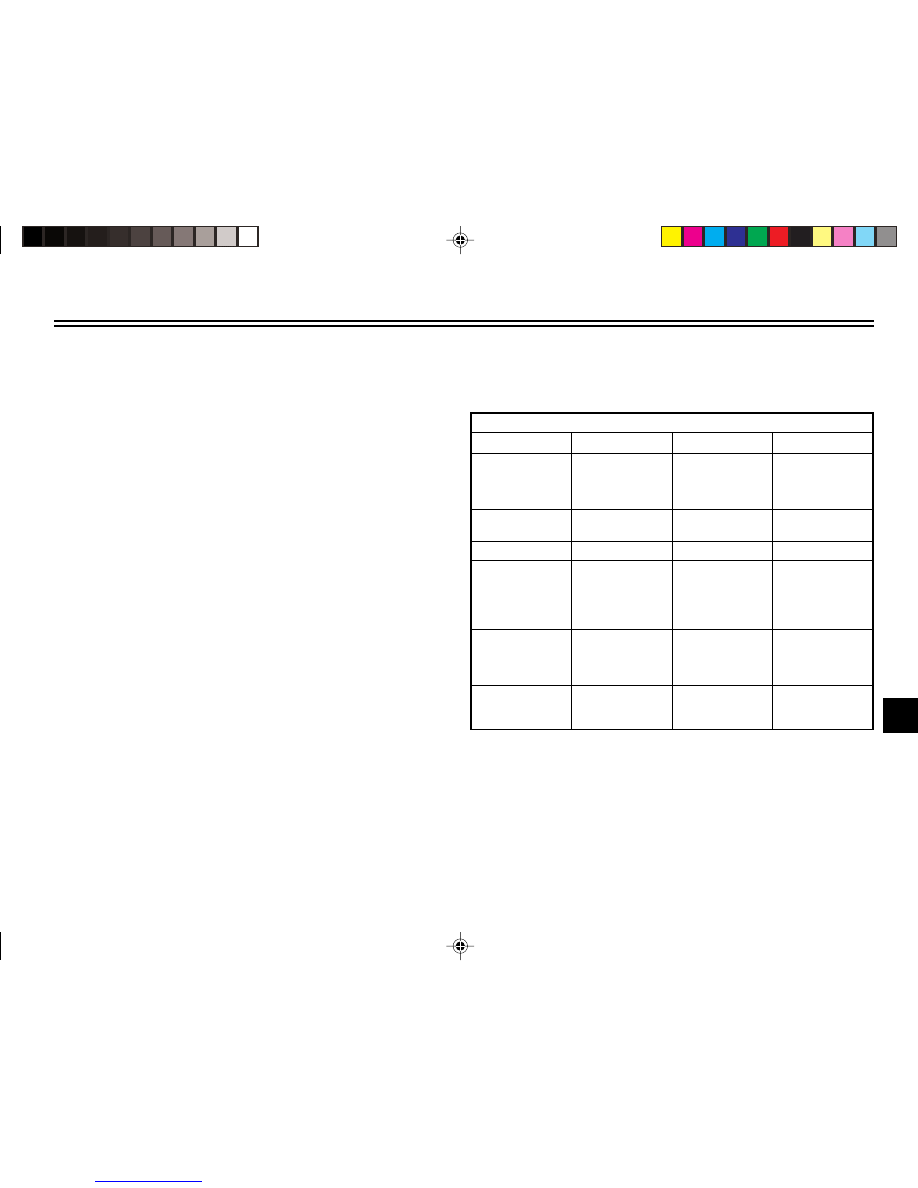
SPECIFICATIONS
8
EAU04513
Conversion table
All specification data in this manual are listed in SI and
METRIC UNITS.
Use this table to convert METRIC unit values to IMPERIAL
unit values.
Example:
METRIC VALUE
CONVERSION
FACTOR
IMPERIAL VALUE
2 mm
0.03937
=
0.08 in
Conversion table
METRIC SYSTEM TO IMPERIAL SYSTEM
Metric unit
Conversion factor
Imperial unit
Torque
m•kgf
m•kgf
cm•kgf
cm•kgf
7.233
86.794
0.0723
0.8679
ft•lbf
in•lbf
ft•lbf
in•lbf
Weight
kg
g
2.205
0.03527
lb
oz
Speed
km/h
0.6214
mi/h
Distance
km
m
m
cm
mm
0.6214
3.281
1.094
0.3937
0.03937
mi
ft
yd
in
in
Volume,
Capacity
cc (cm
3
)
cc (cm
3
)
L (liter)
L (liter)
0.03527
0.06102
0.8799
0.2199
oz (IMP liq.)
cu•in
qt (IMP liq.)
gal (IMP liq.)
Miscellaneous
kg/mm
kgf/cm
2
C
55.997
14.2234
1.8 + 32
lb/in
psi (lbf/in
2
)
F
8-4
Ofrecido por www.electromanuales.com
manuals search engine
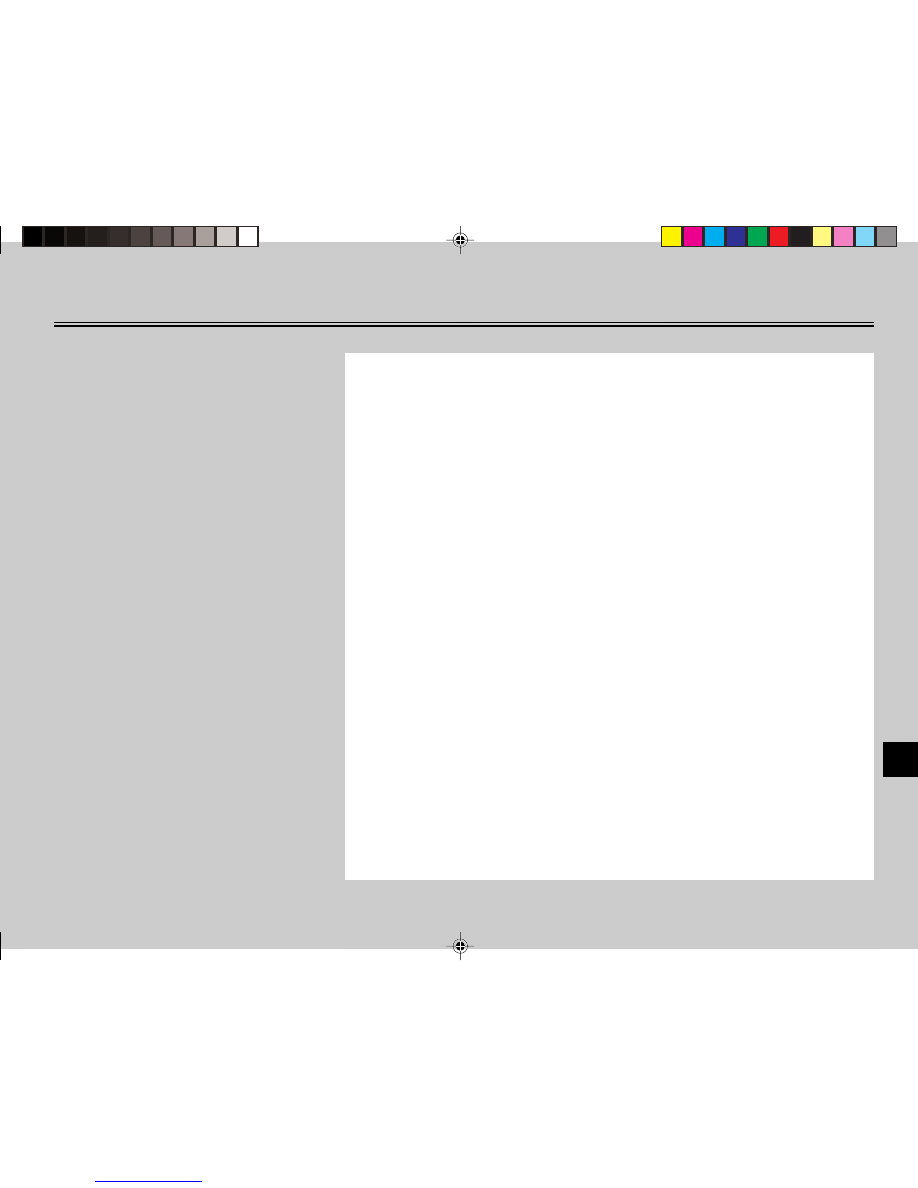
9
EAU01039
CONSUMER INFORMATION
Identification numbers ......................................................................... 9-1
Key identification number .................................................................... 9-1
Vehicle identification number .............................................................. 9-1
Model label .......................................................................................... 9-2
Ofrecido por www.electromanuales.com
manuals search engine
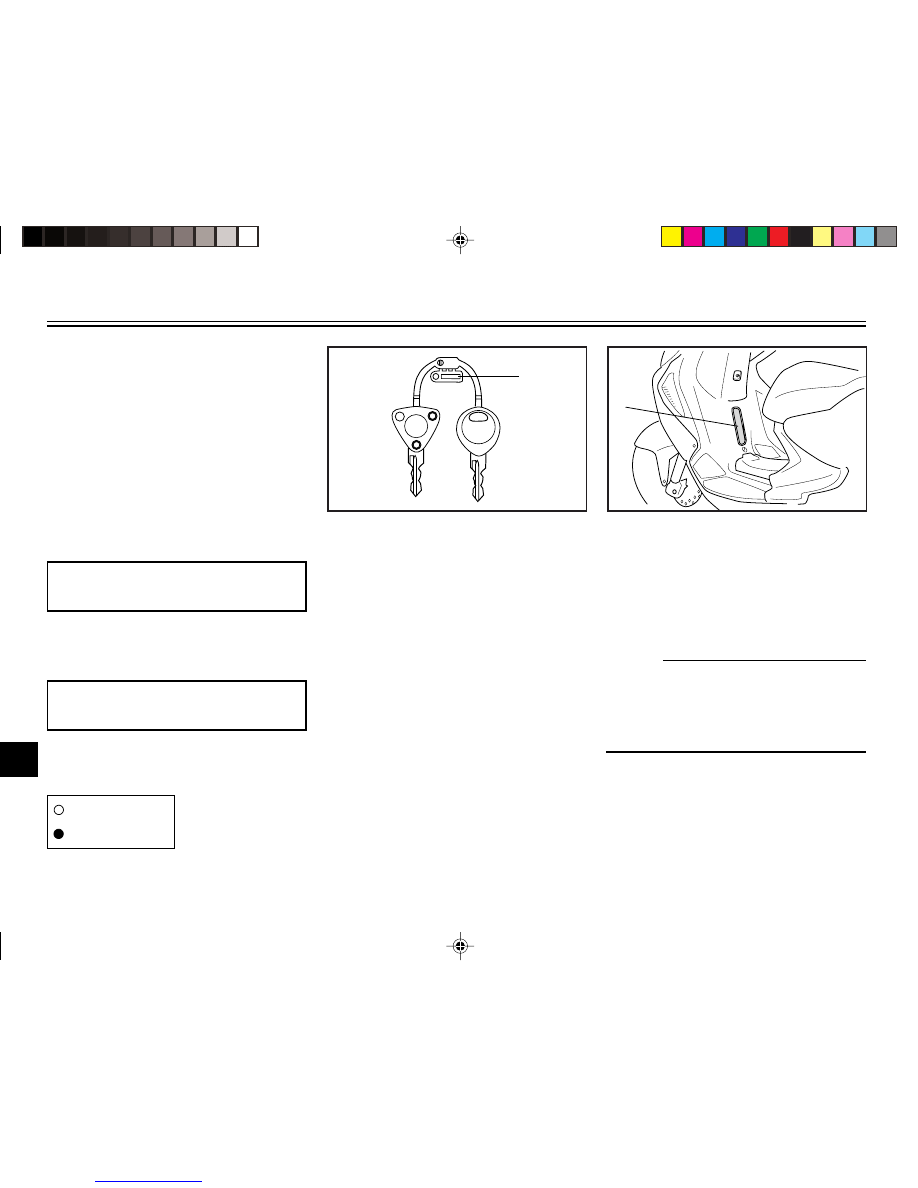
CONSUMER INFORMATION
9
1
ZAUM0070
1
ZAUM0287M
1. Key identification number
EAU01041
Key identification number
The key identification number is
stamped into the key tag.
Record this number in the space
provided and use it for reference when
ordering a new key.
EAU01044
Vehicle identification number
The vehicle identification number is
stamped into the frame.
NOTE :
The vehicle identification number is
used to identify your scooter and may
be used to register your scooter with
the licensing authority in your area.
1. Vehicle identification number
9-1
EAU02944
Identification numbers
Record the key identification number,
vehicle identification number and model
label information in the spaces provided
below for assistance when ordering
spare parts from a Yamaha dealer or
for reference in case the vehicle is
stolen.
1. KEY IDENTIFICATION NUMBER:
2. VEHICLE IDENTIFICATION
NUMBER:
3. MODEL LABEL INFORMATION:
Ofrecido por www.electromanuales.com
manuals search engine
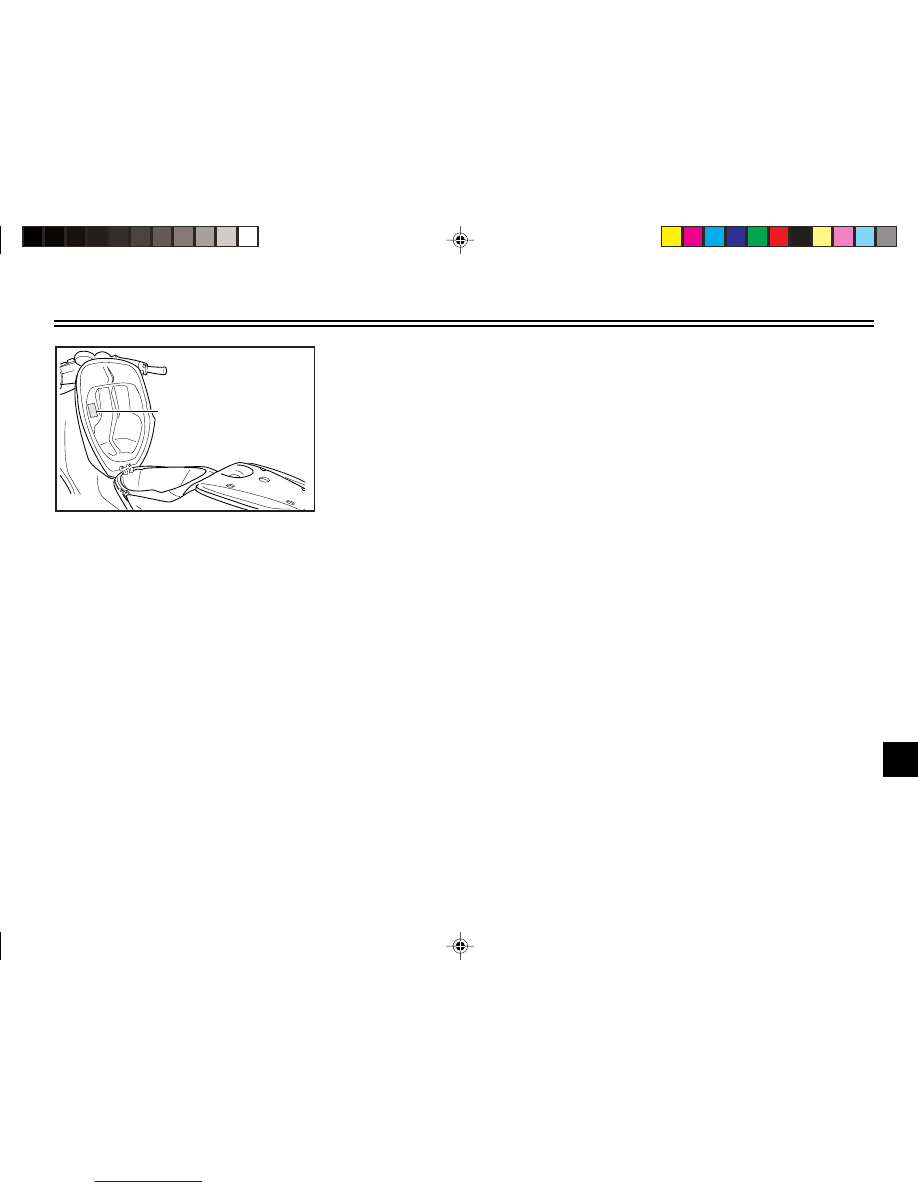
CONSUMER INFORMATION
9
9-2
1
ZAUM0295
1. Model label
EAU01278
Model label
The model label is affixed to the bottom
of the seat. (See page 3-9 for seat
opening procedures.) Record the infor-
mation on this label in the space
provided. This information will be
needed when ordering spare parts from
a Yamaha dealer.
Ofrecido por www.electromanuales.com
manuals search engine
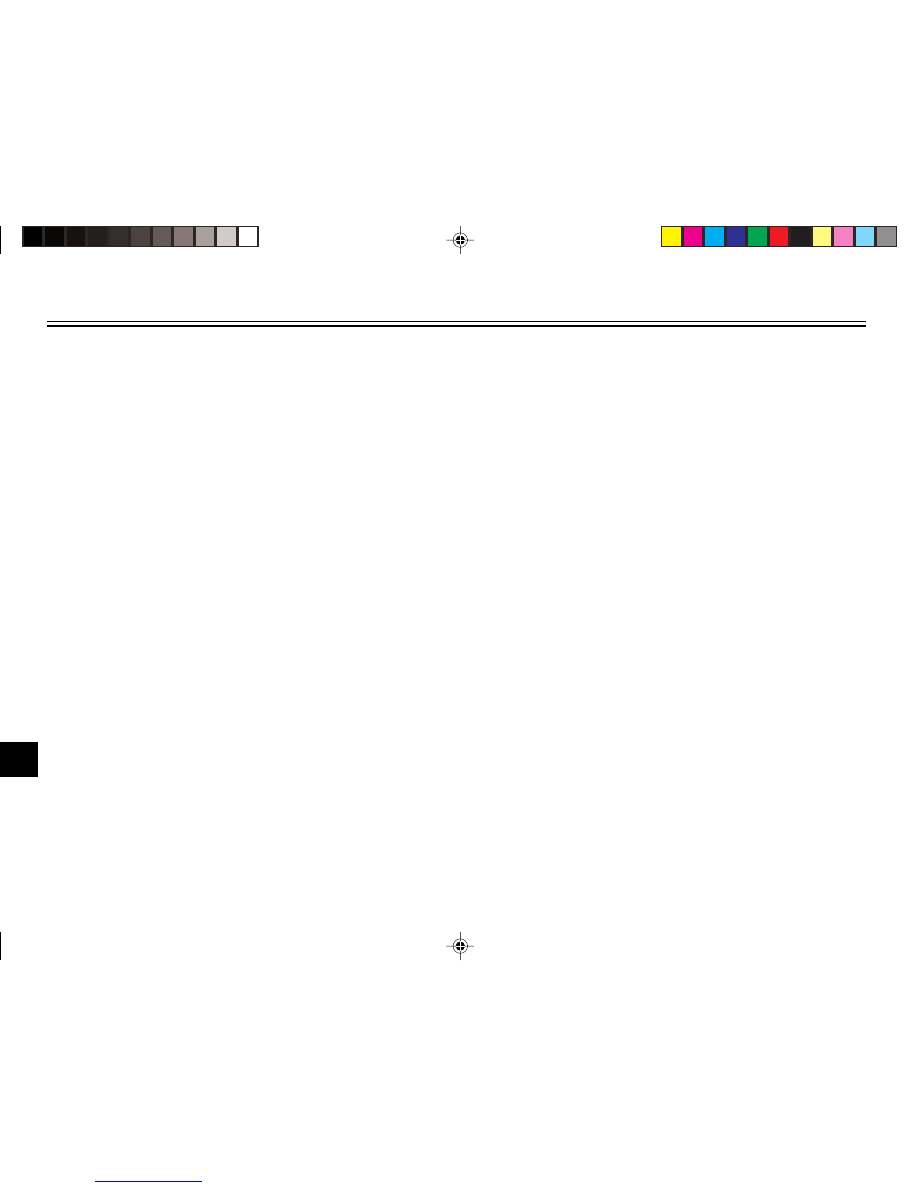
CONSUMER INFORMATION
9
EAU01052
YOU ARE HEREBY REMINDED THAT MODIFICATIONS TO THE ENGINE OR THE POWER OF THE SCOOTER ARE
FORBIDDEN BY LAW.
ANY CHANGES FOR THE PURPOSE OF RAISING THE TOP SPEED OF THE VEHICLE OR BOOSTING THE POWER
OF THE ENGINE WOULD LEAD TO THE SCOOTER BEING CLASSED AS A MOTORCYCLE.
THIS WOULD REQUIRE THE OWNER:
•
TO OBTAIN A NEW TYPE APPROVAL
•
TO OBTAIN A MOTORCYCLE REGISTRATION LICENSE
•
TO HOLD A DRIVING LICENSE
IN ADDITION, SUCH CHANGES WOULD LEAD TO THE INVALIDATION OF TIE INSURANCE COVER, SINCE
INSURANCE POLICIES EXPLICITLY FORBID TECHNICAL CHANGES WHICH HAVE THE PURPOSE OF BOOSTING
THE PERFORMANCE.
FOR THE REASONS SET OUT ABOVE, A BREACH OF THE PROHIBITION TO TAMPER WITH THE ENGINE IS
PUNISHED BY LAW BY APPROPRIATE FINES INCLUDING THE CONFISCATION OF THE VEHICLE.
FINES ARE ALSO INFLICTED, ACCORDING TO CIRCUMSTANCES, FOR DRIVING WITHOUT A HELMET AND A
LICENSE PLATE, AS WELL AS FOR TAX EVASION (OMITTING TO PAY OWNERSHIP TAX).
DRIVING WITHOUT A DRIVING LICENSE IS A CRIMINAL OFFENSE.
9-3
Ofrecido por www.electromanuales.com
manuals search engine

PRINTED IN FRANCE
2002.07
(E)
YAMAHA MOTOR CO., LTD.
Ofrecido por www.electromanuales.com
manuals search engine
Wyszukiwarka
Podobne podstrony:
instrukcja obsługi yamaha virago xv 750
Lark Free Bird 50 2 instrukcja obsługi po polsku
Instrukcja obsługi Przenośna podstawka do ładowania bezprzewodowego Nokia DC 50
Instrukcja obsługi Ferguson Ariva T65 PL v1 50
INSTRUKCJA OBSŁUGI VOLVO V 50 2007
Instrukcja obsługi Yamaha HTR 5930
instrukcja obslugi wag b 05 b 043 b 50 4 pl
Instrukcja obsługi zmywarki Hoover HEDS 50 86S
Instrukcja obsługi lark 50 4BT
Piec LSL UB Instrukcja obsługi
Instrukcja obslugi Uchwyt samoc Nieznany
INSTRUKCJA OBSŁUGI DEKODER SAGEM ISD 4285 PL
Instrukcja obsługi interfejs KKL OPEL, BMW, VAG
Instrukcja obsługi Farymann 15D 18D
Instrukcja obslugi wymiennikow CB alfa laval
Instrukcja obslugi klimatyzacji Vectra B
więcej podobnych podstron








